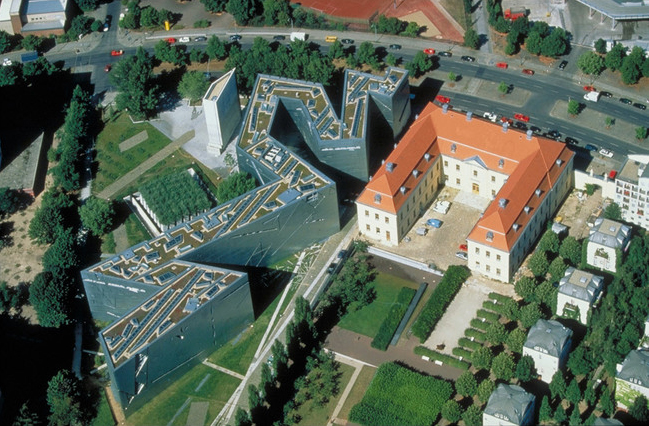Please email your comments & questions to geovisual at comcast.net. Thank you.


| 99 Peace Monuments in Berlin, Potsdam & Brandenburg
(Excluding Remainer of Germany) |
Click here for peace monuments in the remainder of Germany. Click here for peace monuments in Austria.
Click here for musuems & monuments related to the Holocaust.
Click here for "Sites of Memory: Markers, Memorials, Monuments & Cemeteries" by Mark R. Hatlie, Tübingen (Germany).
See the end of this webpage for a note about mahnmal & denkmal.
Right click image to enlarge / Zum Vergrößern auf das Bild klicken.
 
 |  1672 - Alter Jüdischer Friedhof / Old Jewish Cemetery, Gedenkstätte Große Hamburger Straße, Scheunenviertel, Berlin (Germany). "Declared full in 1827 (after which Jews were buried in Schonhauser Allee & Herbert-Baum-Strasse), destroyed by Nazis in 1943 & turned into a park in 1945. Embedded in the original wall is a handful of Baroque masebas / tombstones. A maseba on the grave of philosopher Moses Mendelssohn [1729-1786] was erected in 1990 by members of the Jewish community." /// Nearby (at #27) is a Jewish school founded by Mendelssohn in 1778, rebuilt in 1906 & reopened in 1993. /// Skulptur "Jüdische Opfer des Faschismus / Jewish Victims of Fascism" (qv) was added in 1985. 1672 - Alter Jüdischer Friedhof / Old Jewish Cemetery, Gedenkstätte Große Hamburger Straße, Scheunenviertel, Berlin (Germany). "Declared full in 1827 (after which Jews were buried in Schonhauser Allee & Herbert-Baum-Strasse), destroyed by Nazis in 1943 & turned into a park in 1945. Embedded in the original wall is a handful of Baroque masebas / tombstones. A maseba on the grave of philosopher Moses Mendelssohn [1729-1786] was erected in 1990 by members of the Jewish community." /// Nearby (at #27) is a Jewish school founded by Mendelssohn in 1778, rebuilt in 1906 & reopened in 1993. /// Skulptur "Jüdische Opfer des Faschismus / Jewish Victims of Fascism" (qv) was added in 1985. 
|
 
![]()
|    1793 - "Goddess of Peace," Quadriga, Brandenburger Tor / Brandenburg Gate, Berlin (Germany). Eirene or Irene. "Interpretation changed after the German victory over France in 1814 when the woman became Victoria, the goddess of Victory, by adding a Prussian eagle on an iron cross to her ensemble. Changed again to a symbol of the Third Reich when the Nazis reached power..." 1793 - "Goddess of Peace," Quadriga, Brandenburger Tor / Brandenburg Gate, Berlin (Germany). Eirene or Irene. "Interpretation changed after the German victory over France in 1814 when the woman became Victoria, the goddess of Victory, by adding a Prussian eagle on an iron cross to her ensemble. Changed again to a symbol of the Third Reich when the Nazis reached power..."
| 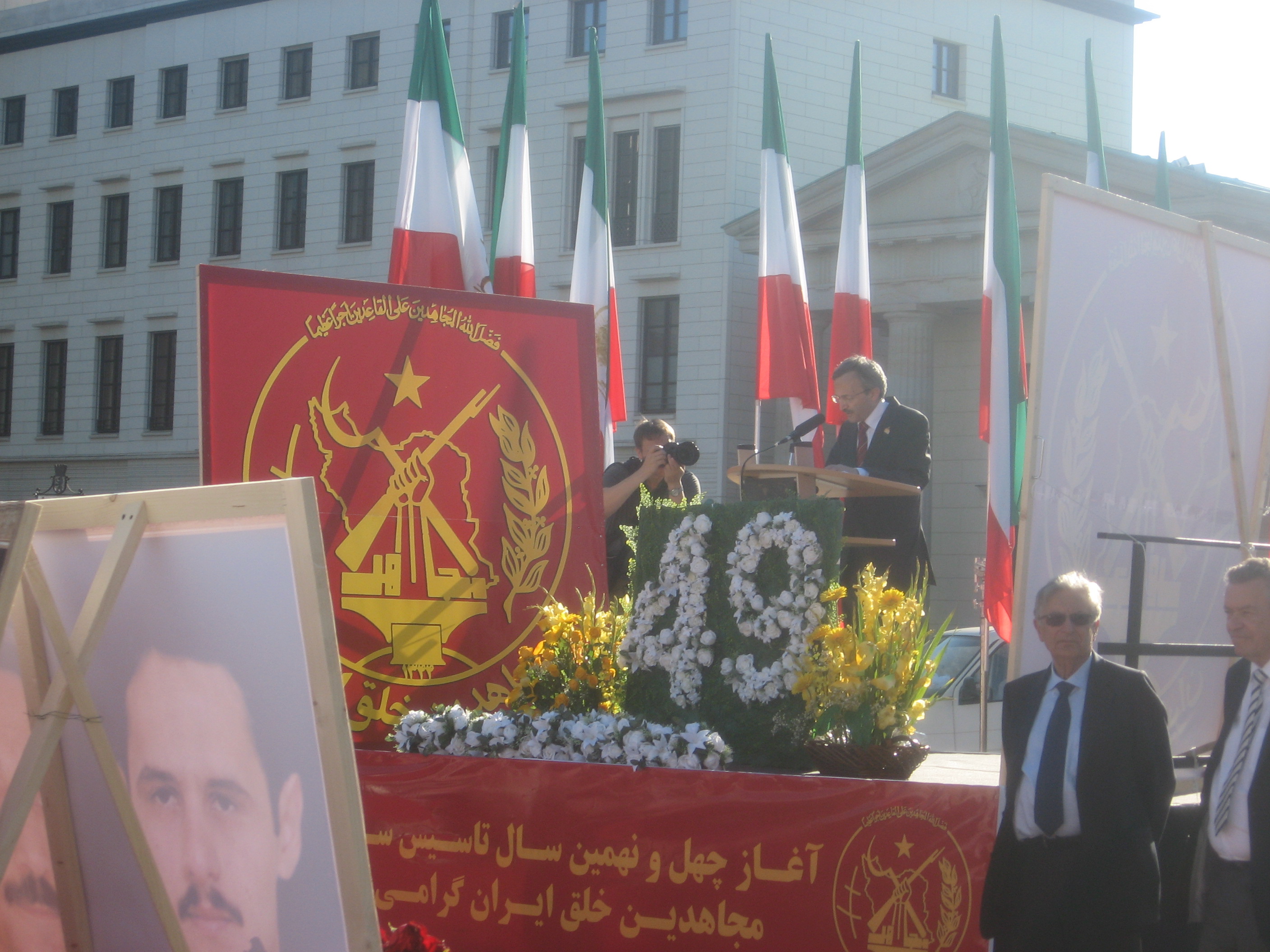 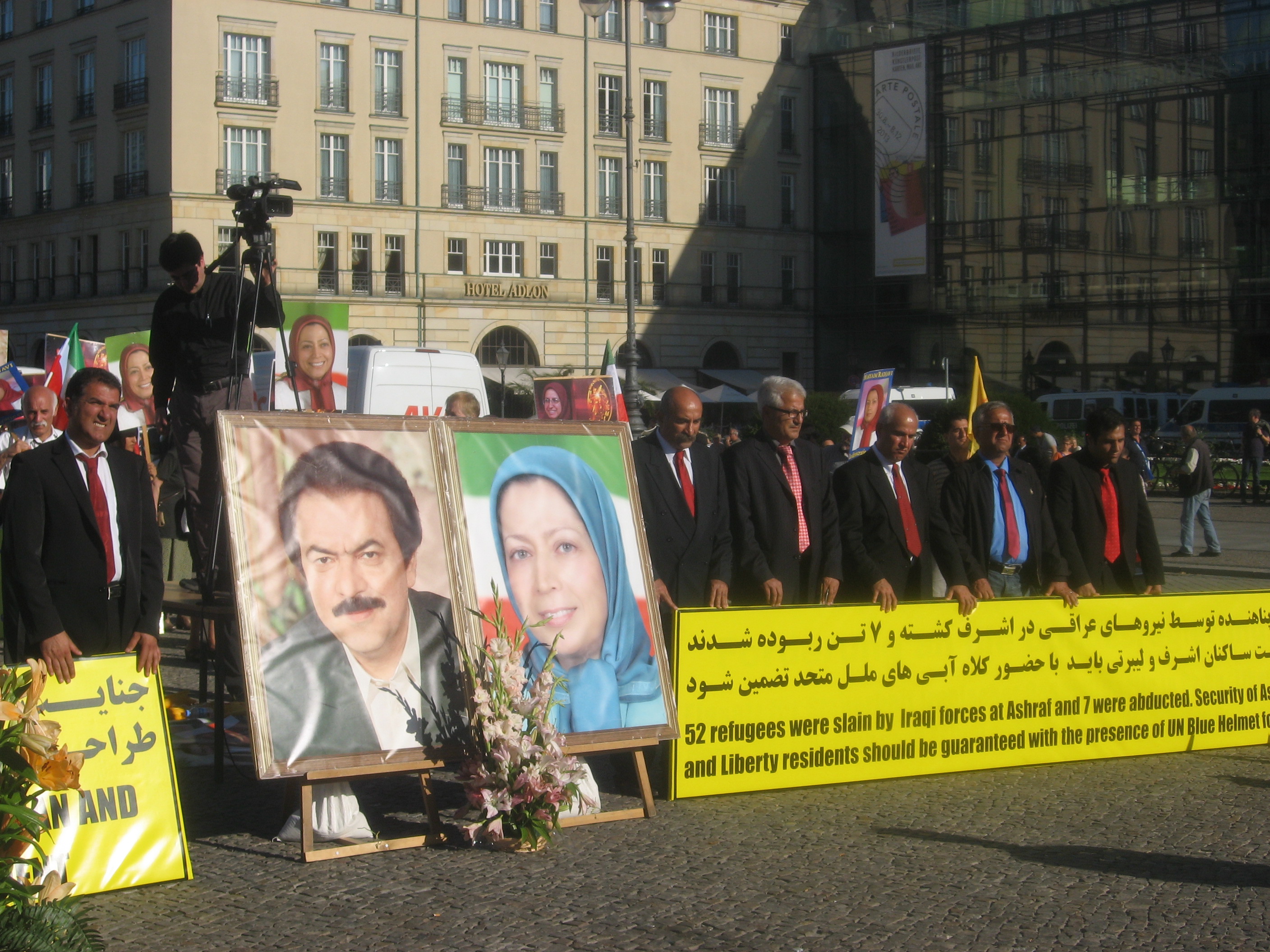 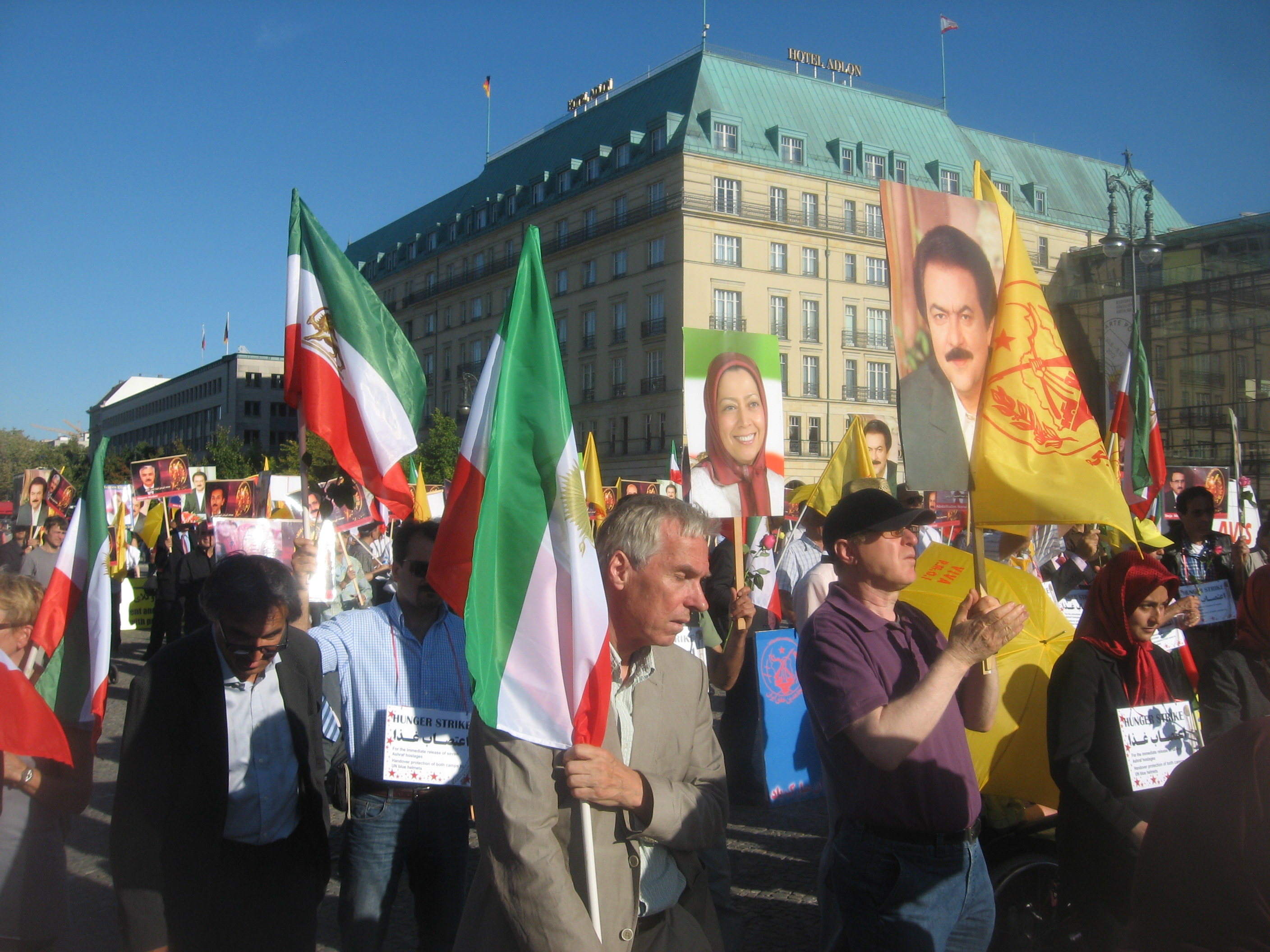
![]()
|  September 7, 2013 - Ashraf Hunger Strike, Brandenberger Tor, Berlin (Germany). "Hundreds rally & march in Berlin's inner city to protest against a recent massacre allegedly by Iraqi forces at Camp Ashraf." /// "On Sept. 1, 2013, 52 members of MEK were massacred at Camp Ashraf. In a statement, U.N. Secretary General Ban Ki-moon deplored 'the tragic events at Camp Ashraf' & said Baghdad should 'promptly investigate the incident & disclose the findings.'" All 3 photos by EWL 7 Sept 2013. September 7, 2013 - Ashraf Hunger Strike, Brandenberger Tor, Berlin (Germany). "Hundreds rally & march in Berlin's inner city to protest against a recent massacre allegedly by Iraqi forces at Camp Ashraf." /// "On Sept. 1, 2013, 52 members of MEK were massacred at Camp Ashraf. In a statement, U.N. Secretary General Ban Ki-moon deplored 'the tragic events at Camp Ashraf' & said Baghdad should 'promptly investigate the incident & disclose the findings.'" All 3 photos by EWL 7 Sept 2013. 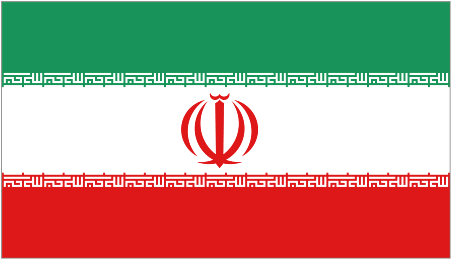 
|

 

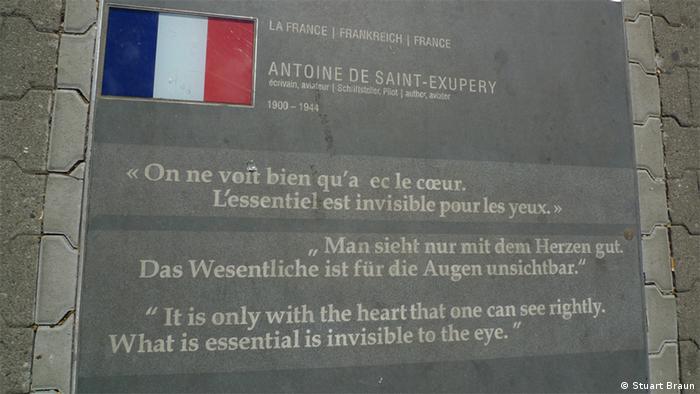
![]()
|  1843, 1879, 2006, Future - "Path of Visionaries," Friedrichstrasse, Mehringplatz, Berlin (Germany). "Friedrichstrasse, the Path of Visionaries of the World, will be a united voice for tolerance & dialogue created by 123 nations. But typically for Berlin, the grand vision has painful origins.
Berlin's potent and complex history, its inner contradictions & potential for positive change, is inscribed in every street and neighborhood. Take Mehringplatz, a stark 1970's housing estate, a welfare ghetto that inauspiciously crowns the southern end of Berlin's famous Friedrichstrasse... Belle-Alliance Platz stood for the concept of peace. It had a [peace] column in the middle with this angel of peace and victory...erected in the wake of the victory in the War of Liberation against Napolean [1813-1814]. It's the older cousin of the larger Victory Column in the Tiergarten...
Voges's initial plan for a sculpture on Mehringplatz will eventually be realized, but creating a Path of Visionaries from here all the way along Friedrichstrasse has taken priority since 2006, when an installation featuring plaques from 27 EU member states was unveiled.
The plaques featured words of wisdom from European sages like Albert Einstein & Antoine De Saint-Exupery (pictured)." /// Upper left images: "Der Friede / The Peace" (1879) by Albert Wolff [1814–1892]. /// 19th century statue of Victoria, symbol of victory & peace, contrasts with 1970's public housing at Mehringplatz." /// Lower right image: "One of only a few plaques remaining at Mehringplatz after building works disrupted the project." 1843, 1879, 2006, Future - "Path of Visionaries," Friedrichstrasse, Mehringplatz, Berlin (Germany). "Friedrichstrasse, the Path of Visionaries of the World, will be a united voice for tolerance & dialogue created by 123 nations. But typically for Berlin, the grand vision has painful origins.
Berlin's potent and complex history, its inner contradictions & potential for positive change, is inscribed in every street and neighborhood. Take Mehringplatz, a stark 1970's housing estate, a welfare ghetto that inauspiciously crowns the southern end of Berlin's famous Friedrichstrasse... Belle-Alliance Platz stood for the concept of peace. It had a [peace] column in the middle with this angel of peace and victory...erected in the wake of the victory in the War of Liberation against Napolean [1813-1814]. It's the older cousin of the larger Victory Column in the Tiergarten...
Voges's initial plan for a sculpture on Mehringplatz will eventually be realized, but creating a Path of Visionaries from here all the way along Friedrichstrasse has taken priority since 2006, when an installation featuring plaques from 27 EU member states was unveiled.
The plaques featured words of wisdom from European sages like Albert Einstein & Antoine De Saint-Exupery (pictured)." /// Upper left images: "Der Friede / The Peace" (1879) by Albert Wolff [1814–1892]. /// 19th century statue of Victoria, symbol of victory & peace, contrasts with 1970's public housing at Mehringplatz." /// Lower right image: "One of only a few plaques remaining at Mehringplatz after building works disrupted the project."
|



| C
H
U
R
C
H | 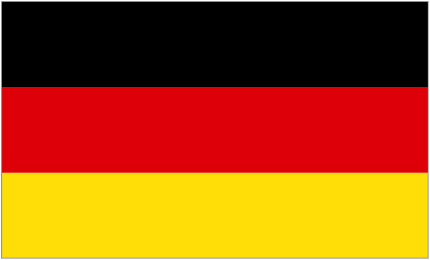 September 24, 1848 - Friedenskirche / Church of Peace, Marly Gardens on the Green Fence, Sanssouci Park, Potsdam (Germany). "Built according to the wishes and with the close involvement of the artistically gifted King Frederick William IV [1795-1861], and designed by the court architect Friedrich Ludwig Persius [1803-1845]. After Persius' death in 1845 the architect Friedrich August Stüler [1800-1865] was tasked with continuing his work. After the cornerstone was laid on 14 April 1845 the dedication of the sacred building took place on 24 September 1848. The building work lasted until 1854. The structure resembles a High Italian monastery. September 24, 1848 - Friedenskirche / Church of Peace, Marly Gardens on the Green Fence, Sanssouci Park, Potsdam (Germany). "Built according to the wishes and with the close involvement of the artistically gifted King Frederick William IV [1795-1861], and designed by the court architect Friedrich Ludwig Persius [1803-1845]. After Persius' death in 1845 the architect Friedrich August Stüler [1800-1865] was tasked with continuing his work. After the cornerstone was laid on 14 April 1845 the dedication of the sacred building took place on 24 September 1848. The building work lasted until 1854. The structure resembles a High Italian monastery.
|

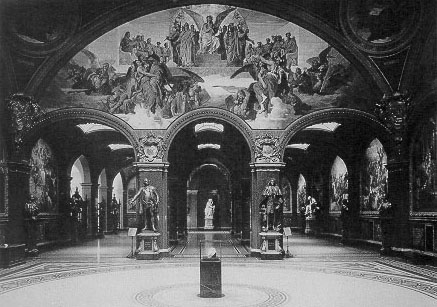
| 
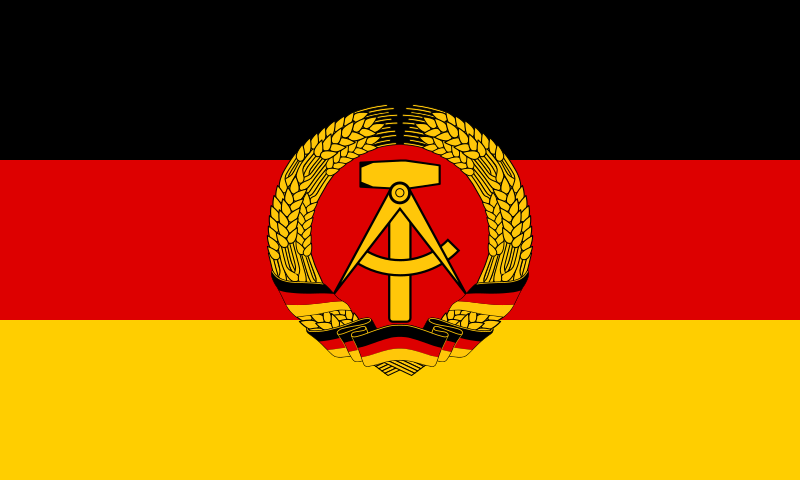  c.1890 - Ruhmeshalle im Zeughaus / Hall Of Fame in the armory, Deutsches Historisches Museum, Unter den Linden, Berlin (Germany). "With the palm of peace of the world is approaching a brilliant Genius announces peace, and angels proclaim the message further. Warriors return, with them, the goddess of victory & poetry. The weapons are laid down, and returning home welcomes the people rejoicing over the victory, full of melancholy over the fallen & full of joy over the incipient peaceful work. Law in the mourning veil, a widow with her children: the fallen husband weeping, she brings the return ends of the palm. Links praise a Virgin and Child with vocals & violin to the Almighty. "Mural of Frederick Geselschap destroyed." [Google translation] // The Zeughaus / Old Arsenal is the oldest structure on the Unter den Linden. It was built by the Brandenburg Elector Frederick III between 1695 and 1730 in the baroque style, to be used as an artillery arsenal for the display of cannons from Brandenburg & Prussia... The building was converted into a military museum in 1875.
In March 1943, Rudolf von Gersdorff tried, but failed to assassinate by suicide bombing Adolf Hitler, during the opening of an exhibition in this museum. In 1952, the government of the German Democratic Republic opened the Museum of German History (Museum für Deutsche Geschichte) in the Zeughaus, which presented the history of Germany, especially in the modern era, from a Communist point of view. Today, the Zeughaus is the site of the Deutsches Historisches Museum (German Historical Museum)." c.1890 - Ruhmeshalle im Zeughaus / Hall Of Fame in the armory, Deutsches Historisches Museum, Unter den Linden, Berlin (Germany). "With the palm of peace of the world is approaching a brilliant Genius announces peace, and angels proclaim the message further. Warriors return, with them, the goddess of victory & poetry. The weapons are laid down, and returning home welcomes the people rejoicing over the victory, full of melancholy over the fallen & full of joy over the incipient peaceful work. Law in the mourning veil, a widow with her children: the fallen husband weeping, she brings the return ends of the palm. Links praise a Virgin and Child with vocals & violin to the Almighty. "Mural of Frederick Geselschap destroyed." [Google translation] // The Zeughaus / Old Arsenal is the oldest structure on the Unter den Linden. It was built by the Brandenburg Elector Frederick III between 1695 and 1730 in the baroque style, to be used as an artillery arsenal for the display of cannons from Brandenburg & Prussia... The building was converted into a military museum in 1875.
In March 1943, Rudolf von Gersdorff tried, but failed to assassinate by suicide bombing Adolf Hitler, during the opening of an exhibition in this museum. In 1952, the government of the German Democratic Republic opened the Museum of German History (Museum für Deutsche Geschichte) in the Zeughaus, which presented the history of Germany, especially in the modern era, from a Communist point of view. Today, the Zeughaus is the site of the Deutsches Historisches Museum (German Historical Museum)."
|



| C
H
U
R
C
H | 
 1894-1985 - Church of Reconciliation, Bernauer Straße, Berlin (Germany). "The division of Berlin in 1945 left the Church of Reconciliation in the Soviet Sector, but the pavement in front of the church and most of its parishioners were in the French sector. This meant that when the Berlin Wall was built in 1961, the outer wall passed directly in front of the church [left image] and the inner wall passed directly behind it leaving the church blocked off to all but the border guards.
The Church of Reconciliation was an increasing annoyance to the GDR (German Democratic Republic or ‘East’ Germany) government. The nave was destroyed on 22nd January 1985 followed by the church steeple six days later [right image]. At the time, images of the crumbling steeple were broadcast around the world, causing both bewilderment & disgust. Instead of removing the building as a symbol, it assured that it would pass into legend." /// See Kapelle der Versöhnung / Chapel of Reconciliation (1999). 1894-1985 - Church of Reconciliation, Bernauer Straße, Berlin (Germany). "The division of Berlin in 1945 left the Church of Reconciliation in the Soviet Sector, but the pavement in front of the church and most of its parishioners were in the French sector. This meant that when the Berlin Wall was built in 1961, the outer wall passed directly in front of the church [left image] and the inner wall passed directly behind it leaving the church blocked off to all but the border guards.
The Church of Reconciliation was an increasing annoyance to the GDR (German Democratic Republic or ‘East’ Germany) government. The nave was destroyed on 22nd January 1985 followed by the church steeple six days later [right image]. At the time, images of the crumbling steeple were broadcast around the world, causing both bewilderment & disgust. Instead of removing the building as a symbol, it assured that it would pass into legend." /// See Kapelle der Versöhnung / Chapel of Reconciliation (1999).
|





| H
O
U
S
E |  1929-1933 - Sommerhaus / Summer house of Albert Einstein, Caputh, near Potstdam (Germany). Unintentional monument. "Built for Einstein in 1929. Though a non swimmer, Einstein was a passionate recreational sailor on the lake [Templiner See & Schwielowsee]. He was only able to use his retreat until the Nazi takeover in 1933. After German reunification & the restitution to the Einstein family, the house is now a property of the Hebrew University of Jerusalem." /// The Haus is legally prohibited from being a museum. /// "For me, the highlight [of my visit] was an unexpected visit to Einstein’s summer-house.
Andreas Landl, the peace journalist from Vienna, joined us for the excursion to Caputh, and made pictures. I hope to be able to send you some soon." [Peter van den Dungen, Nov. 3, 2011] /// Albert Einstein [1879-1955] received the Nobel Prize for Physics in 1921. 1929-1933 - Sommerhaus / Summer house of Albert Einstein, Caputh, near Potstdam (Germany). Unintentional monument. "Built for Einstein in 1929. Though a non swimmer, Einstein was a passionate recreational sailor on the lake [Templiner See & Schwielowsee]. He was only able to use his retreat until the Nazi takeover in 1933. After German reunification & the restitution to the Einstein family, the house is now a property of the Hebrew University of Jerusalem." /// The Haus is legally prohibited from being a museum. /// "For me, the highlight [of my visit] was an unexpected visit to Einstein’s summer-house.
Andreas Landl, the peace journalist from Vienna, joined us for the excursion to Caputh, and made pictures. I hope to be able to send you some soon." [Peter van den Dungen, Nov. 3, 2011] /// Albert Einstein [1879-1955] received the Nobel Prize for Physics in 1921. 
|
 | M U S E U M
 2005 Albert Einstein Museum, Buergerhaus, Strasse der Einheit 3, Schwielowsee, Ortsteil District, Caputh (Germany). "There is also an Albert Einstein Museum in Caputh. Small, but very interesting, although more information in it about Einstein & peace would be welcome." [Gerard Lössbroek, Nov. 5, 2011]
"Five minutes or so walking from the summer house. The exhibition is entitled 'Albert Einsteins Sommeridyll in Caputh /
Einstein's Summer Idyll in Caputh' & was made for the 2005 Einstein year but has remained there as a
permanent exhibition. 2005 Albert Einstein Museum, Buergerhaus, Strasse der Einheit 3, Schwielowsee, Ortsteil District, Caputh (Germany). "There is also an Albert Einstein Museum in Caputh. Small, but very interesting, although more information in it about Einstein & peace would be welcome." [Gerard Lössbroek, Nov. 5, 2011]
"Five minutes or so walking from the summer house. The exhibition is entitled 'Albert Einsteins Sommeridyll in Caputh /
Einstein's Summer Idyll in Caputh' & was made for the 2005 Einstein year but has remained there as a
permanent exhibition.
|


|     1931 - Neue Wache / New Guard House, north side of Unter den Linden, Berlin (Germany). Guard house constructed in 1816. Memorial to the victims of war & tyranny since 1931.
"In 1931, architect Heinrich Tessenow redesigned the building as the "Memorial for the Fallen of the War" [WW-I]. The building was heavily damaged by bombing & artillery during the last months of World War II.
The Unter den Linden was located within the Soviet zone of occupation of Berlin &, after 1949, was part of the communist German Democratic Republic. In 1960, the repaired Neue Wache was reopened as a "Memorial to the Victims of Fascism & Militarism." In 1969, the 20th anniversary of the GDR, a glass prism structure with an eternal flame was placed in center of the hall. The remains of an unknown soldier & of an unknown concentration camp victim from World War II were enshrined in the building.
After German reunification [in 1990], the Neue Wache was again rededicated in 1993, as the "Central Memorial for the Victims of War & Tyranny." The GDR memorial piece was removed and replaced by an enlarged version "Mother with her Dead Son" by ["the famous sociocritical artist"] Käthe Schmidt Kollwitz [1867-1945]. This sculpture is directly under the oculus, and so is exposed to the rain, snow and cold of the Berlin climate, symbolizing the suffering of civilians during World War II." Click here for other Kollwitz monuments. 1931 - Neue Wache / New Guard House, north side of Unter den Linden, Berlin (Germany). Guard house constructed in 1816. Memorial to the victims of war & tyranny since 1931.
"In 1931, architect Heinrich Tessenow redesigned the building as the "Memorial for the Fallen of the War" [WW-I]. The building was heavily damaged by bombing & artillery during the last months of World War II.
The Unter den Linden was located within the Soviet zone of occupation of Berlin &, after 1949, was part of the communist German Democratic Republic. In 1960, the repaired Neue Wache was reopened as a "Memorial to the Victims of Fascism & Militarism." In 1969, the 20th anniversary of the GDR, a glass prism structure with an eternal flame was placed in center of the hall. The remains of an unknown soldier & of an unknown concentration camp victim from World War II were enshrined in the building.
After German reunification [in 1990], the Neue Wache was again rededicated in 1993, as the "Central Memorial for the Victims of War & Tyranny." The GDR memorial piece was removed and replaced by an enlarged version "Mother with her Dead Son" by ["the famous sociocritical artist"] Käthe Schmidt Kollwitz [1867-1945]. This sculpture is directly under the oculus, and so is exposed to the rain, snow and cold of the Berlin climate, symbolizing the suffering of civilians during World War II." Click here for other Kollwitz monuments.
|
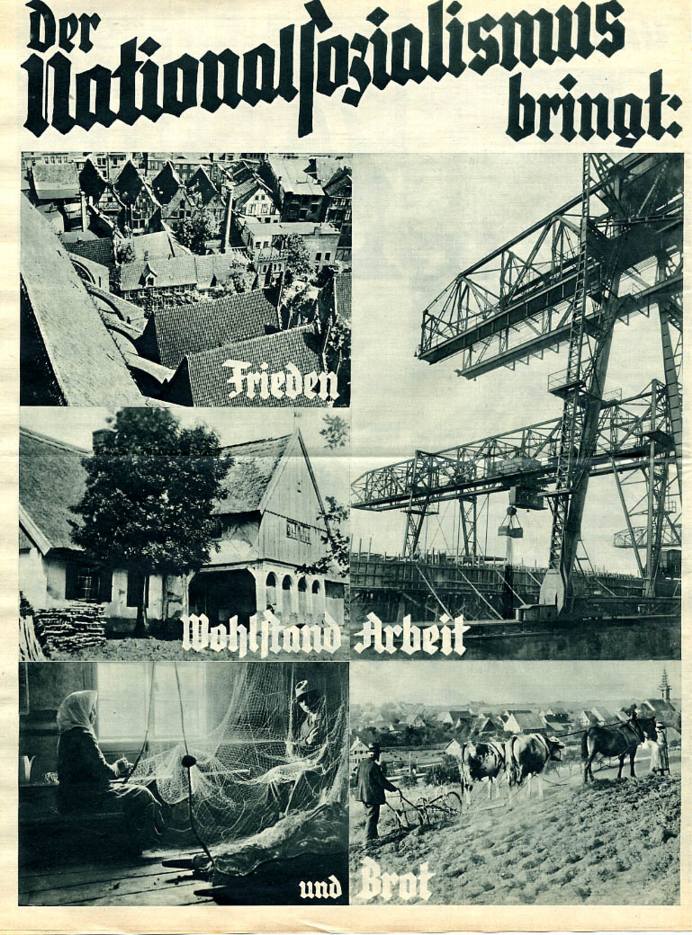
| P O S T E R
 June 1932 - "National Socialism Brings Peace, Prosperity, Jobs and Food." June 1932 - "National Socialism Brings Peace, Prosperity, Jobs and Food."
|
 January 30, 1933 - Adolf Hitler [1889-1945] named Chancellor of Germany.
January 30, 1933 - Adolf Hitler [1889-1945] named Chancellor of Germany.


 |  August 1-16, 1936 - Stadium & Cauldron, Summer Olympic Games, Berlin (Nazi Germany). The Olympic village was at Estal in Wustermark 30 kilometres (19 mi) from the centre of Berlin & consisted of one to two floor dormitories, dining areas, a swimming pool & training facilities. During WW-II, it was used as a hospital for injured Wehrmacht soldiers. In 1945, it was taken over by the Soviet Union & became a torture & interrogation centre for SMERSH... Efforts are being made to restore the site into a living museum. The dormitory building used by Jesse Owens has been fully restored, and tours are given daily to small groups & students." August 1-16, 1936 - Stadium & Cauldron, Summer Olympic Games, Berlin (Nazi Germany). The Olympic village was at Estal in Wustermark 30 kilometres (19 mi) from the centre of Berlin & consisted of one to two floor dormitories, dining areas, a swimming pool & training facilities. During WW-II, it was used as a hospital for injured Wehrmacht soldiers. In 1945, it was taken over by the Soviet Union & became a torture & interrogation centre for SMERSH... Efforts are being made to restore the site into a living museum. The dormitory building used by Jesse Owens has been fully restored, and tours are given daily to small groups & students."
|
 November 19-10, 1938 - Krystalnacht / "Night of Broken Glass."
November 19-10, 1938 - Krystalnacht / "Night of Broken Glass."
 January 20, 1942 - Wannsee Conference at which Reinhard Heydrich [1804-1942] announced Hitler's decision to murder the Jews of Europe.
January 20, 1942 - Wannsee Conference at which Reinhard Heydrich [1804-1942] announced Hitler's decision to murder the Jews of Europe.
 April 30, 1945 - Death of Adolf Hitler [1889-1945] in Berlin.
April 30, 1945 - Death of Adolf Hitler [1889-1945] in Berlin.

|  Date? (after WW-II) - Krypta/Crypt of Max Josef Metzger (1887-1944), Pfarrkirche St. Joseph, Müllerstr. 161 oder Willdenowstr.8, Berlin (Germany). The crypt & apse were destroyed by an air raid on 24 April 1945, which killed 38 people. The restored crypt was designed as a memorial to commemorate the victims of the war & to the martyrs killed by the Nazis including priest Dr. Max Josef Metzger. Information courtesy of Gerard Lössbroek 01Feb13. Date? (after WW-II) - Krypta/Crypt of Max Josef Metzger (1887-1944), Pfarrkirche St. Joseph, Müllerstr. 161 oder Willdenowstr.8, Berlin (Germany). The crypt & apse were destroyed by an air raid on 24 April 1945, which killed 38 people. The restored crypt was designed as a memorial to commemorate the victims of the war & to the martyrs killed by the Nazis including priest Dr. Max Josef Metzger. Information courtesy of Gerard Lössbroek 01Feb13.
|

|  Date? - Gedenktafel/Memorial plaque for Max Josef Metzger (1887-1944), Willdenowstraße 8, Berlin-Wedding (Germany). Marks house where Metzger lived. Information courtesy of Gerard Lössbroek 01Feb13. Date? - Gedenktafel/Memorial plaque for Max Josef Metzger (1887-1944), Willdenowstraße 8, Berlin-Wedding (Germany). Marks house where Metzger lived. Information courtesy of Gerard Lössbroek 01Feb13.
|


|  October 1973 - Bust of Max Josef Metzger (1887-1944), Augsburg Cathedral (South Side), Augsburg (Germany). Sculpted by Hans Ladner. Inscription: "Fur den Frieden der Welt und die Einheit der Kirche./For world peace and church unity." Information courtesy of Gerard Lössbroek 01Feb13. October 1973 - Bust of Max Josef Metzger (1887-1944), Augsburg Cathedral (South Side), Augsburg (Germany). Sculpted by Hans Ladner. Inscription: "Fur den Frieden der Welt und die Einheit der Kirche./For world peace and church unity." Information courtesy of Gerard Lössbroek 01Feb13.
|
 June 24, 1948-May 12, 1949 - Berlin Blockade & Airlift. (39 British & 31 American airmen lost their lives during the airlift.)
June 24, 1948-May 12, 1949 - Berlin Blockade & Airlift. (39 British & 31 American airmen lost their lives during the airlift.)


 May 23, 1949 - Federal Republic of Germany (FRG) formed from American, British & French zones. (Had its seat of government & de facto capital in Bonn, although Berlin was symbolically named as the de jure capital.)
May 23, 1949 - Federal Republic of Germany (FRG) formed from American, British & French zones. (Had its seat of government & de facto capital in Bonn, although Berlin was symbolically named as the de jure capital.)



 Date?, 1949 - German Democratic Republic (GDR) formed from Soviet zone. (Had its capital in Berlin.)
Date?, 1949 - German Democratic Republic (GDR) formed from Soviet zone. (Had its capital in Berlin.) 

|  August 1951 - 3rd World Festival of Youth & Students for Peace (WFYS), East Berlin (East Germany). Attended by 26,000 participants from 104 countries. Its motto was: "For Peace and Friendship - Against Nuclear Weapons." /// Image shows scarf to commemorate the festival by Pablo Picasso [1881-1973]. "During the late 1940's and early 1950's, Picasso was actively involved in the communist-supported International Peace Movement and attended congresses in Poland, Italy & England. In 1950 he was awarded the Lenin Peace Prize, but his art was not generally approved by the Communist Party. Picasso avoided using overtly communist symbolism in his work and refused to work in the socialist realist style favoured by the party." August 1951 - 3rd World Festival of Youth & Students for Peace (WFYS), East Berlin (East Germany). Attended by 26,000 participants from 104 countries. Its motto was: "For Peace and Friendship - Against Nuclear Weapons." /// Image shows scarf to commemorate the festival by Pablo Picasso [1881-1973]. "During the late 1940's and early 1950's, Picasso was actively involved in the communist-supported International Peace Movement and attended congresses in Poland, Italy & England. In 1950 he was awarded the Lenin Peace Prize, but his art was not generally approved by the Communist Party. Picasso avoided using overtly communist symbolism in his work and refused to work in the socialist realist style favoured by the party." 
|
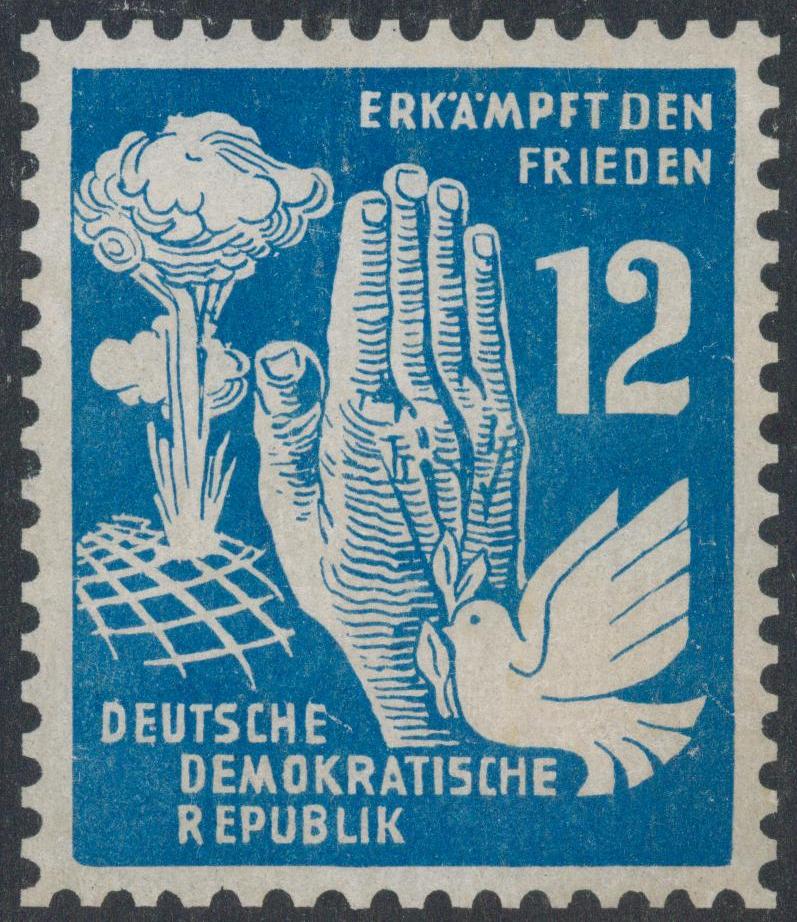
| S
T
A
M
P |  1951? - German Democratic Republic. Anti-nuclear stamp featuring a dove of peace. Probably issued in connection with the 3rd World Festival of Youth & Students for Peace
(WFYS) which was attended by 26,000 participants from 104 countries. The fetival motto was "For Peace and Friendship - Against Nuclear Weapons." 1951? - German Democratic Republic. Anti-nuclear stamp featuring a dove of peace. Probably issued in connection with the 3rd World Festival of Youth & Students for Peace
(WFYS) which was attended by 26,000 participants from 104 countries. The fetival motto was "For Peace and Friendship - Against Nuclear Weapons."
|

|  1952 - World Peace Congress , East Berlin (East Germany). Image shows Picasso's dove above the stage. 1952 - World Peace Congress , East Berlin (East Germany). Image shows Picasso's dove above the stage.
|
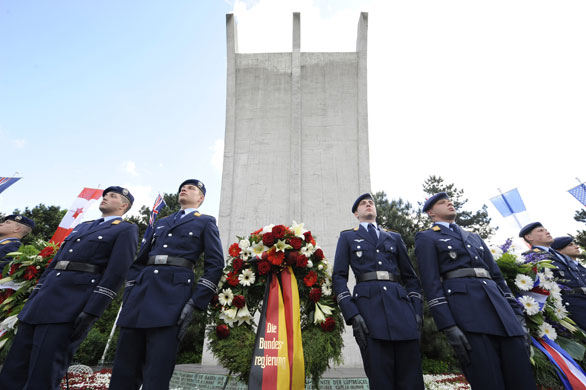
| A
R
C
H |  1951 - Berlin Airlift Memorial, Platz der Luftbrücke, Tempelhof Airport, Berlin (Germany).
Three arching “prongs” represent the three official air corridors (Luftkorridore) used on flights between West Berlin and West Germany [during the Berlin Blockade, 24 June 1948 – 12 May 1949]. Displays the names of the 39 British & 31 American airmen who lost their lives during the operation. A matching monument stands at the other end of the “air bridge” at the Rhein-Main air base in Frankfurt, completing the airlift arch. 1951 - Berlin Airlift Memorial, Platz der Luftbrücke, Tempelhof Airport, Berlin (Germany).
Three arching “prongs” represent the three official air corridors (Luftkorridore) used on flights between West Berlin and West Germany [during the Berlin Blockade, 24 June 1948 – 12 May 1949]. Displays the names of the 39 British & 31 American airmen who lost their lives during the operation. A matching monument stands at the other end of the “air bridge” at the Rhein-Main air base in Frankfurt, completing the airlift arch.  
|
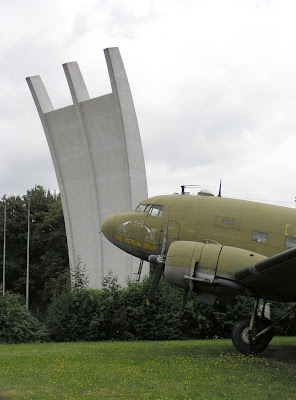 |  1951 - Berlin Airlift Memorial, Frankfurt (Germany). "Though Rhein-Main Air Base is now closed, this memorial to the Berlin Airlift is still clearly visible from the A5 Autobahn which runs alongside the Frankfurt Airport." 1951 - Berlin Airlift Memorial, Frankfurt (Germany). "Though Rhein-Main Air Base is now closed, this memorial to the Berlin Airlift is still clearly visible from the A5 Autobahn which runs alongside the Frankfurt Airport."
|

|  1955 - Memorial with eternal flame, Theodor-Heuss Platz (former Reichskanzlerplatz), Berlin (Germany).
On westward extension of Unter den Linden/Strasse des 17.Juni/Bismarckstrasse. Worded "Freiheit - Recht - Friede / Freedom - Law - Peace." Memorializes German expellees & victims of forced displacement. /// "The eternal flame burning on a simple square, out the words 'freedom, justice and peace,' on the other hand, we read: 'This flame warns: Never again expulsion.' Since 1955 she is burning there." [Google translaton] 1955 - Memorial with eternal flame, Theodor-Heuss Platz (former Reichskanzlerplatz), Berlin (Germany).
On westward extension of Unter den Linden/Strasse des 17.Juni/Bismarckstrasse. Worded "Freiheit - Recht - Friede / Freedom - Law - Peace." Memorializes German expellees & victims of forced displacement. /// "The eternal flame burning on a simple square, out the words 'freedom, justice and peace,' on the other hand, we read: 'This flame warns: Never again expulsion.' Since 1955 she is burning there." [Google translaton]
|

|  September 27, 1959 - Judisches Gemeindehaus / Jewish Community Center, 79-80 Fasanenstraße, Berlin (Germany). On site of Fasanenstraße Synagogue, built in 1912 & destroyed November 19-10, 1938 during Krystalnacht ("Night of Broken Glass"). The ruins were removed, but a few surviving elements, such as the main portal, were kept as decoration of the new building designed in the Modern style of the 1950's.
Since 2006, the building hosts the Jewish adult education centre & administrative departments as the Community Center has moved to the New Synagogue on Oranienburger Straße." /// "There is also an emotive statue at the front of the building, depicting a broken scroll of the Torah (the holy book of Jewish Law)." September 27, 1959 - Judisches Gemeindehaus / Jewish Community Center, 79-80 Fasanenstraße, Berlin (Germany). On site of Fasanenstraße Synagogue, built in 1912 & destroyed November 19-10, 1938 during Krystalnacht ("Night of Broken Glass"). The ruins were removed, but a few surviving elements, such as the main portal, were kept as decoration of the new building designed in the Modern style of the 1950's.
Since 2006, the building hosts the Jewish adult education centre & administrative departments as the Community Center has moved to the New Synagogue on Oranienburger Straße." /// "There is also an emotive statue at the front of the building, depicting a broken scroll of the Torah (the holy book of Jewish Law)."
|




|  1961 - Statue of Käthe Kollwitz, Kollwitz Platz, Prenzlauer Berg district, Berlin (Germany). In platz / square named for Kollwitz after WW-II. "The square forms the center of the so-called "Kollwitz Kiez." was on 7 October 1947 after the German graphic artist and sculptor Käthe Kollwitz, named here spent much of their lives in the house Kollwitzstraße 56a (then Weissenburgerstrasse 25). Until then, he said Wörther place, a name which he received in the planning of the area 1875th Indirectly, it also reminds the husband Karl Kollwitz, who practiced medicine here until 1940, was not dependent on his wife and the environment influenced the square. The triangular system is limited by the Kollwitzstraße, the Knaackstraße and the Worth Street (the intersection Husemannstraße). Overall, the place around 6000 m²." /// Left photo taken in 1979. Right photo is "Bildnis der Käthe Kollwitz; Plastik von Gustav Seitz auf dem Kollwitzplatz." /// Frühlich rummeln sich die Berliner Kinder vom Prenslauer Berg rund um das Käthe-Kollwitz-Denkmal am Kollwitz-Platz. /// Near the Jüdischer Friedhof / Jewish Cemetery on Schonhauser Allee. 1961 - Statue of Käthe Kollwitz, Kollwitz Platz, Prenzlauer Berg district, Berlin (Germany). In platz / square named for Kollwitz after WW-II. "The square forms the center of the so-called "Kollwitz Kiez." was on 7 October 1947 after the German graphic artist and sculptor Käthe Kollwitz, named here spent much of their lives in the house Kollwitzstraße 56a (then Weissenburgerstrasse 25). Until then, he said Wörther place, a name which he received in the planning of the area 1875th Indirectly, it also reminds the husband Karl Kollwitz, who practiced medicine here until 1940, was not dependent on his wife and the environment influenced the square. The triangular system is limited by the Kollwitzstraße, the Knaackstraße and the Worth Street (the intersection Husemannstraße). Overall, the place around 6000 m²." /// Left photo taken in 1979. Right photo is "Bildnis der Käthe Kollwitz; Plastik von Gustav Seitz auf dem Kollwitzplatz." /// Frühlich rummeln sich die Berliner Kinder vom Prenslauer Berg rund um das Käthe-Kollwitz-Denkmal am Kollwitz-Platz. /// Near the Jüdischer Friedhof / Jewish Cemetery on Schonhauser Allee.
|
 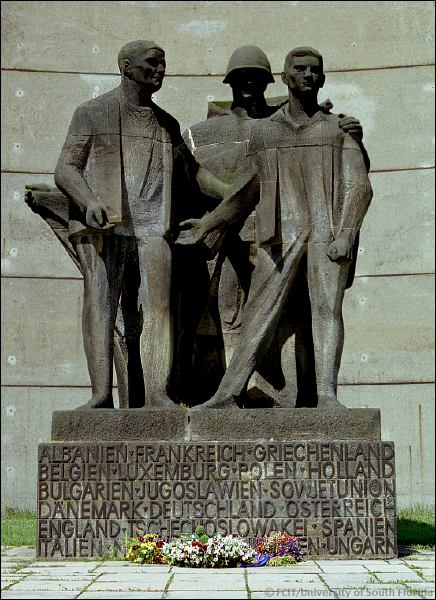

| C
A
MP | S
C
U
LP
T | M
U
S
E
U
M |  1961 - Sculpture "Liberation," Gedenkstätte und Museum Sachsenhausen, Strasse der Nationnen 22, Oranienburg, near Berlin (Germany). Sculpture by Communist sculptor Rene Graetz [1908-1974].
"The memorial site, where the Sachsenhausen concentration camp used to be, is right in the town of Oranienburg. 100,000 people were killed here, according to the Russians who conducted a military tribunal in which the commandant and 12 members of his staff confessed to mass murder.
Directly to the left of the entrance gate, there is a small restaurant called Cafe Talk which serves tasty but inexpensive food. There's also a memorial stone in honor of the prisoners who died on the death march when Sachsenhausen was evacuated on April 21, 1945, the day before the Russian army arrived to liberate the camp."
1961 - Sculpture "Liberation," Gedenkstätte und Museum Sachsenhausen, Strasse der Nationnen 22, Oranienburg, near Berlin (Germany). Sculpture by Communist sculptor Rene Graetz [1908-1974].
"The memorial site, where the Sachsenhausen concentration camp used to be, is right in the town of Oranienburg. 100,000 people were killed here, according to the Russians who conducted a military tribunal in which the commandant and 12 members of his staff confessed to mass murder.
Directly to the left of the entrance gate, there is a small restaurant called Cafe Talk which serves tasty but inexpensive food. There's also a memorial stone in honor of the prisoners who died on the death march when Sachsenhausen was evacuated on April 21, 1945, the day before the Russian army arrived to liberate the camp." 
|
 June 4-November 9, 1961 - Berlin Crisis. (USSR demands withdrawal of Western armed forces culminating with erection of the Berlin Wall.)
June 4-November 9, 1961 - Berlin Crisis. (USSR demands withdrawal of Western armed forces culminating with erection of the Berlin Wall.)
 August 13, 1961-November 9, 1989 - Berliner Mauer / Berlin Wall. (First concrete elements & large blocks put in place on 17 August. Additionally, chain fences, walls, minefields, other obstacles & a no man's land were installed along the length of East Germany's western border with West Germany proper.)
August 13, 1961-November 9, 1989 - Berliner Mauer / Berlin Wall. (First concrete elements & large blocks put in place on 17 August. Additionally, chain fences, walls, minefields, other obstacles & a no man's land were installed along the length of East Germany's western border with West Germany proper.)
 
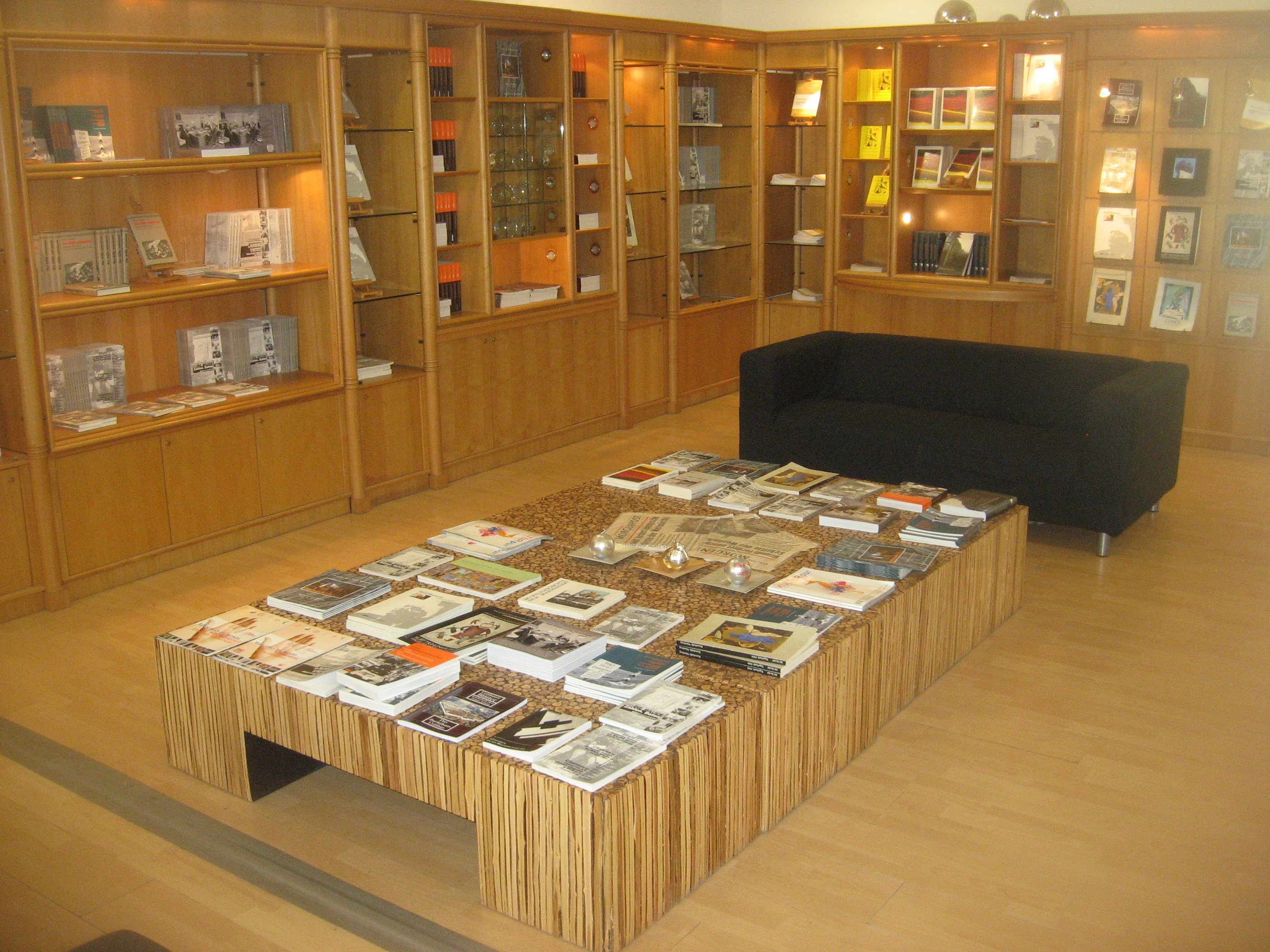

| M
U
SE
U
M |  October 19, 1962 - Museum Haus am Checkpoint Charlie (Mauermuseum), Friedrichsstraße 43-44, Berlin (Germany). "First museum of international nonviolent protest." "One of the most frequently visited museums in Berlin, with 850,000 visitors in 2007." Four permanent exhibitions: "The Wall," paintings of "The Wall," Berlin, and "From Gandhi to Walesa." Founded by Rainer Hildebrandt [1914-2004] & Alexandra Hildebrandt (who is current director). Operated by Arbeitsgemeinschaft 13 August e.V / 13th August Study Group. At present location since June 1963. Click here for Wikipedia article. Right image by EWL 6 Sept 2013 shows museum bookshop. Comment: Museum occupies all ground-floor spaces for an entire city block. The two spaces nearest the checkpoint are separate from the museum itself & are devoted entirely to the sale of souvenirs & books. /// Affiliated with International Network of Museums for Peace (INMP). October 19, 1962 - Museum Haus am Checkpoint Charlie (Mauermuseum), Friedrichsstraße 43-44, Berlin (Germany). "First museum of international nonviolent protest." "One of the most frequently visited museums in Berlin, with 850,000 visitors in 2007." Four permanent exhibitions: "The Wall," paintings of "The Wall," Berlin, and "From Gandhi to Walesa." Founded by Rainer Hildebrandt [1914-2004] & Alexandra Hildebrandt (who is current director). Operated by Arbeitsgemeinschaft 13 August e.V / 13th August Study Group. At present location since June 1963. Click here for Wikipedia article. Right image by EWL 6 Sept 2013 shows museum bookshop. Comment: Museum occupies all ground-floor spaces for an entire city block. The two spaces nearest the checkpoint are separate from the museum itself & are devoted entirely to the sale of souvenirs & books. /// Affiliated with International Network of Museums for Peace (INMP). 
|

|  1963 -
Kaiser-Wilhelm-Gedächtniskirche / Kaiser Wilhelm Memorial Church, Kurfürstendamm, centre of Breitscheidplatz, Berlin (Germany). "Mostly just known as Gedächtniskirche. A Protestant church affilliated with the Evangelical Church. Original church on the site was built in the 1890's. Badly damaged in a bombing raid in 1943. The present building consists of a church with an attached foyer & a separate belfry with an attached chapel, was built between 1959 & 1963. The damaged spire of the old church has been retained, & its ground floor has been made into a memorial hall. Today a famous landmark of western Berlin. Nicknamed by Berliners 'der hohle Zahn' / 'the hollow tooth.'" /// According to TravelAdvisor: "What remains of this church is a highly significant reminder of the consequences of war. The interior is beautiful & one can only imagine what it would have looked like when it stood as a whole." /// Info courtesy of Peter van den Dungen who writes 04Jan2017"The church now has a visitors centre where you can buy all kinds of souvenirs." 1963 -
Kaiser-Wilhelm-Gedächtniskirche / Kaiser Wilhelm Memorial Church, Kurfürstendamm, centre of Breitscheidplatz, Berlin (Germany). "Mostly just known as Gedächtniskirche. A Protestant church affilliated with the Evangelical Church. Original church on the site was built in the 1890's. Badly damaged in a bombing raid in 1943. The present building consists of a church with an attached foyer & a separate belfry with an attached chapel, was built between 1959 & 1963. The damaged spire of the old church has been retained, & its ground floor has been made into a memorial hall. Today a famous landmark of western Berlin. Nicknamed by Berliners 'der hohle Zahn' / 'the hollow tooth.'" /// According to TravelAdvisor: "What remains of this church is a highly significant reminder of the consequences of war. The interior is beautiful & one can only imagine what it would have looked like when it stood as a whole." /// Info courtesy of Peter van den Dungen who writes 04Jan2017"The church now has a visitors centre where you can buy all kinds of souvenirs."
|
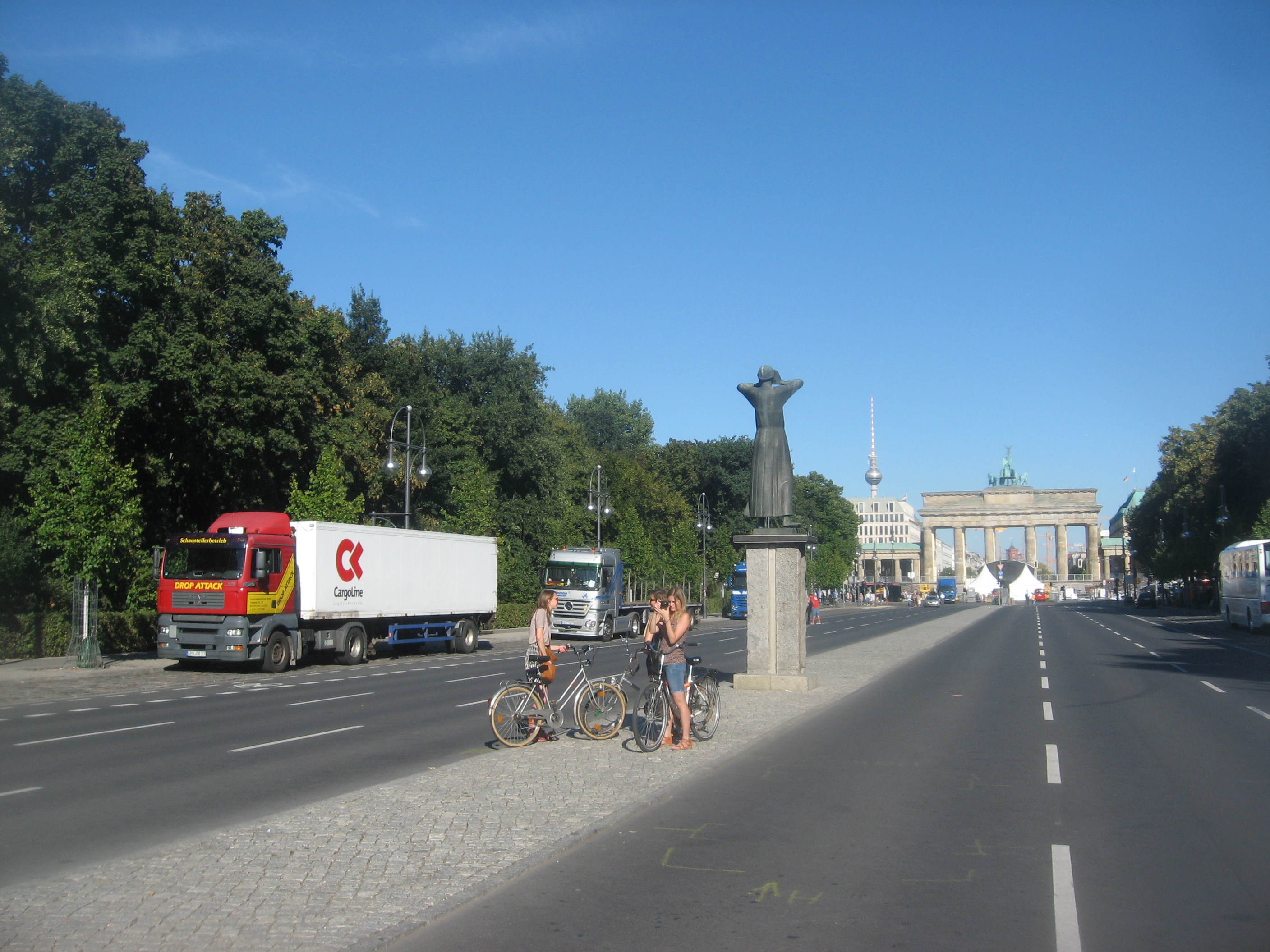 


|  1966 - "Der Rufer / The Caller," Middle of Straße des 17. Juni / 17th June Street, Tiergarten Berlin (Germany). Near Brandenburg Gate. "I wander through the world and cry ‘Peace, Peace, Peace.'" This quotation from the Italian poet Francesco Petrarch [1304-1374] is inscribed on the base of the sculpture. This bronze sculpture is 3 meters tall and was created by the sculptor and graphic artist Gerhard Marcks [1889-1981]." Left image by EWL 7 Sept 2013. This is "Monday's Monument" #89. 1966 - "Der Rufer / The Caller," Middle of Straße des 17. Juni / 17th June Street, Tiergarten Berlin (Germany). Near Brandenburg Gate. "I wander through the world and cry ‘Peace, Peace, Peace.'" This quotation from the Italian poet Francesco Petrarch [1304-1374] is inscribed on the base of the sculpture. This bronze sculpture is 3 meters tall and was created by the sculptor and graphic artist Gerhard Marcks [1889-1981]." Left image by EWL 7 Sept 2013. This is "Monday's Monument" #89.
|

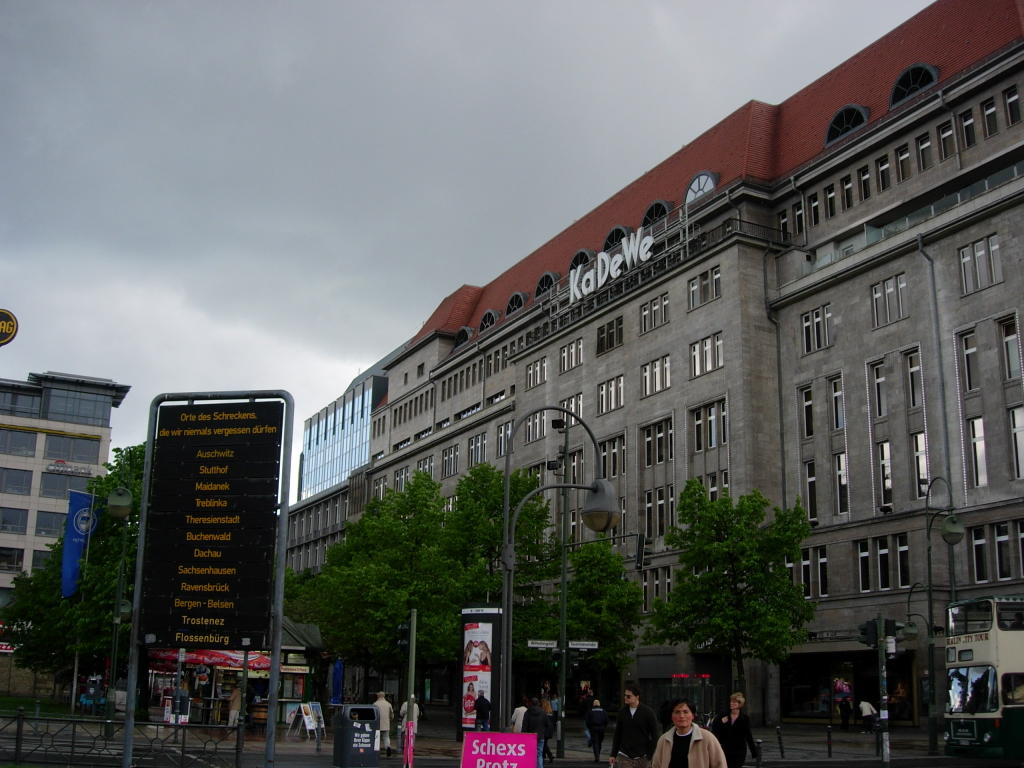
|  1967 - Holocaust Memorial, Bahnhof Wittenbergplatz, Berlin (Germany). Erected by League for Human Rights. Text is "Orte des Schreckens, die wir niemals vergessen durfen / Places of terror which we must never forget" followed by the names of Hitler’s 12 most notorious concentration camps, including Auschwitz, Buchenwald, Bergen-Belsen &Treblinka. /// "Wittenbergplatz is known for KaDeWe ("Kaufhaus des Westens"), which claims to be the largest department store of the West.
Across the square is the neo-classical entrance to the S-Bahn station.
And almost lost between these two impressive Berlin landmarks stands a discrete but powerful Holocaust Memorial.
It is a 10-foot high steel sign that gets lost in the urban jungle of signs. It looks like a directory at the entrance of a shopping mall, or a list of sponsors.
As much as the memorial felt swallowed in traffic, its violent simplicity reveals outstanding depth & efficiency. Once struck by its presence and its content, the visitor can only draw connections between the camps & the S-Bahn station, which must have served for deportations of Berlin Jews.
And then there's the juxtaposition of the Holocaust & the fancy shopping center. That's also heavy loaded. While Jews were being deported on trains, it was business as usual at KaDeWe: fine cheese, train of Jews, expensive wines, train of Jews, spicy salami, train of Jews...
The Wittenberg Platz Holocaust memorial is successful because of the trilogy Holocaust-train station-Department Store. It plays on our sense of familiarity & our surprise, our tendency not to see things that blend so well in the surroundings & our need to be (violently) reminded of History's dirty pages." /// Information courtesy of Christian Bartolf. 1967 - Holocaust Memorial, Bahnhof Wittenbergplatz, Berlin (Germany). Erected by League for Human Rights. Text is "Orte des Schreckens, die wir niemals vergessen durfen / Places of terror which we must never forget" followed by the names of Hitler’s 12 most notorious concentration camps, including Auschwitz, Buchenwald, Bergen-Belsen &Treblinka. /// "Wittenbergplatz is known for KaDeWe ("Kaufhaus des Westens"), which claims to be the largest department store of the West.
Across the square is the neo-classical entrance to the S-Bahn station.
And almost lost between these two impressive Berlin landmarks stands a discrete but powerful Holocaust Memorial.
It is a 10-foot high steel sign that gets lost in the urban jungle of signs. It looks like a directory at the entrance of a shopping mall, or a list of sponsors.
As much as the memorial felt swallowed in traffic, its violent simplicity reveals outstanding depth & efficiency. Once struck by its presence and its content, the visitor can only draw connections between the camps & the S-Bahn station, which must have served for deportations of Berlin Jews.
And then there's the juxtaposition of the Holocaust & the fancy shopping center. That's also heavy loaded. While Jews were being deported on trains, it was business as usual at KaDeWe: fine cheese, train of Jews, expensive wines, train of Jews, spicy salami, train of Jews...
The Wittenberg Platz Holocaust memorial is successful because of the trilogy Holocaust-train station-Department Store. It plays on our sense of familiarity & our surprise, our tendency not to see things that blend so well in the surroundings & our need to be (violently) reminded of History's dirty pages." /// Information courtesy of Christian Bartolf.
|
 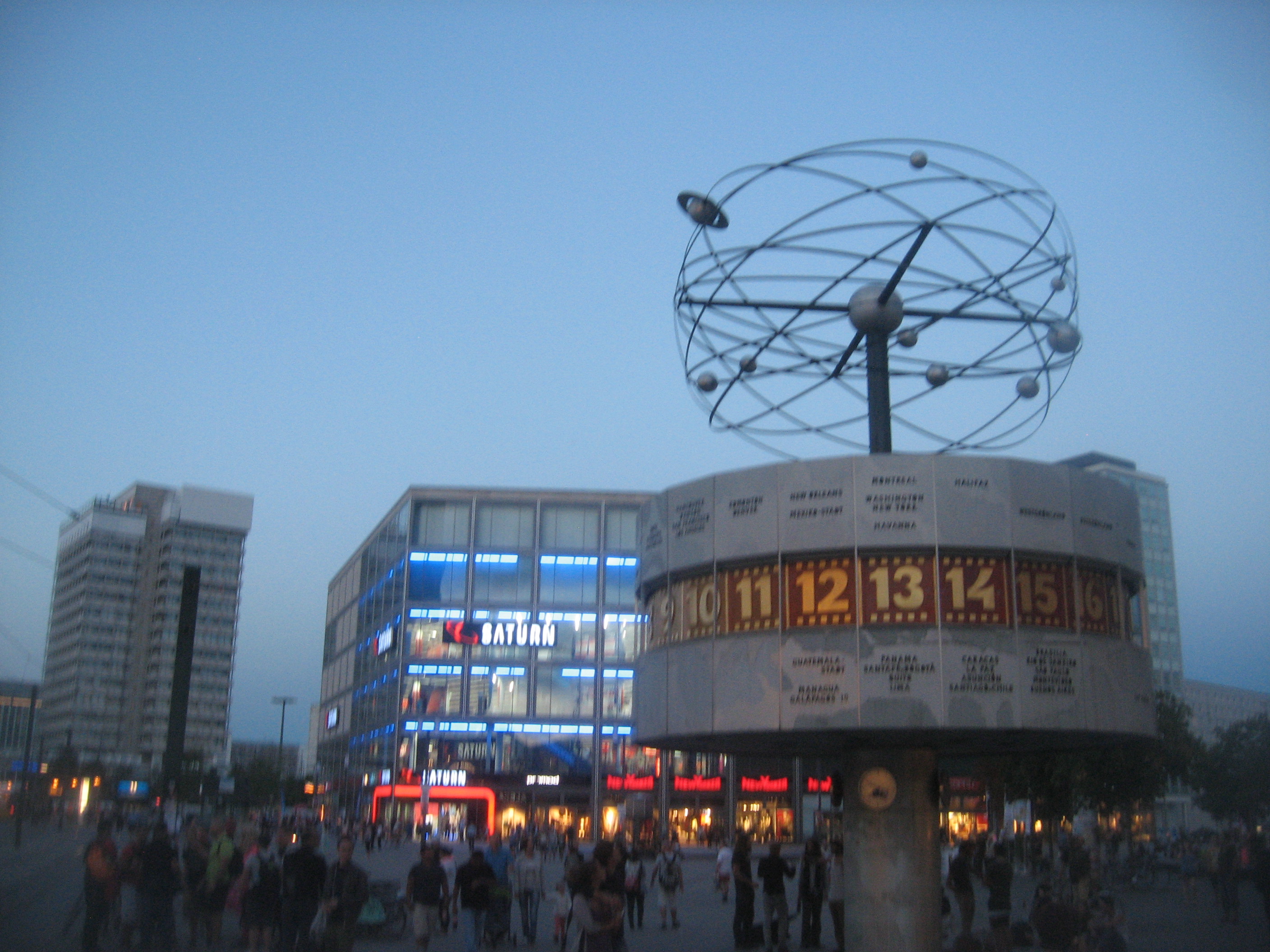
 |  1969 -
Die Weltzeituhr / World Time Clock, Alexanderplatz, Mitte, Berlin (Germany). Designed by Erich John. Right image by EWL 7 Sept 2013. 1969 -
Die Weltzeituhr / World Time Clock, Alexanderplatz, Mitte, Berlin (Germany). Designed by Erich John. Right image by EWL 7 Sept 2013.
|
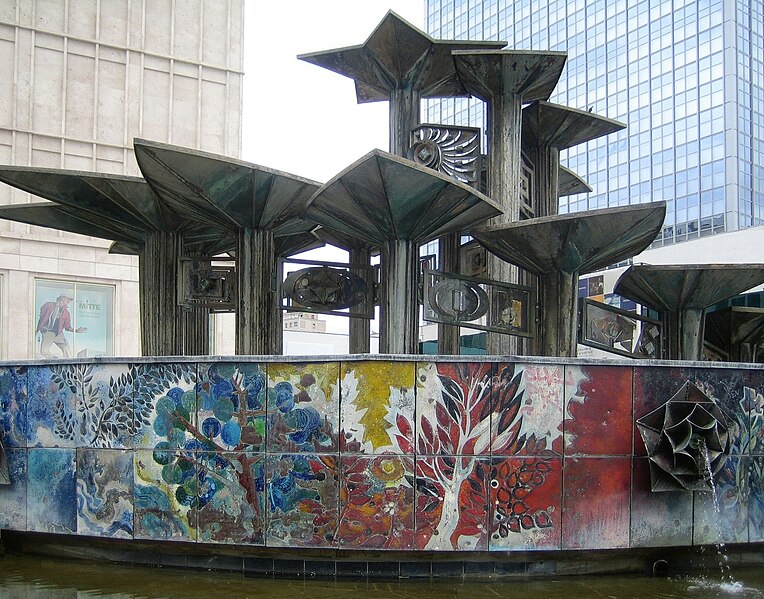 |  October 7, 1970 - Brunnen der Völkerfreundschaft / Fountain of the Friendship of Peoples, Alexanderplatz, Mitte, Berlin (Germany). Designed by Walter Womacka [1925-2010] as part of the redesign of Alexanderplatz. Dedicated on the 21st anniversary of the GDR. "At the center of the square. The 'Alex' has remained the true hub of East Berlin. Completely bombed, the working-class counterpart of Potsdamer Platz made way, in the 1960's, for an immense esplanade surrounded by concrete blocks." October 7, 1970 - Brunnen der Völkerfreundschaft / Fountain of the Friendship of Peoples, Alexanderplatz, Mitte, Berlin (Germany). Designed by Walter Womacka [1925-2010] as part of the redesign of Alexanderplatz. Dedicated on the 21st anniversary of the GDR. "At the center of the square. The 'Alex' has remained the true hub of East Berlin. Completely bombed, the working-class counterpart of Potsdamer Platz made way, in the 1960's, for an immense esplanade surrounded by concrete blocks."
|
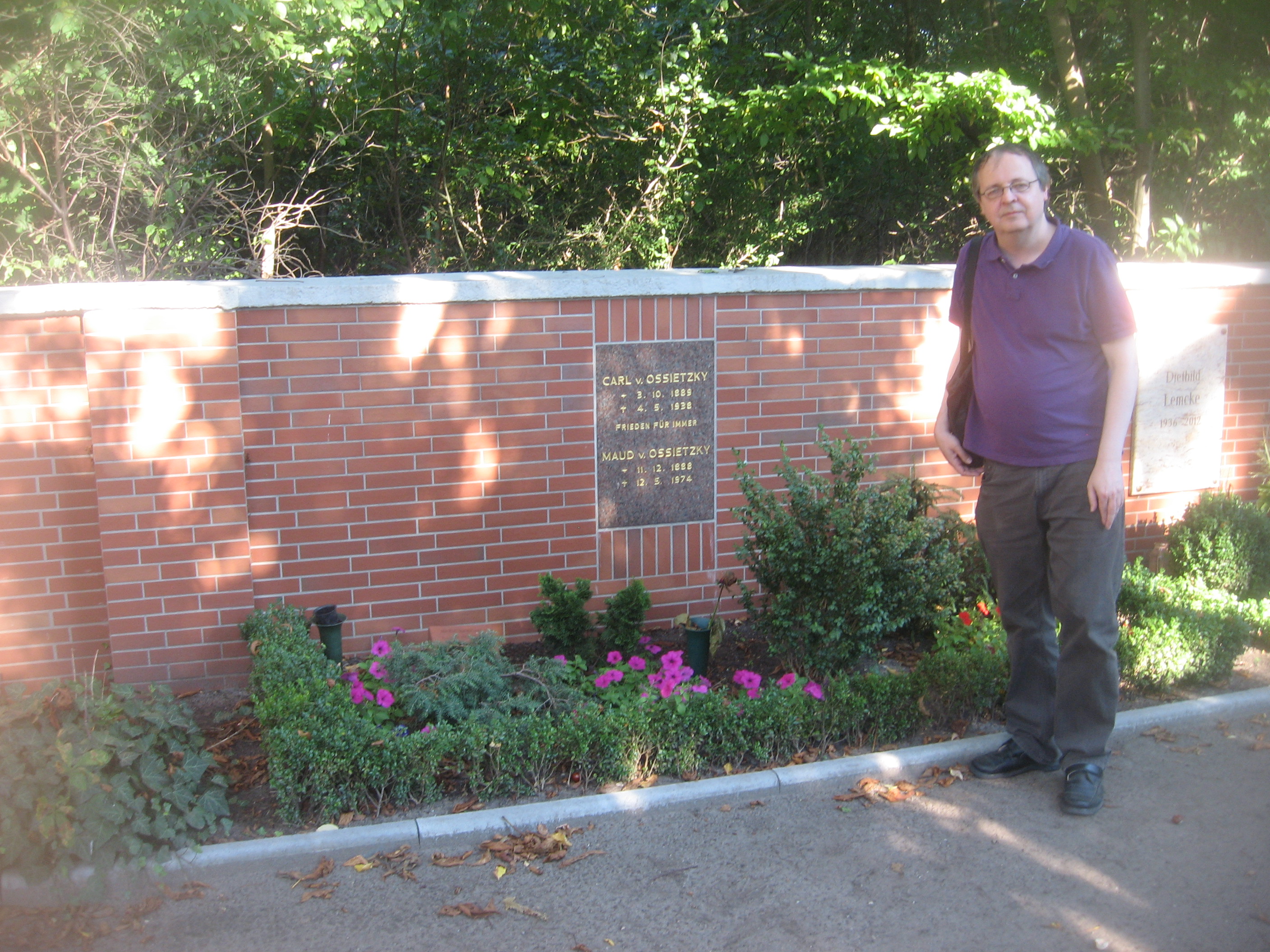
|  After 1974 - Graves of Carl von Ossietzky & his wife Maud Ossietzky, Friedhof Pankow IV,
Niederschonhausen, Pankow, Berlin (Germany). Carl von Ossietzky [1889-1938] received the Nobel Peace Prize in 1935. Maud Lichfield-Wood Ossietzky [1888-1974] was a suffragette in Manchester (England), born a British colonial officer's daughter & the great granddaughter of an Indian princess in Hyderabad (India). Ossietzky's was the only Nobel peace prize awarded for opposing Nazism. Only inscription on plaque: "Frieden für Immer / Peace Forever." Inscription on small terra cotta marker: "Ehrengrab Land Berlin / Honorary grave, State of Berlin." Information courtesy of Christian Bartolf (who is pictured in the image made by EWL 6 Sept 2013). After 1974 - Graves of Carl von Ossietzky & his wife Maud Ossietzky, Friedhof Pankow IV,
Niederschonhausen, Pankow, Berlin (Germany). Carl von Ossietzky [1889-1938] received the Nobel Peace Prize in 1935. Maud Lichfield-Wood Ossietzky [1888-1974] was a suffragette in Manchester (England), born a British colonial officer's daughter & the great granddaughter of an Indian princess in Hyderabad (India). Ossietzky's was the only Nobel peace prize awarded for opposing Nazism. Only inscription on plaque: "Frieden für Immer / Peace Forever." Inscription on small terra cotta marker: "Ehrengrab Land Berlin / Honorary grave, State of Berlin." Information courtesy of Christian Bartolf (who is pictured in the image made by EWL 6 Sept 2013).
 
|

|  1989? - Carl von Ossietzky Monument, Ossietzky Strasse, Berlin-Pankow, East Berlin (Germany).Carl von Ossietzky [1889-1938] received the Nobel Peace Prize in 1935. 1989? - Carl von Ossietzky Monument, Ossietzky Strasse, Berlin-Pankow, East Berlin (Germany).Carl von Ossietzky [1889-1938] received the Nobel Peace Prize in 1935.  
|



| M
U
SE
U
M
|  1982 - Anti-Kriegs-Museum (AKM) / Anti-War
Museum, Brusseler Straße 21, Berlin (Germany). Originally founded by anarchist & pacifist Ernest Friedrich [1894-1967] in 1925 [right image]. In March 1933, Nazi storm troopers (SA) destroyed the AKM. Friedrich was arrested, then emigrated to Belgium & France. AKM was reopened in 1982 (15 years after the death of its founder) by his grandson Tommy Spree (sic). Affiliated with International Network of Museums for Peace (INMP). /// Comment: Met by appointment with Tommy Spree [born 1940]. Museum displays old helmets, hand grenades & many photos of war wounds (particularly from WW-I). No connection to contemporary issues, other museums, or to the INMP is in evidence. Barely ten books are on sale, all of which are in German except 240-page picture book "Krieg dem Kriege! / War against War!" (1924) whose captions are in German, French, English & Dutch. /// See site of original museum (1925-1933). See "Das Gewehr Zerbrechen / Break the Gun" statue (2005) across the street from the museum. 1982 - Anti-Kriegs-Museum (AKM) / Anti-War
Museum, Brusseler Straße 21, Berlin (Germany). Originally founded by anarchist & pacifist Ernest Friedrich [1894-1967] in 1925 [right image]. In March 1933, Nazi storm troopers (SA) destroyed the AKM. Friedrich was arrested, then emigrated to Belgium & France. AKM was reopened in 1982 (15 years after the death of its founder) by his grandson Tommy Spree (sic). Affiliated with International Network of Museums for Peace (INMP). /// Comment: Met by appointment with Tommy Spree [born 1940]. Museum displays old helmets, hand grenades & many photos of war wounds (particularly from WW-I). No connection to contemporary issues, other museums, or to the INMP is in evidence. Barely ten books are on sale, all of which are in German except 240-page picture book "Krieg dem Kriege! / War against War!" (1924) whose captions are in German, French, English & Dutch. /// See site of original museum (1925-1933). See "Das Gewehr Zerbrechen / Break the Gun" statue (2005) across the street from the museum. 
|
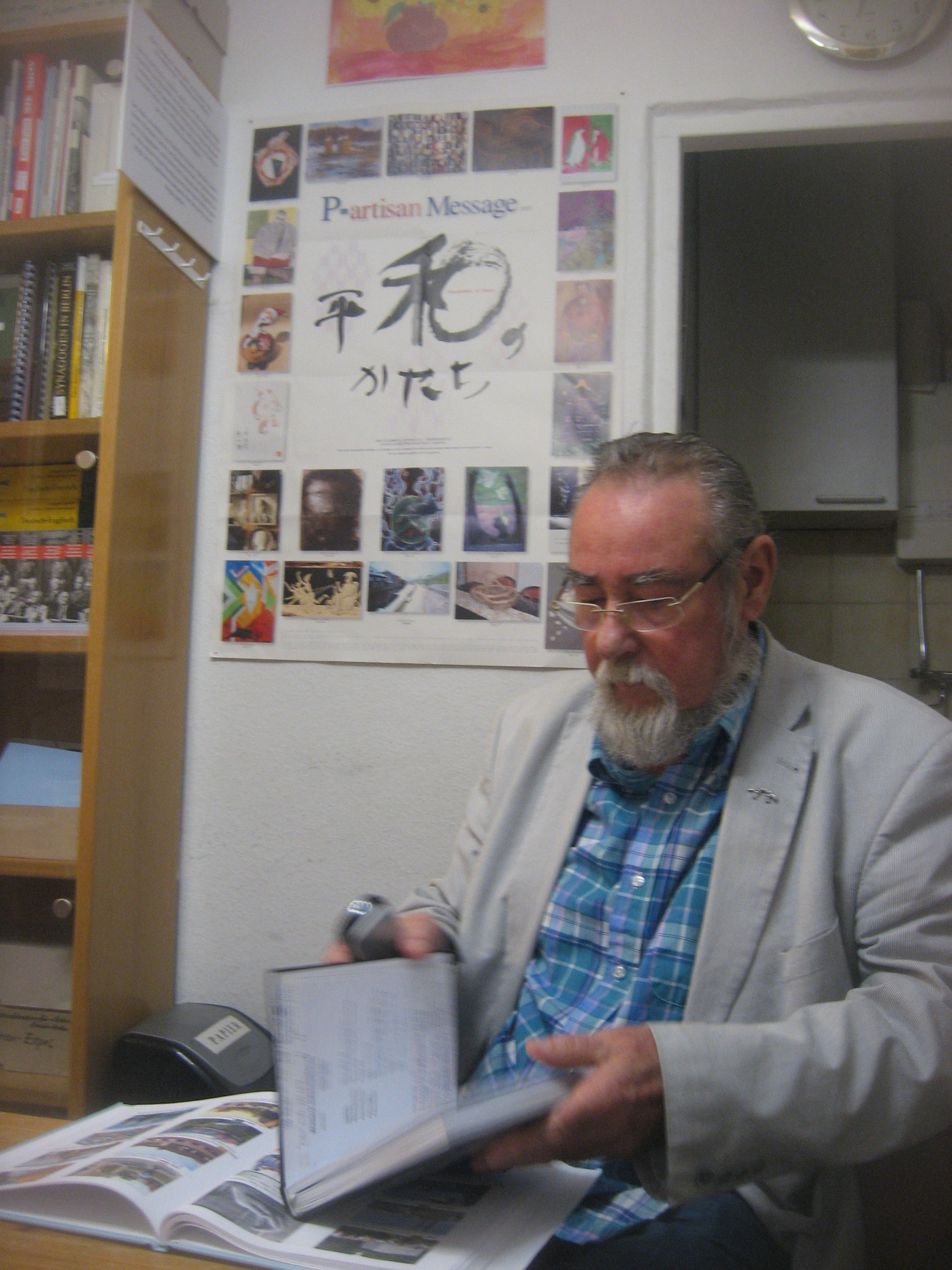

 | Tommy Spree in left image. Christian Bartolf in rightimage. Both images made 6 Sept 2013 at Anti-Kriegs-Museum.
|
 |  1985 - Schwules Museum (Gay Museum), Mehringdamm 61, Kreuzberg district, Berlin (Germany). "Founded after a successful exhibition on gay topics at the Berlin Museum (Märkisches Museum) in summer 1984, Eldorado, the first public exposition in Germany of recent research on gay life. Located above a gay nightclub. The world's first gay museum. Since December 2004, the permanent exhibition has been Selbstbewusstsein und Beharrlichkeit. 200 Jahre schwule Geschichte ("Self-Awareness and Endurance: 200 Years of Gay History")." 1985 - Schwules Museum (Gay Museum), Mehringdamm 61, Kreuzberg district, Berlin (Germany). "Founded after a successful exhibition on gay topics at the Berlin Museum (Märkisches Museum) in summer 1984, Eldorado, the first public exposition in Germany of recent research on gay life. Located above a gay nightclub. The world's first gay museum. Since December 2004, the permanent exhibition has been Selbstbewusstsein und Beharrlichkeit. 200 Jahre schwule Geschichte ("Self-Awareness and Endurance: 200 Years of Gay History")."
|


|  1986 - Käthe-Kollwitz-Museum, Fasanenstraße 24, Berlin (Germany). "Has a collection of works by the artist, from the estate of the deceased in 1993, gallery owner and collector Hans Pels-Leusden. In a permanent exhibition on four floors of the museum is an important part of the work of Käthe Kollwitz, who fifty years has lived and worked in Berlin, exhibited.
The building in which the Kathe Kollwitz Museum is located, belongs to the adjacent Literaturhaus Berlin & Café Wintergarten called the Ensemble. To this complex is also the Villa Grisebach, a renowned gallery & auction house. [Google Translation from Dutch]" Information courtesy of Gerard Lössbroek. 1986 - Käthe-Kollwitz-Museum, Fasanenstraße 24, Berlin (Germany). "Has a collection of works by the artist, from the estate of the deceased in 1993, gallery owner and collector Hans Pels-Leusden. In a permanent exhibition on four floors of the museum is an important part of the work of Käthe Kollwitz, who fifty years has lived and worked in Berlin, exhibited.
The building in which the Kathe Kollwitz Museum is located, belongs to the adjacent Literaturhaus Berlin & Café Wintergarten called the Ensemble. To this complex is also the Villa Grisebach, a renowned gallery & auction house. [Google Translation from Dutch]" Information courtesy of Gerard Lössbroek.
|


|  1987 - Friedenstaube / Dove of Peace, Rathausstraße / City Hall Street, Nikolaivierte / Nikolai Quarter, East Berlin (Germany). Near Berliner Fernsehturm / Berlin TV Tower. Sign on apartment building reads "Berlin - Stadt des Friedens / Berlin - City of Peace." Emblem is peace dove as drawn by Picasso. "By Gerhard Thieme. Given to the eastern part of Berlin by the (socialist) World Council." /// "The line 'Berlin, City of Peace' was the heartfelt wish of the head of state. It was selected by him personally, by Erich Honecker [1912-1994], that is. To me, the inscription seemed cynical. Peace reigned in the GDR but it was a graveyard peace. I think it’s a shame that it was removed because it provided a starting-point for discussion." /// "[In 1987,] all of Berlin celebrated the 750 year anniversary of the city. East Berlin even rebuilt & reconstructed for the event the cradle of Berlin, the Nicolai quarter, and put at one of the building walls beneath a dove in big letters 'Berlin – City of Peace.'" 1987 - Friedenstaube / Dove of Peace, Rathausstraße / City Hall Street, Nikolaivierte / Nikolai Quarter, East Berlin (Germany). Near Berliner Fernsehturm / Berlin TV Tower. Sign on apartment building reads "Berlin - Stadt des Friedens / Berlin - City of Peace." Emblem is peace dove as drawn by Picasso. "By Gerhard Thieme. Given to the eastern part of Berlin by the (socialist) World Council." /// "The line 'Berlin, City of Peace' was the heartfelt wish of the head of state. It was selected by him personally, by Erich Honecker [1912-1994], that is. To me, the inscription seemed cynical. Peace reigned in the GDR but it was a graveyard peace. I think it’s a shame that it was removed because it provided a starting-point for discussion." /// "[In 1987,] all of Berlin celebrated the 750 year anniversary of the city. East Berlin even rebuilt & reconstructed for the event the cradle of Berlin, the Nicolai quarter, and put at one of the building walls beneath a dove in big letters 'Berlin – City of Peace.'"
|

 |  1987 - "Berlin," Tauentzienstraße, western Berlin (Germany). "Sculpture unveiled by husband-and-wife Brigitte Denninghoff & Martin Matschinsky in front of the Kaiser-Wilhelm-Gedächtniskirche. Its principal motif, a 'broken chain,' symbolizes the severed connections between West & East Berlin due to the construction of the Berlin Wall. One of 8 sculptures designed during 'Skulpturenboulevard Kurfürstendamm / Boulevard of Sculptures: Kurfürstendamm,' an event commissioned by the city of West Berlin to celebrate Berlin's 750th anniversary in 1987. Of the 8 sculptures unveiled, three were allowed to remain past the anniversary year (Berlin, Pyramide & Cadillacs in Form der nackten Maja)." 1987 - "Berlin," Tauentzienstraße, western Berlin (Germany). "Sculpture unveiled by husband-and-wife Brigitte Denninghoff & Martin Matschinsky in front of the Kaiser-Wilhelm-Gedächtniskirche. Its principal motif, a 'broken chain,' symbolizes the severed connections between West & East Berlin due to the construction of the Berlin Wall. One of 8 sculptures designed during 'Skulpturenboulevard Kurfürstendamm / Boulevard of Sculptures: Kurfürstendamm,' an event commissioned by the city of West Berlin to celebrate Berlin's 750th anniversary in 1987. Of the 8 sculptures unveiled, three were allowed to remain past the anniversary year (Berlin, Pyramide & Cadillacs in Form der nackten Maja)."
|

|  June 12, 1987 - At the Brandenburg Gate, US President Ronald Reagan speaks to about 45,000 people, commemorating the Marshall plan’s anniversary, Berlin’s 750th birthday, President Kennedy’s famous speech in 1963 & his own special relationship with Berlin: "General Secretary Gorbachev, if you seek peace, if you seek prosperity for the Soviet Union and Eastern Europe, if you seek liberalization, come here to this gate. Mr. Gorbachev, open this gate. Mr. Gorbachev, tear down this wall!" June 12, 1987 - At the Brandenburg Gate, US President Ronald Reagan speaks to about 45,000 people, commemorating the Marshall plan’s anniversary, Berlin’s 750th birthday, President Kennedy’s famous speech in 1963 & his own special relationship with Berlin: "General Secretary Gorbachev, if you seek peace, if you seek prosperity for the Soviet Union and Eastern Europe, if you seek liberalization, come here to this gate. Mr. Gorbachev, open this gate. Mr. Gorbachev, tear down this wall!"

|
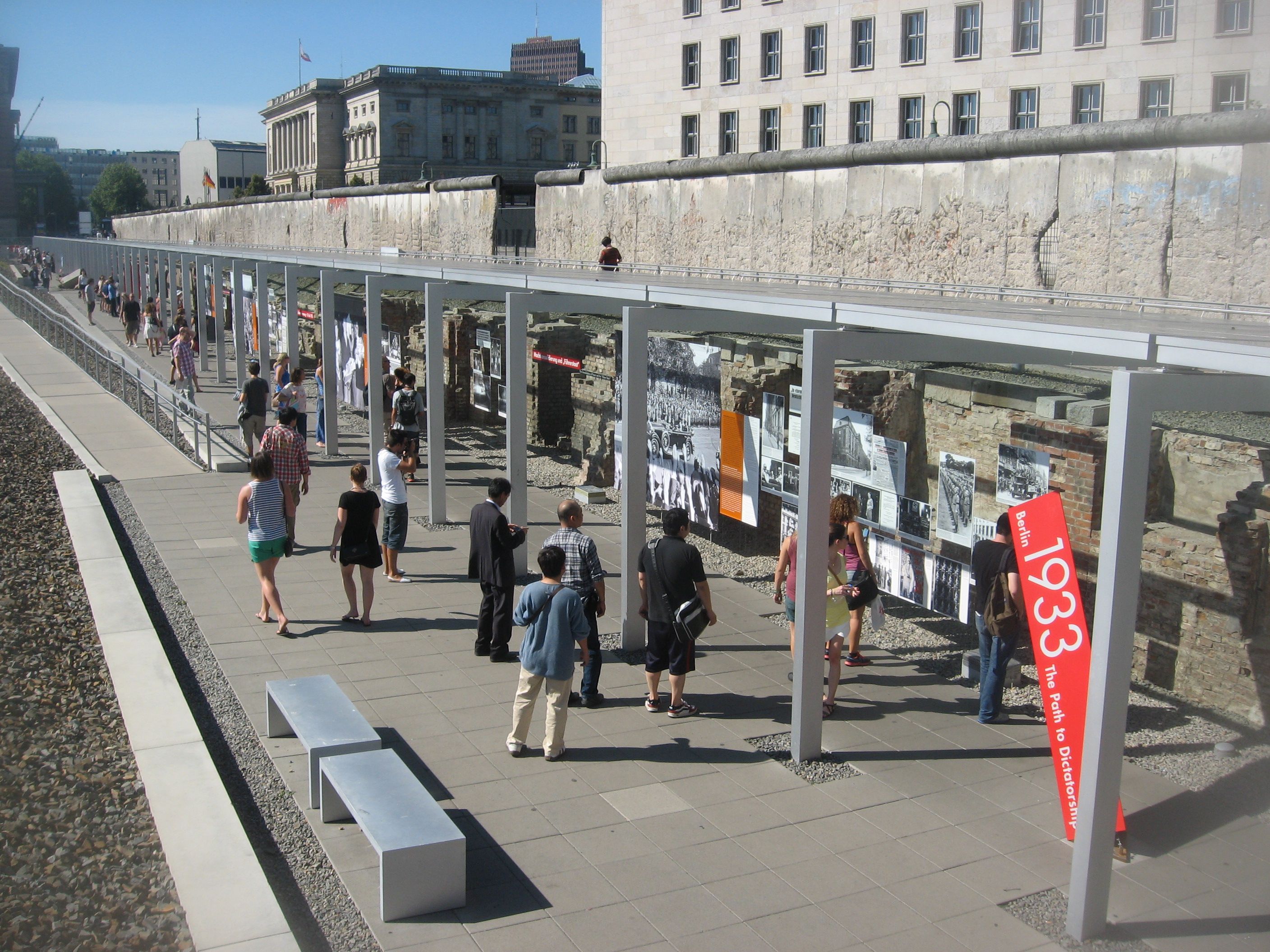 

| M
U
SE
U
M |  1987 - Stiftung Topographie des Terrors / Topography of Terror, Niederkirchnerstraße (former Prinz Albrecht Straße), Berlin (Germany). An outdoor museum located on the site of Gestapo & SS headquarters (1933-1945). Largely destroyed by Allied bombing in early 1945. Ruins demolished after the war.
The first exhibitions of the site took place in 1987 as part of Berlin's 750th anniversary. Cellar of the Gestapo headquarters, where many political prisoners were tortured & executed, were found & excavated. Site was then turned into a memorial & museum. In 1992, two years after German reunification, a foundation was established to take care of the site." After many delays, a new documentation center was opened in 2010 (qv). [Ian Buruma (1994), "The Wages of Guilt," pp. 206-9.] Left image by EWL. 1987 - Stiftung Topographie des Terrors / Topography of Terror, Niederkirchnerstraße (former Prinz Albrecht Straße), Berlin (Germany). An outdoor museum located on the site of Gestapo & SS headquarters (1933-1945). Largely destroyed by Allied bombing in early 1945. Ruins demolished after the war.
The first exhibitions of the site took place in 1987 as part of Berlin's 750th anniversary. Cellar of the Gestapo headquarters, where many political prisoners were tortured & executed, were found & excavated. Site was then turned into a memorial & museum. In 1992, two years after German reunification, a foundation was established to take care of the site." After many delays, a new documentation center was opened in 2010 (qv). [Ian Buruma (1994), "The Wages of Guilt," pp. 206-9.] Left image by EWL. 
|

|  1989 - Monument, Mahn- und Gedenkstätte Ravensbrück at Ravensbrück Concentration Camp, Ravensbrück, Brandenberg (Germany). As depicted on an East German postage stamp. 1989 - Monument, Mahn- und Gedenkstätte Ravensbrück at Ravensbrück Concentration Camp, Ravensbrück, Brandenberg (Germany). As depicted on an East German postage stamp.

|
![]() | M A H N M A L
 1988 - Mahnmal in der Levetzowstraße, Levetzowstraße, Berlin-Moabit (Germany). "In Levetzowstraße in Berlin-Moabit, there was one of the largest synagogues in Berlin. The Nazis taught there 1941, a transit camp for Jews in Berlin, which they subsequently deported to the East. At the site of the synagogue destroyed in the war since 1988, remembers a memorial to the deported Jews in Berlin." [Google translation]. /// Near flat of Christian Bartolf. 1988 - Mahnmal in der Levetzowstraße, Levetzowstraße, Berlin-Moabit (Germany). "In Levetzowstraße in Berlin-Moabit, there was one of the largest synagogues in Berlin. The Nazis taught there 1941, a transit camp for Jews in Berlin, which they subsequently deported to the East. At the site of the synagogue destroyed in the war since 1988, remembers a memorial to the deported Jews in Berlin." [Google translation]. /// Near flat of Christian Bartolf.
|
 November 9, 1989 - Fall of the Berliner Mauer / Berlin Wall.
November 9, 1989 - Fall of the Berliner Mauer / Berlin Wall.
 
 |  1990 - East Side Gallery, Muhlenstresse, Friedrichshain, Berlin (Germany). "Stretching for over 4,265 feet, this is the world's largest outdoor art gallery. In 1990, 106 artists from Berlin & all over the world used the East side of the Wall as a vast blank page. Fresco after fresco has created a cavalcade of colors. Damaged by the weather & by tourists who try desperately to pull away fragments, they are gtradually being restored." /// See Note about the East Side Gallery at the end of this webpage. 1990 - East Side Gallery, Muhlenstresse, Friedrichshain, Berlin (Germany). "Stretching for over 4,265 feet, this is the world's largest outdoor art gallery. In 1990, 106 artists from Berlin & all over the world used the East side of the Wall as a vast blank page. Fresco after fresco has created a cavalcade of colors. Damaged by the weather & by tourists who try desperately to pull away fragments, they are gtradually being restored." /// See Note about the East Side Gallery at the end of this webpage.
|
 
 |  1990 - "The Missing House," Gedenkstätte Große Hamburger Straße, Scheunenviertel, Berlin (Germany).
At 15-16 Große Hamburger Straße. "This apartment house was destroyed by aerial bombardment in February 1945. In 1990, French artist Christian Boltanski & his students found that all the former residents were Jews & constructed a memorial space dedicated to 'absence.' The signs indicate the names of the residents & approximate place where they lived in the building, their dates of birth & death, and occupations, which went across class lines.
Plaques indicate the approximate space occupied by Jewish and non-Jewish residents, testifying to a diversity that was lost with Nazi decrees against the Jews and removal of the Jewish population from Berlin." 1990 - "The Missing House," Gedenkstätte Große Hamburger Straße, Scheunenviertel, Berlin (Germany).
At 15-16 Große Hamburger Straße. "This apartment house was destroyed by aerial bombardment in February 1945. In 1990, French artist Christian Boltanski & his students found that all the former residents were Jews & constructed a memorial space dedicated to 'absence.' The signs indicate the names of the residents & approximate place where they lived in the building, their dates of birth & death, and occupations, which went across class lines.
Plaques indicate the approximate space occupied by Jewish and non-Jewish residents, testifying to a diversity that was lost with Nazi decrees against the Jews and removal of the Jewish population from Berlin." 
|
 October 3, 1990 - Reunification of Germany. (Tag der deutschen Einheit / Day of National Unity, official German national holiday.)
October 3, 1990 - Reunification of Germany. (Tag der deutschen Einheit / Day of National Unity, official German national holiday.)
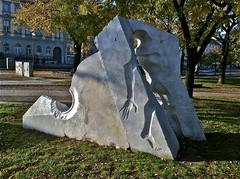


| D E N K M A L
 September 2, 1990 - Das Bonner Denkmal für die unbekannten Deserteure / The Bonn Monument to the Unknown Deserters, Platz der Einheit / Unity Square, Potsdam (Germany). Click here for second source of information. Made in 1989 by Turkish sculptor Mehmet Aksoy for Bonn, but the Lord Mayor of Bonn (Potsdam's sister city) prevented the establishment of the monument in a public space in Bonn. So it was loaned to Potsdam. [Google translation paraphrased]" [Information courtesy of Gerard Lössbroek, Nov. 5, 2011] /// "The figure in this memorial is carved in negative relief, a technique that Aksoy employed in later work." September 2, 1990 - Das Bonner Denkmal für die unbekannten Deserteure / The Bonn Monument to the Unknown Deserters, Platz der Einheit / Unity Square, Potsdam (Germany). Click here for second source of information. Made in 1989 by Turkish sculptor Mehmet Aksoy for Bonn, but the Lord Mayor of Bonn (Potsdam's sister city) prevented the establishment of the monument in a public space in Bonn. So it was loaned to Potsdam. [Google translation paraphrased]" [Information courtesy of Gerard Lössbroek, Nov. 5, 2011] /// "The figure in this memorial is carved in negative relief, a technique that Aksoy employed in later work."
| 
| P L A Q U E
"[This image] is a plaque in front of the memorial 'for the unknown deserters;' the plaque has a nice 1925 poem by Kurt Tucholsky [1890-1935]."
|

|  November 7, 1990 - Stasi-Museum Berlin, Haus 1 wiedereröffnet
/ House 1 - headquarter of the State Security, Ruschestraße 103, 10365 Berlin (Germany). "Considering itself the "shield and sword of the party" it was from this compound that the Stasi conducted its nearly 40-year-long fight against the so called enemies of the Socialist Unity Party of Germany (SED) - against those who refused to follow the guidelines of the regime, against those who did not conform to its ideas of a human being.
The centrepiece of the highly secured compound was "house 1", constructed in 1960. It was built as the seat of the offices of the Minister of State Security. From 1957 to 1989 the head of the Stasi was Erich Mielke.
After citizens occupied the premises in January 1990, the Association for Anti-Stalinist Action (ASTAK e.V.) opened "house 1" on the 7th of November 1990 as research and memorial site. The former headquarters of the secret police were now open to the public. The minister's offices ("the Mielke suite"), the offices of those of his inner circle as well as the conference room and lounge have been almost completely preserved in their original condition.
After substantial renovation, "house 1" was reopened in January 2012 with temporary exhibitions provided by the Federal Commissioner for the Stasi Records (BStU) and ASTAK e.V. A new joint permanent exhibition "State Security in the GDR" is in preparation an sheduled to open by the end of 2013." /// Information courtesy of Christian Bartolf. November 7, 1990 - Stasi-Museum Berlin, Haus 1 wiedereröffnet
/ House 1 - headquarter of the State Security, Ruschestraße 103, 10365 Berlin (Germany). "Considering itself the "shield and sword of the party" it was from this compound that the Stasi conducted its nearly 40-year-long fight against the so called enemies of the Socialist Unity Party of Germany (SED) - against those who refused to follow the guidelines of the regime, against those who did not conform to its ideas of a human being.
The centrepiece of the highly secured compound was "house 1", constructed in 1960. It was built as the seat of the offices of the Minister of State Security. From 1957 to 1989 the head of the Stasi was Erich Mielke.
After citizens occupied the premises in January 1990, the Association for Anti-Stalinist Action (ASTAK e.V.) opened "house 1" on the 7th of November 1990 as research and memorial site. The former headquarters of the secret police were now open to the public. The minister's offices ("the Mielke suite"), the offices of those of his inner circle as well as the conference room and lounge have been almost completely preserved in their original condition.
After substantial renovation, "house 1" was reopened in January 2012 with temporary exhibitions provided by the Federal Commissioner for the Stasi Records (BStU) and ASTAK e.V. A new joint permanent exhibition "State Security in the GDR" is in preparation an sheduled to open by the end of 2013." /// Information courtesy of Christian Bartolf. |


| S
Q
U
A
RE |   1992 - Platz der Vereinten Nationen / United Nations Square, Landsberger Allee & Lichtenberger Strasse, Friedrichshain, Berlin (Germany). East of Alexanderplatz. Named Landsberger Platz 1864-1950 and Leninplatz 1950-1992. The square contained 19 meter Lenindenkmal / Lenin Monument (upper image) designed by Nikolai Tomski (president of the Academy of Arts, USSR) from 1970 until 1991 when the district of Friedrichshain voted 40 to 13 to demolish it. On 13 November the 3.5-ton head was removed, as depicted in the film Good Bye, Lenin! 129 parts were buried in the sand pit at Seddinberg at Berlin- Müggelheim. A fountain (lower image) designed by Adalbert Maria Klees replaced the monument in 1994. 1992 - Platz der Vereinten Nationen / United Nations Square, Landsberger Allee & Lichtenberger Strasse, Friedrichshain, Berlin (Germany). East of Alexanderplatz. Named Landsberger Platz 1864-1950 and Leninplatz 1950-1992. The square contained 19 meter Lenindenkmal / Lenin Monument (upper image) designed by Nikolai Tomski (president of the Academy of Arts, USSR) from 1970 until 1991 when the district of Friedrichshain voted 40 to 13 to demolish it. On 13 November the 3.5-ton head was removed, as depicted in the film Good Bye, Lenin! 129 parts were buried in the sand pit at Seddinberg at Berlin- Müggelheim. A fountain (lower image) designed by Adalbert Maria Klees replaced the monument in 1994. 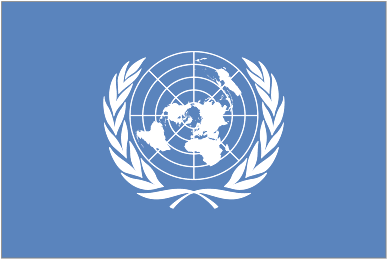
|


| H
OU
S
E | M
U
S
E
U
M |  1992 - Gedenk- und Bildungsstätte / Memorial & Educational Site, Villa an Wannsee / Wannsee Villa, Wannsee, Berlin (Germany). An unintentional monument since 1942. A holocaust memorial since 1992. The Joseph Wulf Bibliothek/Mediothek on the second floor holds thousands of books on Nazism, anti-Semitism, and the Jewish genocide, along with many videos, microfilm texts, and original Nazi era documents. Joseph Wulf [1912-1974] was a German-Polish-Jewish historian and Holocaust survivor who tried in 1965 to create a Holocaust memorial and document center in this house. The Wannsee Conference took place here on January 20, 1942, at which Reinhard Heydrich [1804-1942] announced Hitler's decision to murder the Jews of Europe. See Video & Website. 1992 - Gedenk- und Bildungsstätte / Memorial & Educational Site, Villa an Wannsee / Wannsee Villa, Wannsee, Berlin (Germany). An unintentional monument since 1942. A holocaust memorial since 1992. The Joseph Wulf Bibliothek/Mediothek on the second floor holds thousands of books on Nazism, anti-Semitism, and the Jewish genocide, along with many videos, microfilm texts, and original Nazi era documents. Joseph Wulf [1912-1974] was a German-Polish-Jewish historian and Holocaust survivor who tried in 1965 to create a Holocaust memorial and document center in this house. The Wannsee Conference took place here on January 20, 1942, at which Reinhard Heydrich [1804-1942] announced Hitler's decision to murder the Jews of Europe. See Video & Website. 
| 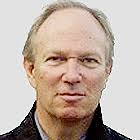 | B
O
OK |
 Ian Buruma (1994), "The Wages of Guilt: Memories of War in Germany & Japan," pp. 204, 237-8. According to Buruma, "the problem with the Wannsee Villa is the ambiguity as to whether it is a museum or a memorial. Presumably it is both, which is the core of the problem. You can remember the Holocaust through art, through ceremony, or through analysis and discourse, but you cannot do all this at the same time, or in the same place..." Ian Buruma (1994), "The Wages of Guilt: Memories of War in Germany & Japan," pp. 204, 237-8. According to Buruma, "the problem with the Wannsee Villa is the ambiguity as to whether it is a museum or a memorial. Presumably it is both, which is the core of the problem. You can remember the Holocaust through art, through ceremony, or through analysis and discourse, but you cannot do all this at the same time, or in the same place..."
|


|
P
L
A
Q
U
E |  May 8, 1995 -
Gedenktafel / Plaque, Bad Waldsee (Germany). Commemorates "50 years of peace" (1945-1995). May 8, 1945, was Victory in Europe Day (V-E Day or VE Day), the date when the World War II Allies formally accepted the unconditional surrender of the armed forces of Nazi Germany and the end of Adolf Hitler's Third Reich. May 8, 1995 -
Gedenktafel / Plaque, Bad Waldsee (Germany). Commemorates "50 years of peace" (1945-1995). May 8, 1945, was Victory in Europe Day (V-E Day or VE Day), the date when the World War II Allies formally accepted the unconditional surrender of the armed forces of Nazi Germany and the end of Adolf Hitler's Third Reich.
|

| W
A
L
L |  Date? - Plötzensee Memorial Wall, Gedenkstätte Plötzensee / Plötzensee Memorial Center, Charlottenburg-Nord, Berlin (Germany). In Plötzensee Prison. Inscribed Den Opfern der Hitlerdiktatur der Jahre 1933-1945." Commemorates the victims of National Socialism. From 1933 to 1945, nearly three thousand people unjustly sentenced to death by the Nazi judiciary were executed here. Today, the execution chamber is a memorial. The exhibition in the room adjoining it documents the practice of the Nazi judicial and penal systems. Date? - Plötzensee Memorial Wall, Gedenkstätte Plötzensee / Plötzensee Memorial Center, Charlottenburg-Nord, Berlin (Germany). In Plötzensee Prison. Inscribed Den Opfern der Hitlerdiktatur der Jahre 1933-1945." Commemorates the victims of National Socialism. From 1933 to 1945, nearly three thousand people unjustly sentenced to death by the Nazi judiciary were executed here. Today, the execution chamber is a memorial. The exhibition in the room adjoining it documents the practice of the Nazi judicial and penal systems.

|


| C
E
N
T
E
R |  Date? -
Hermann Stöhr Community Center, Angerburger Allee 56, Berlin (Germany). Municipal office, a worship room, and nursery named tor Christian martyr Dr. Hermann Stöhr [1898-1940], a German pacifist and resistance fighter against the Nazis, who was beheaded in Plötzensee Prison. Date? -
Hermann Stöhr Community Center, Angerburger Allee 56, Berlin (Germany). Municipal office, a worship room, and nursery named tor Christian martyr Dr. Hermann Stöhr [1898-1940], a German pacifist and resistance fighter against the Nazis, who was beheaded in Plötzensee Prison.
|
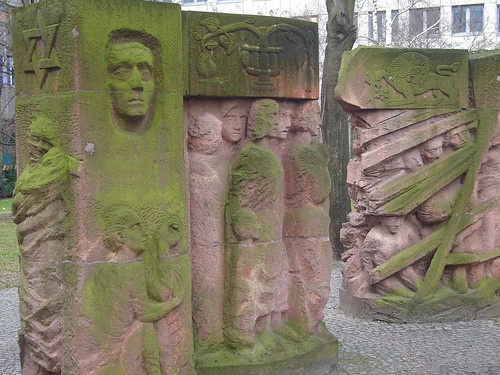 
 |  1995 - Rosenstrasse Monument, in a park on Rosenstrasse, old Jewish quarter, Berlin (Germany). "A group of sculptures commemorating the German women who successfully freed their husbands [during WW-II] through non-violent protests. More than 1,700 Jewish men were rescued after being held by the Gestapo to be deported. Sculpted in the mid-1980's by Ingeborg Hunzinger who named it Block der Frauen / Block of Women. Moved to the park in 1995." Click here for an essay about this monument. 1995 - Rosenstrasse Monument, in a park on Rosenstrasse, old Jewish quarter, Berlin (Germany). "A group of sculptures commemorating the German women who successfully freed their husbands [during WW-II] through non-violent protests. More than 1,700 Jewish men were rescued after being held by the Gestapo to be deported. Sculpted in the mid-1980's by Ingeborg Hunzinger who named it Block der Frauen / Block of Women. Moved to the park in 1995." Click here for an essay about this monument.

|



| P
L
A
Q
U
E |  January 4, 1998 -
Hermann Stöhr Memorial, Hauptbahnhof, Berlin (Germany). Seven-ton boulder with a commemorative plaque. Dr. Hermann Stöhr [1898-1940] was was a German pacifist & resistance fighter against the Nazis. He was sentenced to death as a conscientious objector, but the sentence was annuled, one of the rare times this happened in Nazi Germany. Memorial dedicated on Stöhr's 100th birthday. January 4, 1998 -
Hermann Stöhr Memorial, Hauptbahnhof, Berlin (Germany). Seven-ton boulder with a commemorative plaque. Dr. Hermann Stöhr [1898-1940] was was a German pacifist & resistance fighter against the Nazis. He was sentenced to death as a conscientious objector, but the sentence was annuled, one of the rare times this happened in Nazi Germany. Memorial dedicated on Stöhr's 100th birthday. 
|

|  January 27, 1998 - Gleis 17 Bahnhof Grunewald / Track 17 Grunewald Station, Grunewald station, Berlin (Germany). "Located on the western outskirts of Berlin. Between autumn 1941 and most probably spring 1942, deportation trains carrying Berlin Jews to ghettos & extermination camps in the east departed from this train station. The creation of the memorial was initiated by the Deutsche Bahn, the German national railway company, to commemorate the deportations undertaken by its predecessor, the Deutsche Reichsbahn." /// Information courtesy of Christian Bartolf. January 27, 1998 - Gleis 17 Bahnhof Grunewald / Track 17 Grunewald Station, Grunewald station, Berlin (Germany). "Located on the western outskirts of Berlin. Between autumn 1941 and most probably spring 1942, deportation trains carrying Berlin Jews to ghettos & extermination camps in the east departed from this train station. The creation of the memorial was initiated by the Deutsche Bahn, the German national railway company, to commemorate the deportations undertaken by its predecessor, the Deutsche Reichsbahn." /// Information courtesy of Christian Bartolf. |

| H
O
R
S
E
S |
 1998 - "The Day the Wall Came Down," Allied Museum, near Brandenburg Gate, Berlin (Germany). Given by the US government to the German people. Dedicated to freedom. A twin of the original bronze at the George H. Bush Presidential Library in College Station, Texas (USA). 1998 - "The Day the Wall Came Down," Allied Museum, near Brandenburg Gate, Berlin (Germany). Given by the US government to the German people. Dedicated to freedom. A twin of the original bronze at the George H. Bush Presidential Library in College Station, Texas (USA). 
|

| H
O
R
S
E
S |
  1997 - "The Day the Wall Came Down," George H. Bush Presidential Library, College Station, Texas (USA). Dedicated to freedom. Features five Mustangs jumping a crumbling Berlin Wall. A copy is at the Allied Museum, near Brandenburg Gate, Berlin (Germany). Sculpted by Veryl Goodnight (who lives in San Juan National Forest in Colorado). 1997 - "The Day the Wall Came Down," George H. Bush Presidential Library, College Station, Texas (USA). Dedicated to freedom. Features five Mustangs jumping a crumbling Berlin Wall. A copy is at the Allied Museum, near Brandenburg Gate, Berlin (Germany). Sculpted by Veryl Goodnight (who lives in San Juan National Forest in Colorado). 
|

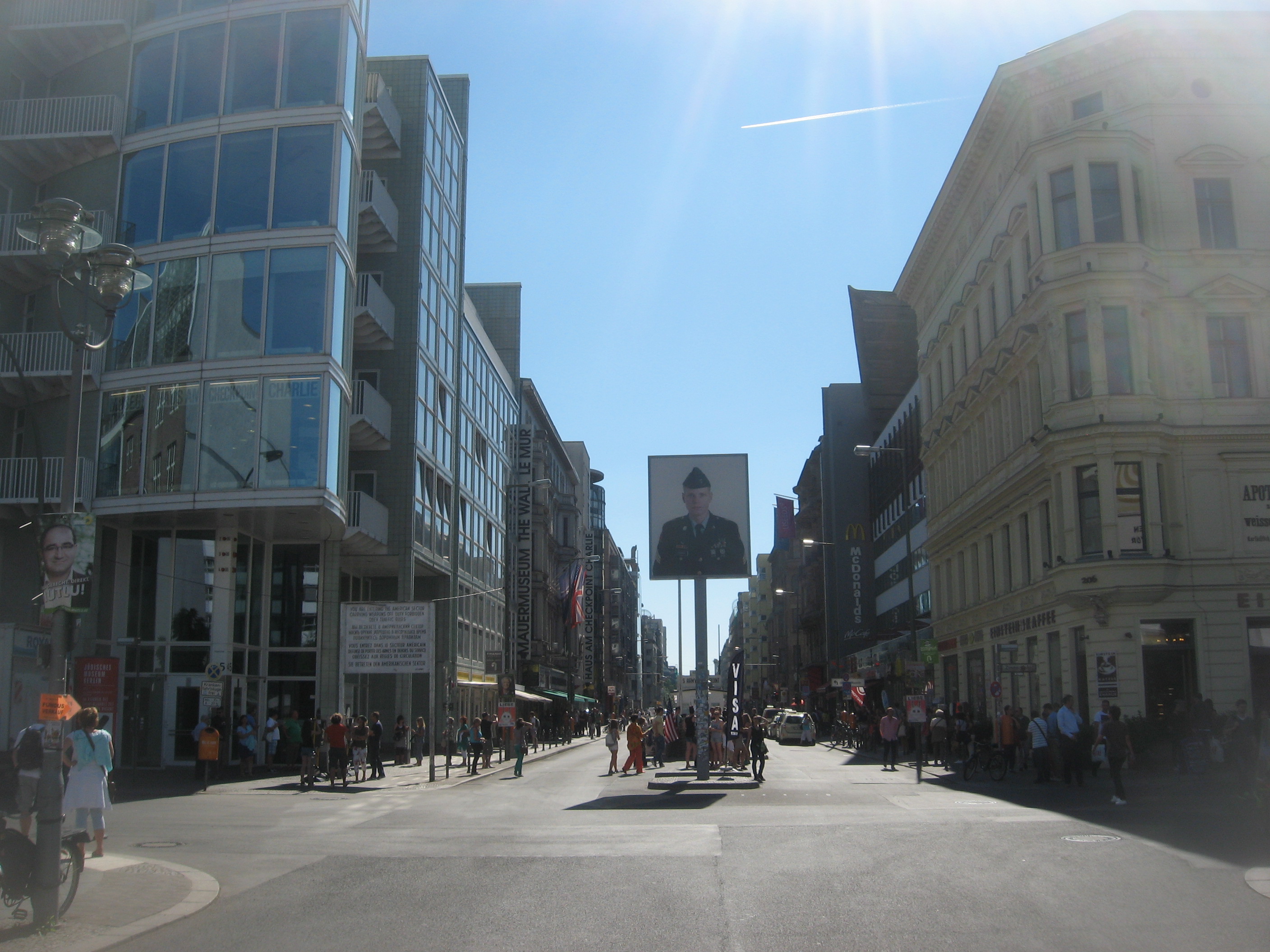


|  1998 - Light-box installation, Checkpoint Charlie, Friedrichstraße, Berlin (Germany). By Frank Thiel. Shows two larger-than-life color portraits. A young American & a young Soviet soldier each look into the other’s territory, thus marking the dividing line and crossing point between the former spheres of influence of the two world powers.
The photos were taken in 1994 before the Allied forces withdrew from Berlin. Since the Soviet Union disintegrated in 1991, the “Soviet” soldier is wearing the uniform of the new Russian federation. Frank Thiel, the artist, explained his design as follows:
"A Russian & an American soldier, since the Soviet sector bordered here on the American sector. At the same time, these portraits translate the omnipresent sector signs of the past – “You are leaving the American/British/French sector” – into picture form. They are likewise a reference to the historical moment when Soviet and American tanks faced off against each other right here." Middle image by EWL 6 Sept 2013. 1998 - Light-box installation, Checkpoint Charlie, Friedrichstraße, Berlin (Germany). By Frank Thiel. Shows two larger-than-life color portraits. A young American & a young Soviet soldier each look into the other’s territory, thus marking the dividing line and crossing point between the former spheres of influence of the two world powers.
The photos were taken in 1994 before the Allied forces withdrew from Berlin. Since the Soviet Union disintegrated in 1991, the “Soviet” soldier is wearing the uniform of the new Russian federation. Frank Thiel, the artist, explained his design as follows:
"A Russian & an American soldier, since the Soviet sector bordered here on the American sector. At the same time, these portraits translate the omnipresent sector signs of the past – “You are leaving the American/British/French sector” – into picture form. They are likewise a reference to the historical moment when Soviet and American tanks faced off against each other right here." Middle image by EWL 6 Sept 2013.
|
  

 |  1998 - Gedenkstätte Berliner Mauer / Berlin Wall Memorial, Dokumentationszentrum, Bernauer Straße 111/119
13355 Berlin (Germany). "The central memorial site of German division... Will eventually extend along 1.4 kilometers of the former border strip. Contains the last piece of Berlin Wall with the preserved grounds behind it & is thus able to convey an impression of how the border fortifications developed until the end of the 1980's." /// "An immaculate section of the Wall statnds between two huge sheets of metal, seemingly frozen forever in time. The information center opposite charts the history of the 'Antifascist Protection Wall' erected in 1961 by the DDR to prevent the mass exodus of its inhabitants." /// Includes: 1) Visitor Center, 2) Documentation Center,
3) Chapel of Reconciliation [qv], 4) Monument, 5) Window of Remembrance, 6) Exhibition "'Border Stations & Ghost Stations in Divided Berlin" in the Nordbahnhof rail station. 1998 - Gedenkstätte Berliner Mauer / Berlin Wall Memorial, Dokumentationszentrum, Bernauer Straße 111/119
13355 Berlin (Germany). "The central memorial site of German division... Will eventually extend along 1.4 kilometers of the former border strip. Contains the last piece of Berlin Wall with the preserved grounds behind it & is thus able to convey an impression of how the border fortifications developed until the end of the 1980's." /// "An immaculate section of the Wall statnds between two huge sheets of metal, seemingly frozen forever in time. The information center opposite charts the history of the 'Antifascist Protection Wall' erected in 1961 by the DDR to prevent the mass exodus of its inhabitants." /// Includes: 1) Visitor Center, 2) Documentation Center,
3) Chapel of Reconciliation [qv], 4) Monument, 5) Window of Remembrance, 6) Exhibition "'Border Stations & Ghost Stations in Divided Berlin" in the Nordbahnhof rail station.
|
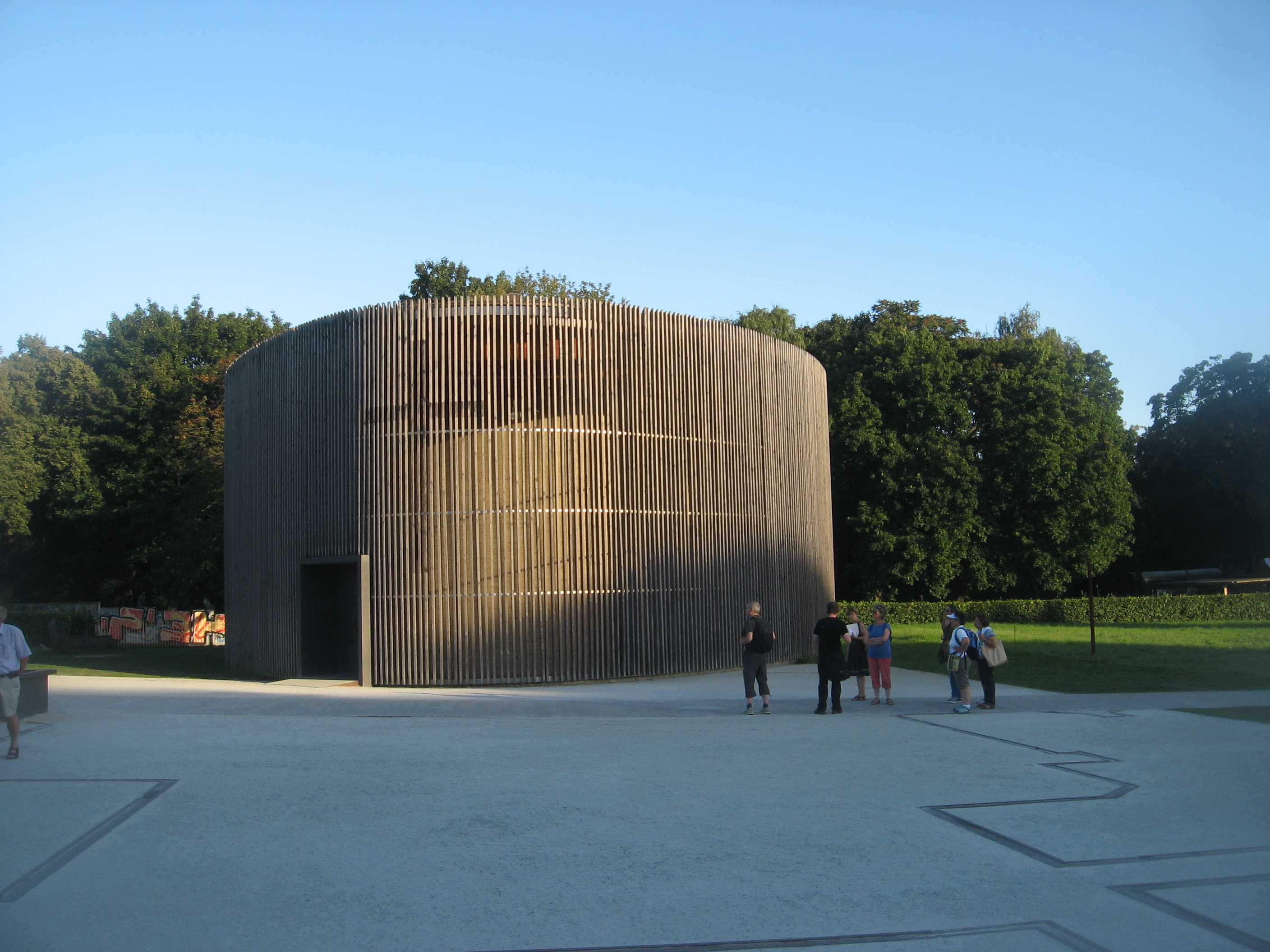 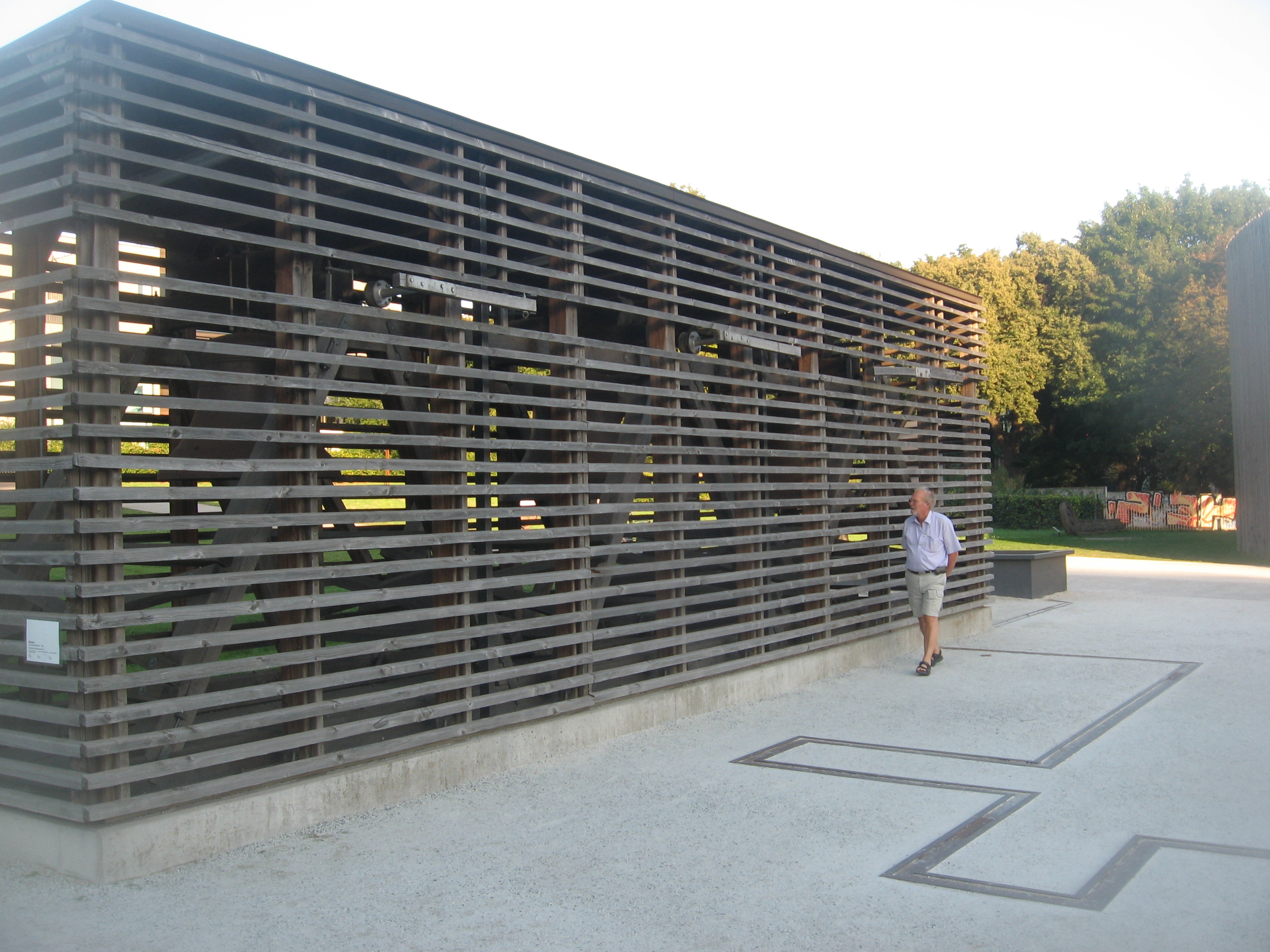
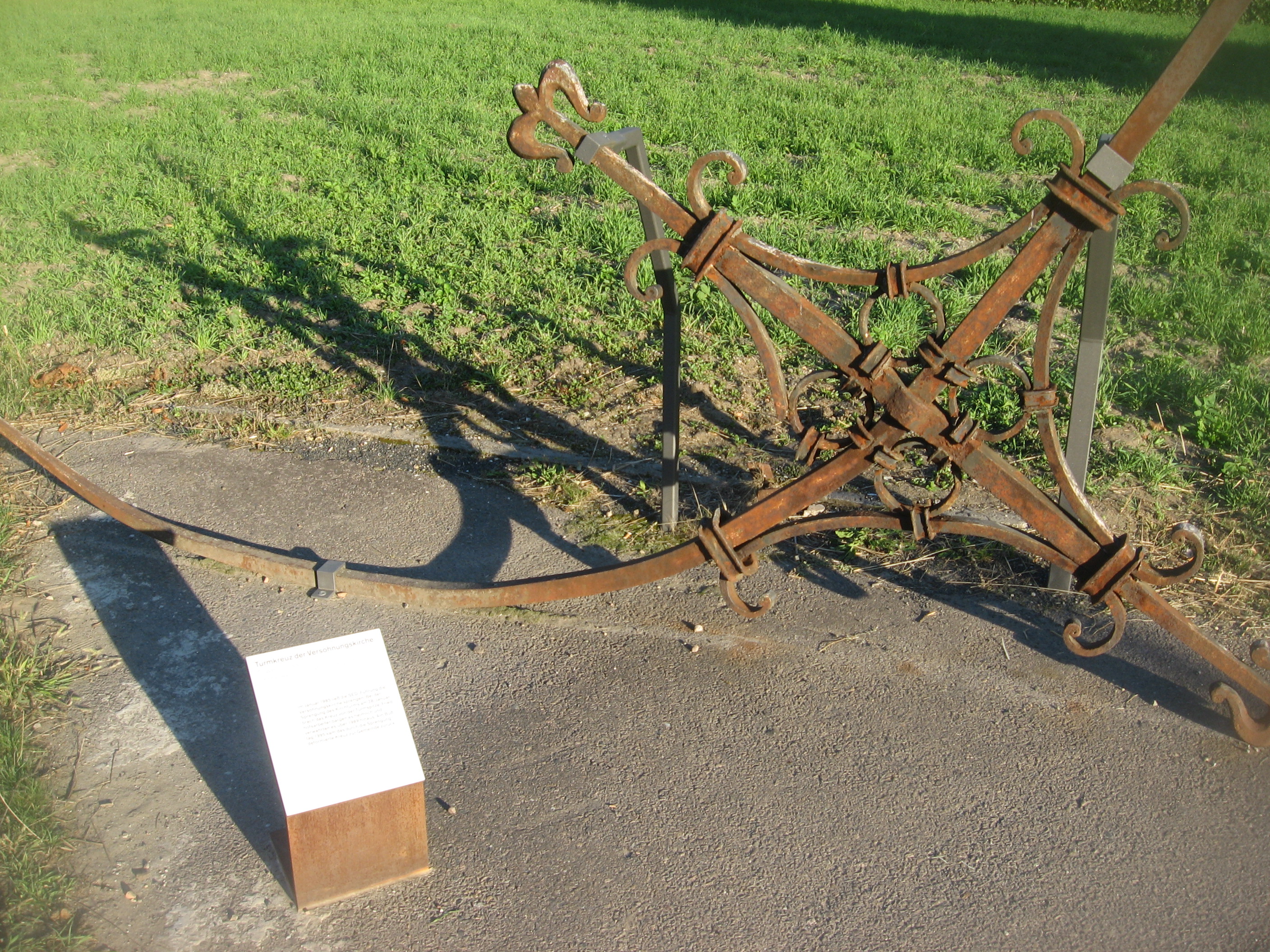
![]()
|  1999 - Kapelle der Versöhnung / Chapel of Reconciliation, Berlin Wall Memorial, Berlin (Germany). Built on the site of the Church of Reconciliation. Note steel markers in the ground tracing the outline of the former church. Middle image shows enclosure for the former church's 3 bells. Right image shows its twisted cross. Chapel contains reconstruction of the Cross of Nails in Coventry (England). "Reconciliaiton" by Josephina de Vasconcellos (qv) directly in front. All 3 images by EWL 7 Sept 2013. 1999 - Kapelle der Versöhnung / Chapel of Reconciliation, Berlin Wall Memorial, Berlin (Germany). Built on the site of the Church of Reconciliation. Note steel markers in the ground tracing the outline of the former church. Middle image shows enclosure for the former church's 3 bells. Right image shows its twisted cross. Chapel contains reconstruction of the Cross of Nails in Coventry (England). "Reconciliaiton" by Josephina de Vasconcellos (qv) directly in front. All 3 images by EWL 7 Sept 2013.
|
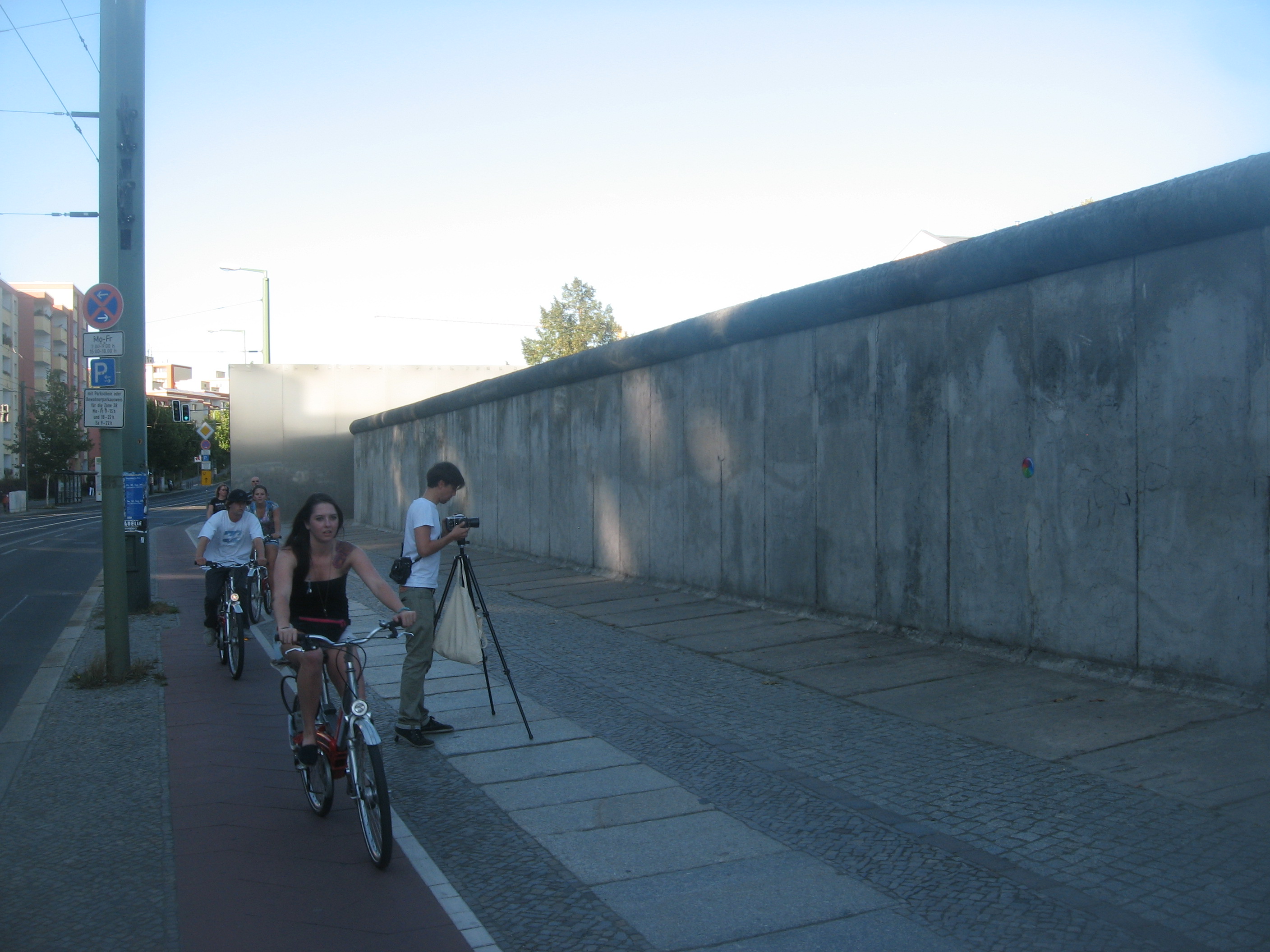 |  September 7, 2013 - Photographer Ossian Fraser testing the reflectivity of a section of the Berlin Wall. Image by EWL 7 Sept 2013. September 7, 2013 - Photographer Ossian Fraser testing the reflectivity of a section of the Berlin Wall. Image by EWL 7 Sept 2013.
|
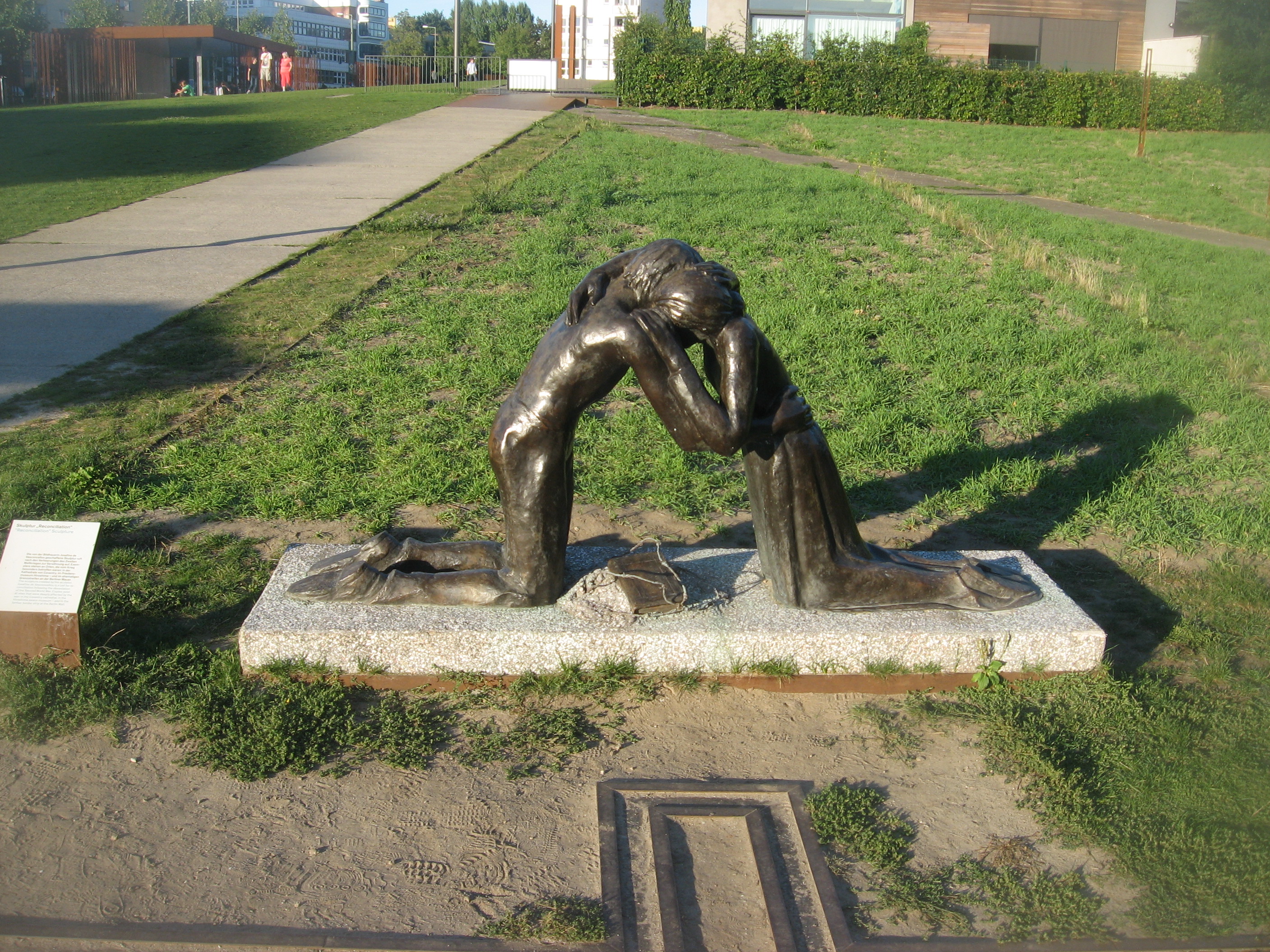
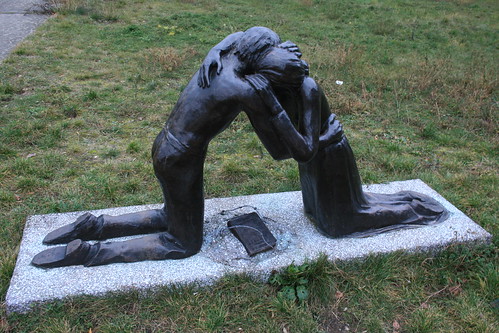
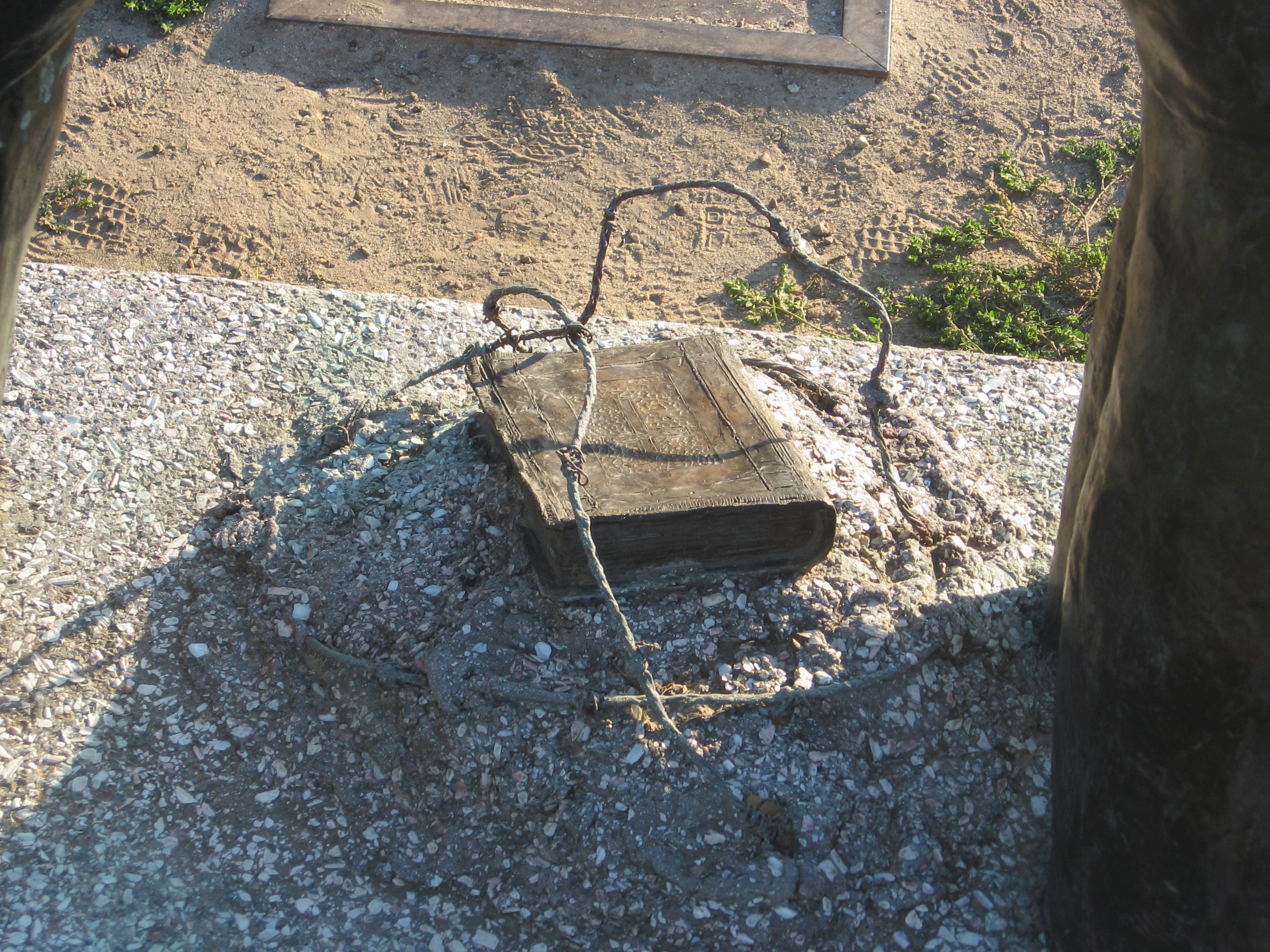
![]()
|  1999 - "Reconcilation," Kapelle der Versöhnung / Chapel of Reconciliation, Berlin Wall Memorial, Berlin (Germany). Sculpted by Josefina de Vasconcellos [1905-2005]. One of 5 duplicates. See others in Bradford & Coventry (England), Belfast (Northern Ireland) & Hiroshima (Japan). Right image shows Bible & barbed wire on ground between the two figures. /// See Church of Reconciliation1894-1985. /// Left & right images by EWL 7 Sept 2013. 1999 - "Reconcilation," Kapelle der Versöhnung / Chapel of Reconciliation, Berlin Wall Memorial, Berlin (Germany). Sculpted by Josefina de Vasconcellos [1905-2005]. One of 5 duplicates. See others in Bradford & Coventry (England), Belfast (Northern Ireland) & Hiroshima (Japan). Right image shows Bible & barbed wire on ground between the two figures. /// See Church of Reconciliation1894-1985. /// Left & right images by EWL 7 Sept 2013. 
|

|  July 12, 1995 - "Reconcilation," International Conference Center Hiroshima, Peace Memorial Park, Hiroshima (Japan). Statue by Josefina de Vasconcellos [1905-2005]. One of four copies of an original statue at University of Bradford (England). Click here to see all five statues. Image by EWL shows Prof. Peter Van Den Dungen, University of Bradford (far left), Schera Chadwick & Shigeko Uppuluri. Photo by EWL Oct 2008. July 12, 1995 - "Reconcilation," International Conference Center Hiroshima, Peace Memorial Park, Hiroshima (Japan). Statue by Josefina de Vasconcellos [1905-2005]. One of four copies of an original statue at University of Bradford (England). Click here to see all five statues. Image by EWL shows Prof. Peter Van Den Dungen, University of Bradford (far left), Schera Chadwick & Shigeko Uppuluri. Photo by EWL Oct 2008. 
|


 |  1999? - Photo exhibition in S-Bahn station building, Nordbanhof, Berlin (Germany). "About Berlin’s ghost stations & border stations in divided Berlin 1961-1990.
After the construction of the Berlin Wall in 1961, it was necessary to close some stations in order to prevent East Germans escaping through the tunnels & train tracks where East Berlin lines temporarily entered West Berlin.
Nordbahnhof was one such station. Station entrances were sealed, side tunnels were blocked, and trains passed through the former stations without stopping.
One of the exhibits here tells of the border guards who capitalised on their unique position to make their own escape. Once it was known that the guards themselves couldn’t be trusted, they observed the ghost stations from sealed units." 1999? - Photo exhibition in S-Bahn station building, Nordbanhof, Berlin (Germany). "About Berlin’s ghost stations & border stations in divided Berlin 1961-1990.
After the construction of the Berlin Wall in 1961, it was necessary to close some stations in order to prevent East Germans escaping through the tunnels & train tracks where East Berlin lines temporarily entered West Berlin.
Nordbahnhof was one such station. Station entrances were sealed, side tunnels were blocked, and trains passed through the former stations without stopping.
One of the exhibits here tells of the border guards who capitalised on their unique position to make their own escape. Once it was known that the guards themselves couldn’t be trusted, they observed the ghost stations from sealed units."
|
 Global Stone Project, Tiergarten Park, Berlin (Germany). Near the Goethe Denkmal & the Löwengruppe / Lions’ Group in the SE corner of Tiergarten park. Five stones, each weighing between 10 and 40 tons and corresponding to a “sister stone” on one of the five continents. The pairs of stones represent the five steps towards peace. Once a year on 21st June the light of the sun connects all ten [sic] stones by reflection. Wolfgang von Schwarzenfeld, sculptor & around the world navigator, began the Global Stone Project in 1997 in Venezuela.
Global Stone Project, Tiergarten Park, Berlin (Germany). Near the Goethe Denkmal & the Löwengruppe / Lions’ Group in the SE corner of Tiergarten park. Five stones, each weighing between 10 and 40 tons and corresponding to a “sister stone” on one of the five continents. The pairs of stones represent the five steps towards peace. Once a year on 21st June the light of the sun connects all ten [sic] stones by reflection. Wolfgang von Schwarzenfeld, sculptor & around the world navigator, began the Global Stone Project in 1997 in Venezuela.
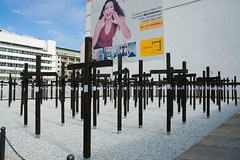

 |  October 2004-July 5, 2005 - Checkpoint Charlie Monument, Berlin (Germany). Commemorated the 15th anniversary of the fall of the Berlin Wall. Consisted of over 1,000 crosses adorned with the names of those murdered attempting to escape Communist East Germany for freedom during the Cold War. Torn down on July 5, 2005: "Berlin's Shame: We Will Never Forget!
We really don't have much left to say about this outrage. The anger inside all of us right now is simply too much. Even we believed that the city government and the bank would have the good sense to seek a compromise...but they didn't." /// Also called Freiheitsmahnmal / Freedom Memorial." October 2004-July 5, 2005 - Checkpoint Charlie Monument, Berlin (Germany). Commemorated the 15th anniversary of the fall of the Berlin Wall. Consisted of over 1,000 crosses adorned with the names of those murdered attempting to escape Communist East Germany for freedom during the Cold War. Torn down on July 5, 2005: "Berlin's Shame: We Will Never Forget!
We really don't have much left to say about this outrage. The anger inside all of us right now is simply too much. Even we believed that the city government and the bank would have the good sense to seek a compromise...but they didn't." /// Also called Freiheitsmahnmal / Freedom Memorial."
|

|  April 16-17, 2005 - Ravensbrück Memorial Site, Ravensbrück (Germany). 90 km (56 mi) north of Berlin. "A ceremony was held to commemorate the 60th anniversary of the concentration camp's liberation. Among those invited were around 600 survivors from all over the world, mostly eastern Europe. At the same time a new, permanent outdoor exhibition was opened, on the theme of the train transports to Ravensbrück. Its central exhibit is a refurbished goods wagon. The exhibition's information boards describe the origins of the transports & how they developed over time, and explain the different types of train, where they arrived and the part played by the local residents. It is probably the only exhibition so far at a German memorial which is dedicated solely to the subject of the transports to the camp." April 16-17, 2005 - Ravensbrück Memorial Site, Ravensbrück (Germany). 90 km (56 mi) north of Berlin. "A ceremony was held to commemorate the 60th anniversary of the concentration camp's liberation. Among those invited were around 600 survivors from all over the world, mostly eastern Europe. At the same time a new, permanent outdoor exhibition was opened, on the theme of the train transports to Ravensbrück. Its central exhibit is a refurbished goods wagon. The exhibition's information boards describe the origins of the transports & how they developed over time, and explain the different types of train, where they arrived and the part played by the local residents. It is probably the only exhibition so far at a German memorial which is dedicated solely to the subject of the transports to the camp."
|

|  2005 - "Das Gewehr Zerbrechen / Break the Gun," Ernst-Friedrich-Promenade, Berlin (Germany). Anti-war sculpture across the street from the Anti-Kriegs Museum / Anti-War Museum. Welded by Angelo Monitillo from found objects (breast is a shovel). Represents "broken rifle" logo created by Ernst Friedrich [1894-1967]. Information courtesy of Christian Bartolf. See Anti-Kriegs Museum (1982). 2005 - "Das Gewehr Zerbrechen / Break the Gun," Ernst-Friedrich-Promenade, Berlin (Germany). Anti-war sculpture across the street from the Anti-Kriegs Museum / Anti-War Museum. Welded by Angelo Monitillo from found objects (breast is a shovel). Represents "broken rifle" logo created by Ernst Friedrich [1894-1967]. Information courtesy of Christian Bartolf. See Anti-Kriegs Museum (1982).
|  | Similar but not the same as the logo of the War Resisters League.
|


|  2005 - "Non-Violence" by Carl Fredrik Reuterswärd, Parc des Bundeskanzleramt / Park of the Federal Chancellery, Berlin (Germany). Click here for similar monuments in France, Luxembourg, South Africa, Sweden, Switerland, UK & USA. 2005 - "Non-Violence" by Carl Fredrik Reuterswärd, Parc des Bundeskanzleramt / Park of the Federal Chancellery, Berlin (Germany). Click here for similar monuments in France, Luxembourg, South Africa, Sweden, Switerland, UK & USA.
|

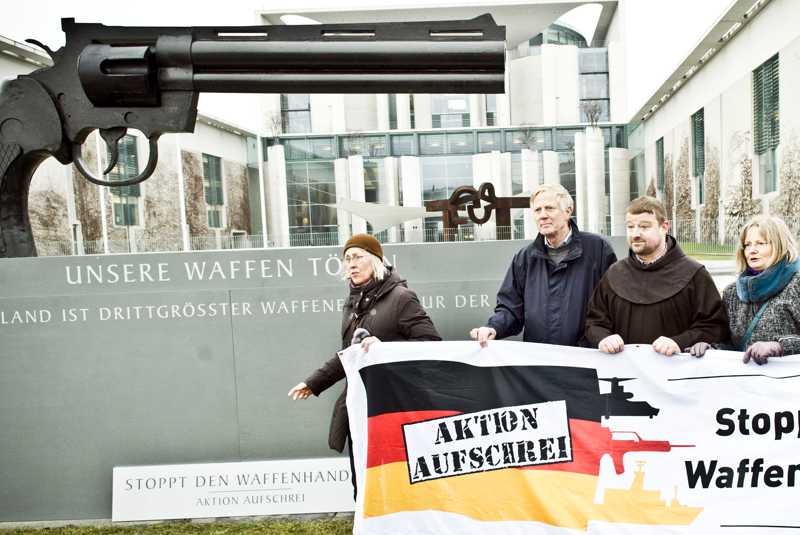
|  February 26, 2013 - "Unsere Waffen töten / Our Weapons Kill," Berlin (Germany). By Pax Christi & other peace groups.
"The federal government does not deserve the peace symbol of the knotted gun, because the truth does not twist: Germany is the world's third largest arms dealer.
The campaign 'Action outcry - Stop the arms trade' has given today in Berlin 'Our weapons kill' the morning of the federal government for its dubious merits in the defense export the sculpture. It represents an unknotted replica of the famous peace symbol of the knotted gun ...donated by the Federal Government in recognition of their non-participation in the Iraq war...
An unknotted gun we give this government. 'Our weapons kill' below it, for violence comes from Germany, for the sake of the love of money, "the Franciscan brother Jürgen Neitzert said at the unveiling of the sculpture..."
[Google translation] February 26, 2013 - "Unsere Waffen töten / Our Weapons Kill," Berlin (Germany). By Pax Christi & other peace groups.
"The federal government does not deserve the peace symbol of the knotted gun, because the truth does not twist: Germany is the world's third largest arms dealer.
The campaign 'Action outcry - Stop the arms trade' has given today in Berlin 'Our weapons kill' the morning of the federal government for its dubious merits in the defense export the sculpture. It represents an unknotted replica of the famous peace symbol of the knotted gun ...donated by the Federal Government in recognition of their non-participation in the Iraq war...
An unknotted gun we give this government. 'Our weapons kill' below it, for violence comes from Germany, for the sake of the love of money, "the Franciscan brother Jürgen Neitzert said at the unveiling of the sculpture..."
[Google translation]
|


|  April 24, 2006 - "Der moderne Buchdruck / The Modern Book Printing," Bebelplatz, ner Unter den Linden, Berlin (Germany). A stack of 17 books more than 12 meters in height (40 feet) and 35 tons in weight. Commemorates German writers, poets, and especially Johannes Gutenberg, the inventor of the modern book printing process about 1450 at Mainz. April 24, 2006 - "Der moderne Buchdruck / The Modern Book Printing," Bebelplatz, ner Unter den Linden, Berlin (Germany). A stack of 17 books more than 12 meters in height (40 feet) and 35 tons in weight. Commemorates German writers, poets, and especially Johannes Gutenberg, the inventor of the modern book printing process about 1450 at Mainz.

|
 

|  Date? -Gedenktafels / Memorial Plaques, Rostocker Straße 32, Berlin-Moabit (Germany). Marks home of Kurt Tucholsky [1890-1937], an important journalist & satirist of the Weimar Republic.
He warned against National Socialism, and his books were burned by the Nazis. There is also a plaque at his birthplace, Lübecker Straße 13. Date? -Gedenktafels / Memorial Plaques, Rostocker Straße 32, Berlin-Moabit (Germany). Marks home of Kurt Tucholsky [1890-1937], an important journalist & satirist of the Weimar Republic.
He warned against National Socialism, and his books were burned by the Nazis. There is also a plaque at his birthplace, Lübecker Straße 13. 
|

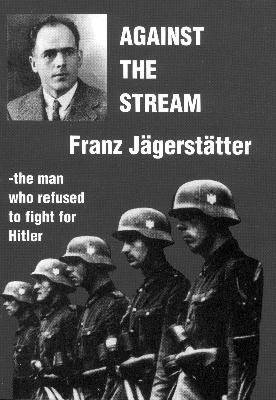

|  Date? -
Gedenktafel für Jägerstätter / Jägerstätter Memorial Plaque, Reichskriegsgericht, Berlin (Germany). At site of the former German military court. Franz Jägerstätter [1907-1943] was an Austrian conscientious objector sentenced to death (at this place) and executed by Nazi Germany during World War II. He was beatified by the Roman Catholic Church on October 26, 2007, in Linz (Austria). Date? -
Gedenktafel für Jägerstätter / Jägerstätter Memorial Plaque, Reichskriegsgericht, Berlin (Germany). At site of the former German military court. Franz Jägerstätter [1907-1943] was an Austrian conscientious objector sentenced to death (at this place) and executed by Nazi Germany during World War II. He was beatified by the Roman Catholic Church on October 26, 2007, in Linz (Austria). 
|

|  2008 - "Züge in das Leben – Züge in den Tod / Trains to Life - Trains to Death," Forecourt of the Friedrichstraße station, Berlin (Germany). Sulpture erected on one of the most central places in Berlin. Remembers the approximately 10,000 Jewish children who could flee from the German Reich to Great Britain between 1938 and 1939 by help of the Kindertransporte / Refugee Children's Movement." /// Information courtesy of Christian Bartolf. 2008 - "Züge in das Leben – Züge in den Tod / Trains to Life - Trains to Death," Forecourt of the Friedrichstraße station, Berlin (Germany). Sulpture erected on one of the most central places in Berlin. Remembers the approximately 10,000 Jewish children who could flee from the German Reich to Great Britain between 1938 and 1939 by help of the Kindertransporte / Refugee Children's Movement." /// Information courtesy of Christian Bartolf.  |

|  October 27, 2008 - Gedenkstätte Stille Helden / Silent Heroes Memorial Center, Rosenthaler Straße 39
10178 Berlin (Germany). - Resistance to Persecution of the Jews 1933-1945 (only german language website, but English language catalogue). "Commemorates those who supported persecuted Jews during the Nazi dictatorship. The example set by these helpers often referred to as 'silent heroes' shows that it was in fact possible to save people in Nazi Germany. In the German-occupied territories as well, despite the risk, individual Germans found the courage to exploit any leeway they had for maneuvering.
The permanent exhibition offers information about the persecution and hopeless situation of Jews in view of the impending deportations, about the decision by some to oppose the deadly threat by going into hiding, and about the actions and motives of the women and men who assisted them. Successful rescues are documented as well as failed attempts. The
center is maintained by the Stiftung Gedenkstätte Deutscher Widerstand / German Resistance Memorial Center Foundation." /// Information courtesy of Christian Bartolf. October 27, 2008 - Gedenkstätte Stille Helden / Silent Heroes Memorial Center, Rosenthaler Straße 39
10178 Berlin (Germany). - Resistance to Persecution of the Jews 1933-1945 (only german language website, but English language catalogue). "Commemorates those who supported persecuted Jews during the Nazi dictatorship. The example set by these helpers often referred to as 'silent heroes' shows that it was in fact possible to save people in Nazi Germany. In the German-occupied territories as well, despite the risk, individual Germans found the courage to exploit any leeway they had for maneuvering.
The permanent exhibition offers information about the persecution and hopeless situation of Jews in view of the impending deportations, about the decision by some to oppose the deadly threat by going into hiding, and about the actions and motives of the women and men who assisted them. Successful rescues are documented as well as failed attempts. The
center is maintained by the Stiftung Gedenkstätte Deutscher Widerstand / German Resistance Memorial Center Foundation." /// Information courtesy of Christian Bartolf.
|
 | P L A Q U E
 July 19, 2009 - Plaque at Birthplace of
Adam von Trott zu Solz [1909-1944], Henning von Tresckow Strasse, Potsdam (Germany). On a palace building near the Mercure Hotel. Text: "In diesem gebaude wurde am 9.8.1909 geboren Adam von Trott zu Solz widerstandskampfer gegen das NS-regime hingerichtet am 26.8.1944 in Berlin-Plotzensee." Google translation: "In this building was born on 08.09.1909 Adam von Trott zu Solz, resister against the Nazi regime executed on 26.08.1944 in Berlin-Plotzensee [Prison]." July 19, 2009 - Plaque at Birthplace of
Adam von Trott zu Solz [1909-1944], Henning von Tresckow Strasse, Potsdam (Germany). On a palace building near the Mercure Hotel. Text: "In diesem gebaude wurde am 9.8.1909 geboren Adam von Trott zu Solz widerstandskampfer gegen das NS-regime hingerichtet am 26.8.1944 in Berlin-Plotzensee." Google translation: "In this building was born on 08.09.1909 Adam von Trott zu Solz, resister against the Nazi regime executed on 26.08.1944 in Berlin-Plotzensee [Prison]."
|

| M
U
SE
U
M |  May 6, 2010 - Documentation Center, Topographie des Terrors / Topography of Terror, Berlin (German). "New exhibition & documentation building & redesigned historic grounds. Prize-winning design by architect Ursula Wilms (Heinle, Wischer und Partner, Berlin) & landscape architect Heinz W. Hallmann (Aachen). Opened by Federal President Horst Köhler on the occasion of the 65th anniversary of the end of World War II." See entry for 1987. May 6, 2010 - Documentation Center, Topographie des Terrors / Topography of Terror, Berlin (German). "New exhibition & documentation building & redesigned historic grounds. Prize-winning design by architect Ursula Wilms (Heinle, Wischer und Partner, Berlin) & landscape architect Heinz W. Hallmann (Aachen). Opened by Federal President Horst Köhler on the occasion of the 65th anniversary of the end of World War II." See entry for 1987. 
|

| S
Q
U
A
R
E |  July 25, 2010 -
Hiroshima-Platz, Truman House, Potsdam (Germany).
"During the Potsdam conference (July 17-August 2, 1945), President Truman signed an order on July 25 to drop atomic bombs on Japan, an act ushering in a world with nuclear weapons. The villa where Truman stayed during the Potsdam Conference remains as 'Truman House.' Five years ago the city parliament of Potsdam decided to name the grass field in front of the villa Hiroshima-Platz. Makoto Fujiwara, a Japanese sculptor based in Norway, made the memorial using stones from Hiroshima tram line and a stone from Sannou Shrine in Nagasaki, which is famous for the one-pillared torii gate representing the destruction of the city's atomic bombing.
There is a short inscription on the memorial, saying that the order to drop the atomic bombs was given in Potsdam and that the bombs brought death and dreadful suffering to hundreds of thousands of people. The memorial also expresses hope for a world free of nuclear weapons.
Though called a platz (plaza), the area is actually a quiet grass field surrounded by a forest." July 25, 2010 -
Hiroshima-Platz, Truman House, Potsdam (Germany).
"During the Potsdam conference (July 17-August 2, 1945), President Truman signed an order on July 25 to drop atomic bombs on Japan, an act ushering in a world with nuclear weapons. The villa where Truman stayed during the Potsdam Conference remains as 'Truman House.' Five years ago the city parliament of Potsdam decided to name the grass field in front of the villa Hiroshima-Platz. Makoto Fujiwara, a Japanese sculptor based in Norway, made the memorial using stones from Hiroshima tram line and a stone from Sannou Shrine in Nagasaki, which is famous for the one-pillared torii gate representing the destruction of the city's atomic bombing.
There is a short inscription on the memorial, saying that the order to drop the atomic bombs was given in Potsdam and that the bombs brought death and dreadful suffering to hundreds of thousands of people. The memorial also expresses hope for a world free of nuclear weapons.
Though called a platz (plaza), the area is actually a quiet grass field surrounded by a forest."
|
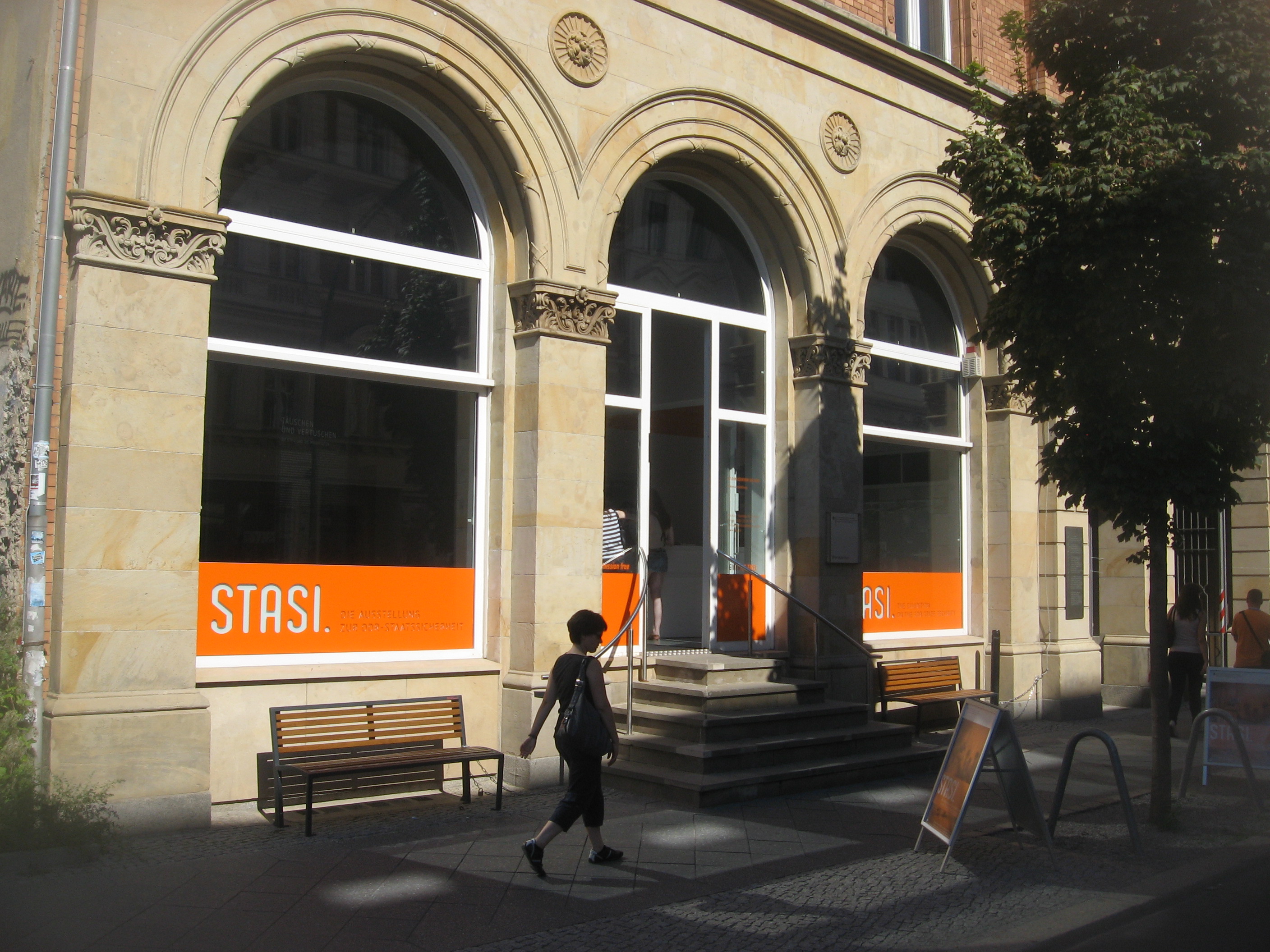


|  January 2011 - Education Centre of the BStU (STASI Museum), Zimmerstraße 90, Berlin (Germany). "The exhibition on the GDR's State Security." Operated by Federal Commissioner Preserving the Records of the State Security Service of the former German Democratic Republic (BStU). Free admission. Left image by EWL 7 Sept 2013. January 2011 - Education Centre of the BStU (STASI Museum), Zimmerstraße 90, Berlin (Germany). "The exhibition on the GDR's State Security." Operated by Federal Commissioner Preserving the Records of the State Security Service of the former German Democratic Republic (BStU). Free admission. Left image by EWL 7 Sept 2013.
|
 

|  Date? - Berlin Hi-Flier, Wilhelmstraße & Zimmerstraße, Berlin (Germany). World's largest tethered ballon. Rises 150 meters. Left image by EWL 7 Sept 2013. The long block of Zimmerstraße between Checkpoint Charlie & the Topographie of Terror has filled in with other tourist attractions & souvenir stands (many of which sell mostly Russian insignia & uniform parts, for some reason). Date? - Berlin Hi-Flier, Wilhelmstraße & Zimmerstraße, Berlin (Germany). World's largest tethered ballon. Rises 150 meters. Left image by EWL 7 Sept 2013. The long block of Zimmerstraße between Checkpoint Charlie & the Topographie of Terror has filled in with other tourist attractions & souvenir stands (many of which sell mostly Russian insignia & uniform parts, for some reason).
|
 |
 October 28-29, 2011 -Symposium zu Friedensaktivist Fried / Sympossium on Peaceactivist Fried, Town Hall, Friedrich-Ebert-Strasse, Potsdam (Germany). "Who knows the German Peace Prize? In Potsdam, Bertha von Suttner is still present, less their long-time employee and later winner Alfred Hermann Fried. The Vienna-born peace activist, founded in 1892 with her ??along the German Peace Society and 'The peace waiting.' The monthly magazine quickly developed into an important organ of the peace movement. 100 years after the [Nobel] award ceremony, organized by the International Peace Bureau (IPB) in cooperation with the Working Group Historical Peace Research (AKHF), Bertha von Suttner Foundation of the German Peace Society & the United War Resisters (DFG-VK) a two-day symposium on 'Organize the world! The Nobel Peace Prize laureate Alfred Hermann Fried (1864-1921): Life, work and lasting impact.' [Google translation]" Click here for final symposium program in German & English (PDF file). October 28-29, 2011 -Symposium zu Friedensaktivist Fried / Sympossium on Peaceactivist Fried, Town Hall, Friedrich-Ebert-Strasse, Potsdam (Germany). "Who knows the German Peace Prize? In Potsdam, Bertha von Suttner is still present, less their long-time employee and later winner Alfred Hermann Fried. The Vienna-born peace activist, founded in 1892 with her ??along the German Peace Society and 'The peace waiting.' The monthly magazine quickly developed into an important organ of the peace movement. 100 years after the [Nobel] award ceremony, organized by the International Peace Bureau (IPB) in cooperation with the Working Group Historical Peace Research (AKHF), Bertha von Suttner Foundation of the German Peace Society & the United War Resisters (DFG-VK) a two-day symposium on 'Organize the world! The Nobel Peace Prize laureate Alfred Hermann Fried (1864-1921): Life, work and lasting impact.' [Google translation]" Click here for final symposium program in German & English (PDF file).
|
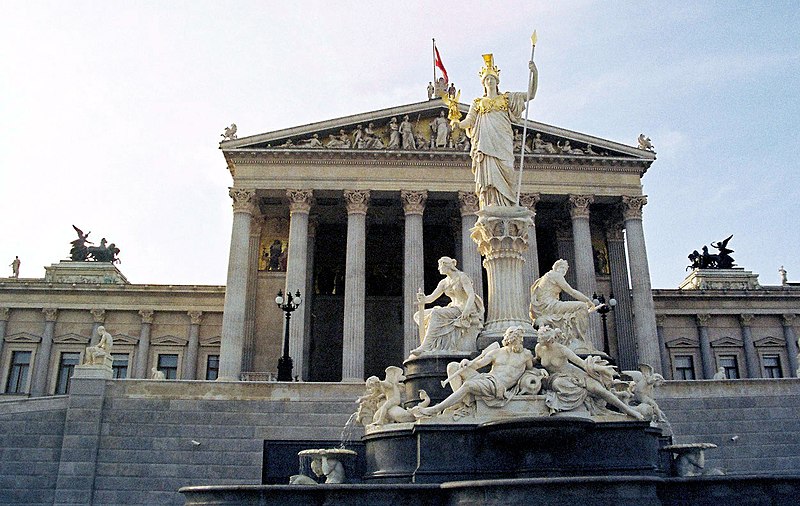
 |
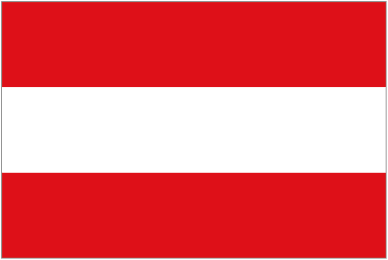 December 1, 2011 - "A second seminar on Fried is due to be held in the Austrian Parliament, Vienna (Austria), on Dec 1st, 2011." /// "There will be a panel discussion, with Jalka, Peter van den Dungen &
Walter Goehring, on why Nobel peace laureates are so quickly forgotten, on
the occasion of the Fried year." December 1, 2011 - "A second seminar on Fried is due to be held in the Austrian Parliament, Vienna (Austria), on Dec 1st, 2011." /// "There will be a panel discussion, with Jalka, Peter van den Dungen &
Walter Goehring, on why Nobel peace laureates are so quickly forgotten, on
the occasion of the Fried year."
|
 | T
R
E
E
S |  April 27, 2012 - "Berlin-Birkenau," Berlin (Germany). From Reuters: "Hundreds of birch trees from the biggest Nazi death camp, at
Auschwitz-Birkenau in Poland, are dotted around Berlin as a living
memorial of this dark chapter in Germany's past.
The trees, called Birke in German, lent their name to the Birkenau
camp where as many as 1.5 million people, mostly Jews, perished
between 1940 & 1945. The installation by Polish
artist Lukasz Surowiec, 26, is part of the [7th] Berlin Biennale, a
contemporary arts festival devoted this year to political art.
'This is an attempt to create a new kind of monument - a living
monument,' said Surowiec, who has had commemorative plaques erected in
front of the trees. 'With the help of nature, I try to continue a
generational mission of deepening the memory of the victims of the
Holocaust.' My project is effectively based on giving back the
"inheritance" to its owners.'" April 27, 2012 - "Berlin-Birkenau," Berlin (Germany). From Reuters: "Hundreds of birch trees from the biggest Nazi death camp, at
Auschwitz-Birkenau in Poland, are dotted around Berlin as a living
memorial of this dark chapter in Germany's past.
The trees, called Birke in German, lent their name to the Birkenau
camp where as many as 1.5 million people, mostly Jews, perished
between 1940 & 1945. The installation by Polish
artist Lukasz Surowiec, 26, is part of the [7th] Berlin Biennale, a
contemporary arts festival devoted this year to political art.
'This is an attempt to create a new kind of monument - a living
monument,' said Surowiec, who has had commemorative plaques erected in
front of the trees. 'With the help of nature, I try to continue a
generational mission of deepening the memory of the victims of the
Holocaust.' My project is effectively based on giving back the
"inheritance" to its owners.'" 
|



|  April 27-June 15, 2012 -
"Peace Wall," southern part of Friedrichstraße, Berlin (Germany). "Artist Nada Prlja [from Macedonia] has agreed to dismantle her artwork on June 15, 2012. The 'Peace Wall' – 12 meters wide & 5 meters high –
crosses both lanes of the road. The artistic work realized in the framework of the 7th Berlin
Biennale for Contemporary Art points at social inequalities in the quarter of Südliche
Friedrichstadt as well as at economic & political processes in this urban redevelopment
area. The 'Peace Wall' creates the opportunities for the residents to actively take part in the
processes in their district. This is how the curators of the 7th Berlin Biennale & the artist
see the role of art: to act in society, to engage in the public realm, to assist on-going social
processes.
Originally, the artwork was planned to be dismantled after the end of the 7th Berlin Biennale
on July 1, 2012. An application of urgency to dismantle the wall earlier was rejected by the
district council of Friedrichshain-Kreuzberg on May 23, 2012.
During the last days, the artwork has been violently attacked. Furthermore, the artist has
been attacked verbally.
That the reactions have been directed against the temporary artwork and the artist in such an
unanticipated degree, indicates to the dimension of local disappointment and indignation –
appearently the wall has become a surrogate of the very conditions it criticizes...." April 27-June 15, 2012 -
"Peace Wall," southern part of Friedrichstraße, Berlin (Germany). "Artist Nada Prlja [from Macedonia] has agreed to dismantle her artwork on June 15, 2012. The 'Peace Wall' – 12 meters wide & 5 meters high –
crosses both lanes of the road. The artistic work realized in the framework of the 7th Berlin
Biennale for Contemporary Art points at social inequalities in the quarter of Südliche
Friedrichstadt as well as at economic & political processes in this urban redevelopment
area. The 'Peace Wall' creates the opportunities for the residents to actively take part in the
processes in their district. This is how the curators of the 7th Berlin Biennale & the artist
see the role of art: to act in society, to engage in the public realm, to assist on-going social
processes.
Originally, the artwork was planned to be dismantled after the end of the 7th Berlin Biennale
on July 1, 2012. An application of urgency to dismantle the wall earlier was rejected by the
district council of Friedrichshain-Kreuzberg on May 23, 2012.
During the last days, the artwork has been violently attacked. Furthermore, the artist has
been attacked verbally.
That the reactions have been directed against the temporary artwork and the artist in such an
unanticipated degree, indicates to the dimension of local disappointment and indignation –
appearently the wall has become a surrogate of the very conditions it criticizes...."
|
 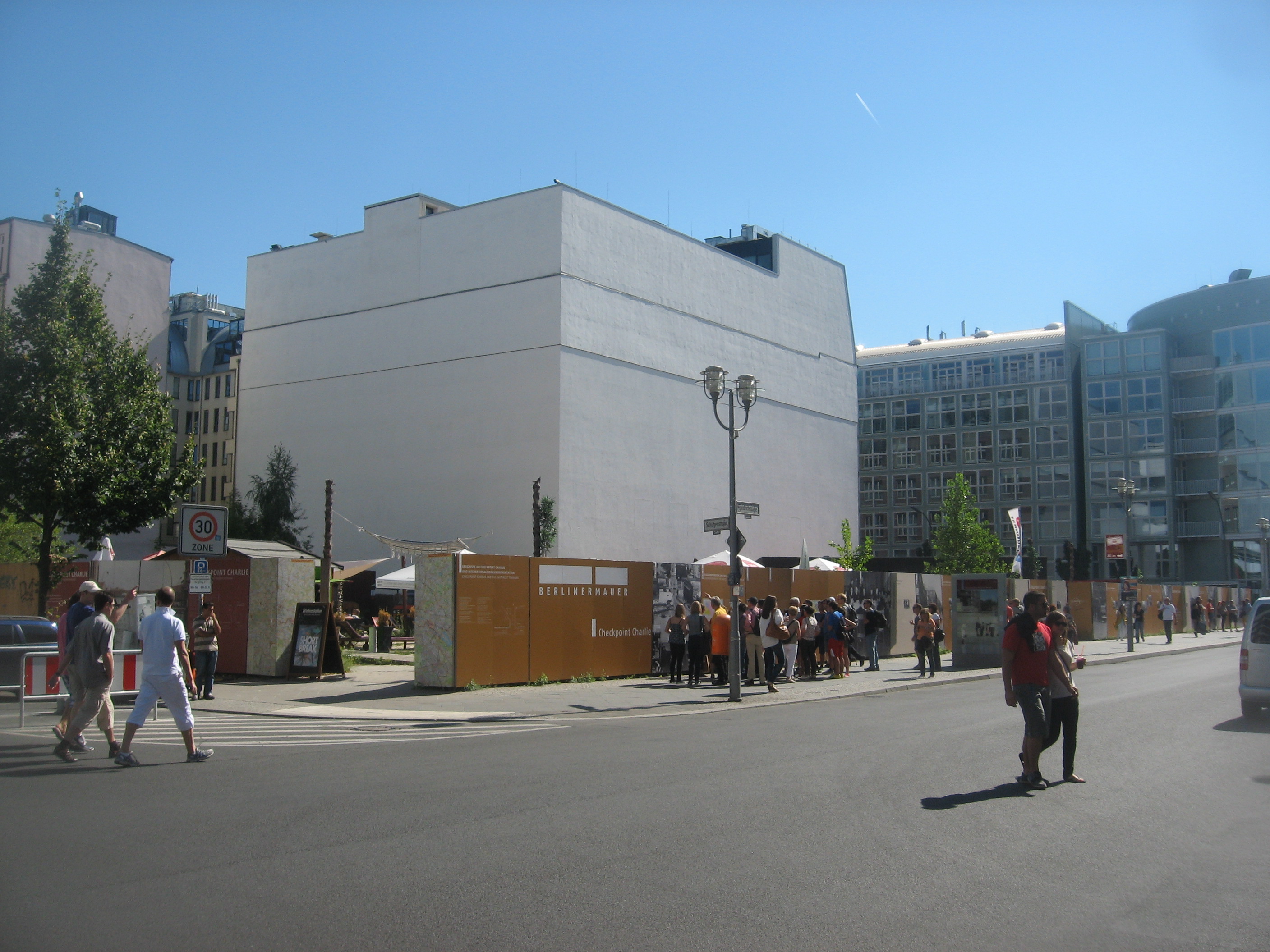

|  September 20, 2012 - BlackBox Cold War, Checkpoint Gallery, Brunnenstraße 188-190,
10119 Berlin (Germany). This is independent from the private Museum Haus am Checkpoint Charlie (qv). "The exhibition at Checkpoint Charlie discusses the state of the world during the Cold War, explaining the global links between the Berlin Wall, the Korean War and the Cuban missile crisis. Along the street a free gallery of photos and texts highlights the main events that took place here.
Admission €5/3,50." /// "An exhibition space of more than 200 m² (2,160 ft²). Provides extensive information on the history of the Cold War. Using large-format photos and numerous media stations, explores the impact of the Wall on German history. Also makes the overall international dimension of the division of Germany and Europe tangible. The external design of the division relates to the two Great Powers – the Soviet Union & the USA. The black colour of the external façade stands for the black box itself – the flight recorder capturing what happened for posterity. The red colour of the pillar stands for the Soviet Union and the blue window for the USA. It is planned to create a Cold War Museum on this site by 2015. /// Information courtesy of Christian Bartolf. /// Right image by EWL 6 Sept 2013. Comment: When visited 7 Sept 2013, this site was surrounded by temporary food & souvenir stands. I could not find an entrance & concluded that the "Black Box" is not yet open to the public. A construction fence along Friedrichstraße contained large photos & other information about the Checkpoint Charlie area & its history. September 20, 2012 - BlackBox Cold War, Checkpoint Gallery, Brunnenstraße 188-190,
10119 Berlin (Germany). This is independent from the private Museum Haus am Checkpoint Charlie (qv). "The exhibition at Checkpoint Charlie discusses the state of the world during the Cold War, explaining the global links between the Berlin Wall, the Korean War and the Cuban missile crisis. Along the street a free gallery of photos and texts highlights the main events that took place here.
Admission €5/3,50." /// "An exhibition space of more than 200 m² (2,160 ft²). Provides extensive information on the history of the Cold War. Using large-format photos and numerous media stations, explores the impact of the Wall on German history. Also makes the overall international dimension of the division of Germany and Europe tangible. The external design of the division relates to the two Great Powers – the Soviet Union & the USA. The black colour of the external façade stands for the black box itself – the flight recorder capturing what happened for posterity. The red colour of the pillar stands for the Soviet Union and the blue window for the USA. It is planned to create a Cold War Museum on this site by 2015. /// Information courtesy of Christian Bartolf. /// Right image by EWL 6 Sept 2013. Comment: When visited 7 Sept 2013, this site was surrounded by temporary food & souvenir stands. I could not find an entrance & concluded that the "Black Box" is not yet open to the public. A construction fence along Friedrichstraße contained large photos & other information about the Checkpoint Charlie area & its history.
|

|  September 22, 2012 - "Daily life on both sides of the Wall," Berlin (Germany).
Huge painting at Checkpoint Charlie by Berlin artist Yadegar Asisi. "The 15 metre (50 ft) high cylindrical steel rotunda Wall Panorama shows life along the wall near the central Engelbecken (Angel’s Basin) between the districts of Kreuzberg (West Berlin) & that of Berlin-Mitte (East Berlin). Will be on display until a date in 2014. Shows a panorama of daily life on both sides of the Berlin Wall on a fictitious autumn day in the 1980's. You see not only East German soldiers on border patrol but also graffiti artists, children playing & drunks at a curry wurst stand. Asisi is also integrating audio sequences & the voices of contemporary witnesses to complement the visual representation." /// Information courtesy of Christian Bartolf. /// Visited 7 Sept 2013. September 22, 2012 - "Daily life on both sides of the Wall," Berlin (Germany).
Huge painting at Checkpoint Charlie by Berlin artist Yadegar Asisi. "The 15 metre (50 ft) high cylindrical steel rotunda Wall Panorama shows life along the wall near the central Engelbecken (Angel’s Basin) between the districts of Kreuzberg (West Berlin) & that of Berlin-Mitte (East Berlin). Will be on display until a date in 2014. Shows a panorama of daily life on both sides of the Berlin Wall on a fictitious autumn day in the 1980's. You see not only East German soldiers on border patrol but also graffiti artists, children playing & drunks at a curry wurst stand. Asisi is also integrating audio sequences & the voices of contemporary witnesses to complement the visual representation." /// Information courtesy of Christian Bartolf. /// Visited 7 Sept 2013.
|

|  October 24, 2012 - defaced in 2015 - Memorial to the Sinti & Roma Victims of National Socialism, Simsonweg, Tiergarten (across from the Reichstag), Berlin (Germany). Designed by Israeli artist Dani Karavan. Consists of a dark, circular pool of water at the centre of which there is a triangular stone. /// "...defaced on Thursday morning [29 October 2015] with a spray-painted swastika & a neo-Nazi message, 'Gas them,' according to the foundation that runs the memorial... The paint was quickly removed, security was tightened, and the German federal police have opened a criminal investigation, according to Uwe Neumärker, the director of the foundation that runs the memorial, which honors hundreds of thousands of people in the Sinti & Roma communities (often referred to as Gypsies) who were killed during World War II. As refugees continue to pour into Germany, officials have expressed concern about right-wing violence against ethnic minorities." /// The memorial was expected to be inaugurated in 2009 but delayed during a controversy between the artist & German government as the awarding authority. WATER HOLOCAUST VANDALS 2012 October 24, 2012 - defaced in 2015 - Memorial to the Sinti & Roma Victims of National Socialism, Simsonweg, Tiergarten (across from the Reichstag), Berlin (Germany). Designed by Israeli artist Dani Karavan. Consists of a dark, circular pool of water at the centre of which there is a triangular stone. /// "...defaced on Thursday morning [29 October 2015] with a spray-painted swastika & a neo-Nazi message, 'Gas them,' according to the foundation that runs the memorial... The paint was quickly removed, security was tightened, and the German federal police have opened a criminal investigation, according to Uwe Neumärker, the director of the foundation that runs the memorial, which honors hundreds of thousands of people in the Sinti & Roma communities (often referred to as Gypsies) who were killed during World War II. As refugees continue to pour into Germany, officials have expressed concern about right-wing violence against ethnic minorities." /// The memorial was expected to be inaugurated in 2009 but delayed during a controversy between the artist & German government as the awarding authority. WATER HOLOCAUST VANDALS 2012
|
 |  September 2013? -
Mosaic Peace Wall, Mitte district, Berlin (Germany). "CITYarts’ 5th global Peace Wall. On the 'Street of Tolerance' because of its proximity to the Old Jewish Cemetery, a landmark Protestant church, an historic Catholic hospital & the Jewish School. In a city once known primarily for being divided, the Peace Wall at a site of such historic & emotional importance will be a significant contribution to both memory & community. This wall will connect - not divide - and it will celebrate the peaceful future that can be realized through the engagement of tomorrow’s leaders, while adding further to a site of remembrance & learning. Created by students & volunteers from diverse EU countries & communities.
CITYarts will be joined by the Third Generation Initiative, a roup of 30 young American, Israeli and German professionals supported by Allianz. September 2013? -
Mosaic Peace Wall, Mitte district, Berlin (Germany). "CITYarts’ 5th global Peace Wall. On the 'Street of Tolerance' because of its proximity to the Old Jewish Cemetery, a landmark Protestant church, an historic Catholic hospital & the Jewish School. In a city once known primarily for being divided, the Peace Wall at a site of such historic & emotional importance will be a significant contribution to both memory & community. This wall will connect - not divide - and it will celebrate the peaceful future that can be realized through the engagement of tomorrow’s leaders, while adding further to a site of remembrance & learning. Created by students & volunteers from diverse EU countries & communities.
CITYarts will be joined by the Third Generation Initiative, a roup of 30 young American, Israeli and German professionals supported by Allianz.
|
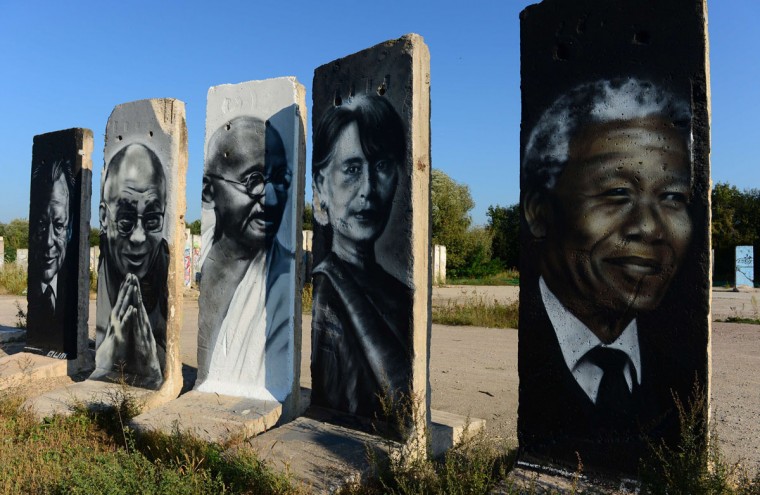
|  2014? - Portions of the Berlin Wall, Teltow, Berlin (Germany). "Cement slabs that used to make up the Berlin wall are painted with the portraits of (L to R) German politician Willy Brandt, Tibet’s exiled spiritual leader Dalai Lama, leader of Indian independence movement Mahatma Gandhi, Burmese opposition politician Aung San Suu Kyi & South African anti-apartheid revolutionary Nelson Mandela stand in a vacant lot in Teltow outside of Berlin on September 18, 2014. A construction company purchased parts of the wall & offers the possibility to paint them legally after applying for it [sic]." 2014? - Portions of the Berlin Wall, Teltow, Berlin (Germany). "Cement slabs that used to make up the Berlin wall are painted with the portraits of (L to R) German politician Willy Brandt, Tibet’s exiled spiritual leader Dalai Lama, leader of Indian independence movement Mahatma Gandhi, Burmese opposition politician Aung San Suu Kyi & South African anti-apartheid revolutionary Nelson Mandela stand in a vacant lot in Teltow outside of Berlin on September 18, 2014. A construction company purchased parts of the wall & offers the possibility to paint them legally after applying for it [sic]."
|
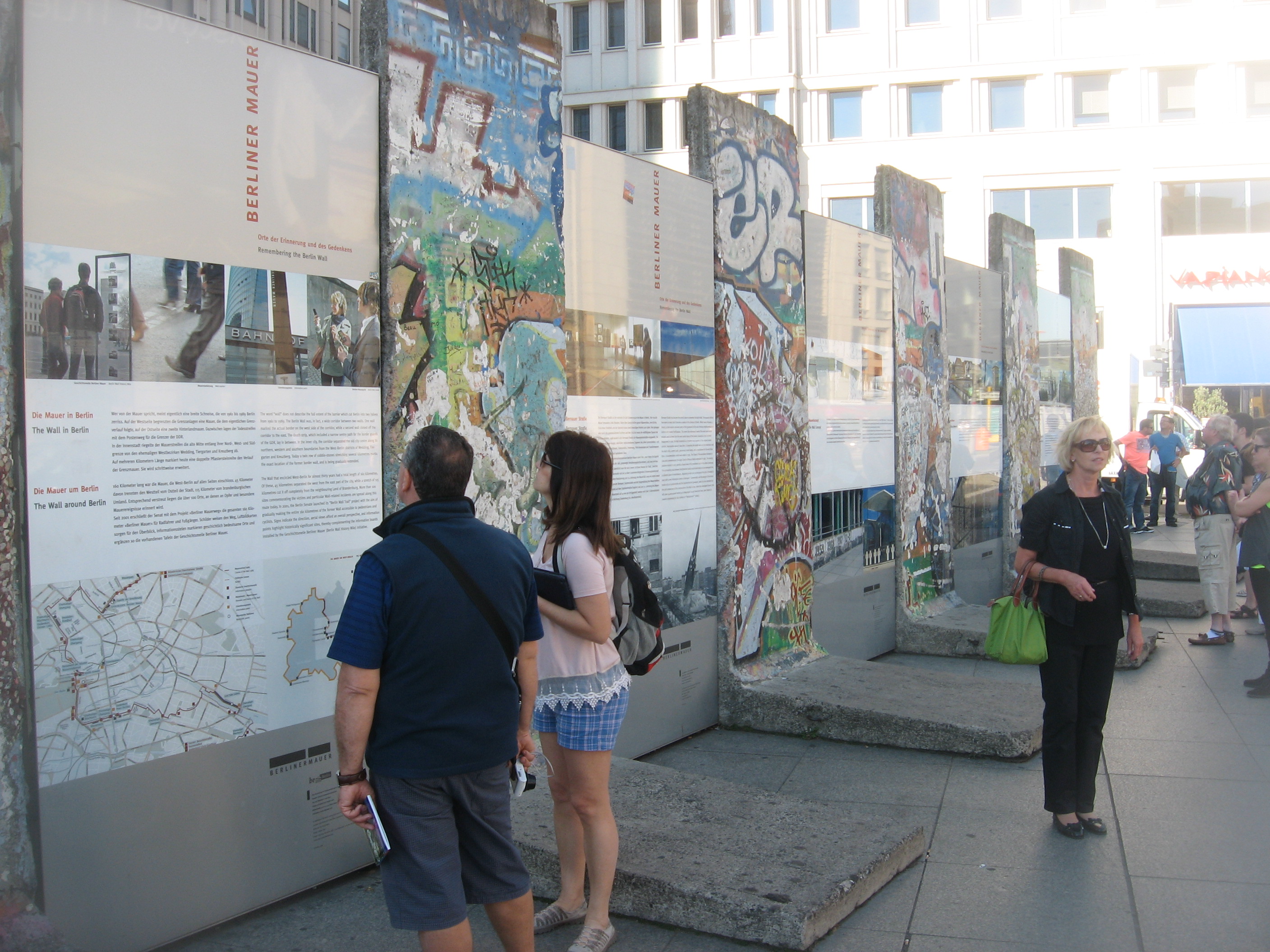 

|  Date? - Berlin Wall Exhibit, Potsdamer Platz, Berlin (Germany). On high foot-traffic sidewalk among tall new buildings, including Deutsche Bahn (DB) headquarters. The Wall divided Potsdamer Platz, and the area has grown expotentially since reunification. Left image by EWL 7 Sept 2013. Date? - Berlin Wall Exhibit, Potsdamer Platz, Berlin (Germany). On high foot-traffic sidewalk among tall new buildings, including Deutsche Bahn (DB) headquarters. The Wall divided Potsdamer Platz, and the area has grown expotentially since reunification. Left image by EWL 7 Sept 2013.
|

|  September 2, 2014 - Operation T4 Monument, Tiergartenstrasse 4 ("T4"), Berlin (Germany). "A 79-foot-long wall of blue tinted glass at the site where dozens of doctors plotted & carried out the killings of patients arranged through medical channels under a program known as 'Operation T4.' Before the program was halted in 1941, some 70,000 people had been killed in the first gas chambers at six sites across Germany. The Nazis’ early success paved the way for mass slaughter that would later be carried out on an even larger scale against Jews, Roma and others in the death camps. /// In a country where commemoration of past crimes holds such a prominent place in the national debate that it can seem to border on obsession, some see adding a fourth major memorial to Holocaust victims in Berlin — there is already a monument to the Murdered Jews of Europe between Potsdamer Platz & the Brandenburg Gate, and in the city’s Central Park, the Tiergarten, one honors the Sinti and Roma, and a second pays tribute to deported gays — as excessive.
But for those families whose relatives were singled out for death because doctors said they could not contribute to the Nazi war machine, the newest monument rights two wrongs: the crimes committed against the ill and defenseless, and the long postwar silence about their slaughter. Few of the doctors involved in the operation were convicted, and families have never been eligible for any form of postwar compensation. ///
For years, the site at Tiergartenstrasse 4 was a bus stop, with only a plaque testifying to the suffering plotted there." /// Image photo was taken through the wall of blue glass. September 2, 2014 - Operation T4 Monument, Tiergartenstrasse 4 ("T4"), Berlin (Germany). "A 79-foot-long wall of blue tinted glass at the site where dozens of doctors plotted & carried out the killings of patients arranged through medical channels under a program known as 'Operation T4.' Before the program was halted in 1941, some 70,000 people had been killed in the first gas chambers at six sites across Germany. The Nazis’ early success paved the way for mass slaughter that would later be carried out on an even larger scale against Jews, Roma and others in the death camps. /// In a country where commemoration of past crimes holds such a prominent place in the national debate that it can seem to border on obsession, some see adding a fourth major memorial to Holocaust victims in Berlin — there is already a monument to the Murdered Jews of Europe between Potsdamer Platz & the Brandenburg Gate, and in the city’s Central Park, the Tiergarten, one honors the Sinti and Roma, and a second pays tribute to deported gays — as excessive.
But for those families whose relatives were singled out for death because doctors said they could not contribute to the Nazi war machine, the newest monument rights two wrongs: the crimes committed against the ill and defenseless, and the long postwar silence about their slaughter. Few of the doctors involved in the operation were convicted, and families have never been eligible for any form of postwar compensation. ///
For years, the site at Tiergartenstrasse 4 was a bus stop, with only a plaque testifying to the suffering plotted there." /// Image photo was taken through the wall of blue glass.
|
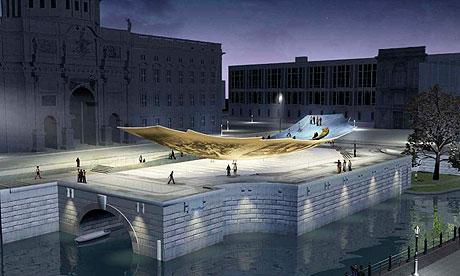 |  Future - "Citizens in Motion," Berlin (Germany).
"After more than a decade of disagreement, Berliners have settled on a monument to celebrate German reunification and the 1989 peaceful revolution: a giant, rocking dish.
The 55-metre, 330-tonne glittering steel wing can hold up to 1,400 people at any one time, but it needs at least 20 people to get it moving.
The monument to unity is called Citizens in Motion, and is apparently all about people coming together. If you want to make it move, you have to get a group together and all go in a particular direction.
"That's what a peaceful revolution is about," said Johannes Milla, the Stuttgart architect who collaborated with Berlin's star choreographer, Sasha Waltz, on the unique design.
"The rest of the world's monuments are built to be looked at," said Milla. "With this concept, it's the people who'll make it into something.
"Maybe they'll use it for theatre, or like Speaker's Corner, or skaters will use it. The people will make it their own."
The asphalt bed of the monument will carry the slogans of the 1989 demonstrations: "Wir sind das Volk" (We are the people) and "Wir sind ein Volk" (We are one people).
Engravings on its steel belly will depict images of the revolution. It took 12 years and two public bids before Germany's culture minister finally approved the ¤10m (£8.76m) project, expected to take two to three years to build.
The monument's home will be an east Berlin square in front of the soon to be reconstructed Berlin Palace, formerly home to the Prussian rulers, and demolished by the German Democratic Republic's communist regime.
The square was also the site of the former GDR parliament, and 1 million people held a peaceful demonstration there just months before the fall of the wall.
Critics call it a gimmick, more like a playground for grown-ups than a sincere monument to history. Future - "Citizens in Motion," Berlin (Germany).
"After more than a decade of disagreement, Berliners have settled on a monument to celebrate German reunification and the 1989 peaceful revolution: a giant, rocking dish.
The 55-metre, 330-tonne glittering steel wing can hold up to 1,400 people at any one time, but it needs at least 20 people to get it moving.
The monument to unity is called Citizens in Motion, and is apparently all about people coming together. If you want to make it move, you have to get a group together and all go in a particular direction.
"That's what a peaceful revolution is about," said Johannes Milla, the Stuttgart architect who collaborated with Berlin's star choreographer, Sasha Waltz, on the unique design.
"The rest of the world's monuments are built to be looked at," said Milla. "With this concept, it's the people who'll make it into something.
"Maybe they'll use it for theatre, or like Speaker's Corner, or skaters will use it. The people will make it their own."
The asphalt bed of the monument will carry the slogans of the 1989 demonstrations: "Wir sind das Volk" (We are the people) and "Wir sind ein Volk" (We are one people).
Engravings on its steel belly will depict images of the revolution. It took 12 years and two public bids before Germany's culture minister finally approved the ¤10m (£8.76m) project, expected to take two to three years to build.
The monument's home will be an east Berlin square in front of the soon to be reconstructed Berlin Palace, formerly home to the Prussian rulers, and demolished by the German Democratic Republic's communist regime.
The square was also the site of the former GDR parliament, and 1 million people held a peaceful demonstration there just months before the fall of the wall.
Critics call it a gimmick, more like a playground for grown-ups than a sincere monument to history.
|
Note about the East Side Gallery
"East Side Gallery artists sue over Berlin Wall restoration."
Published: 3 May 11 15:38 CET
Online: http://www.thelocal.de/society/20110503-34773.html
"In the latest chapter of a controversy over the restoration of the Berlin Wall’s famed East Side Gallery, several artists are demanding compensation from the city because they say their artwork was removed, painted over or reproduced without their consent.
* Man throws firecracker at crying child (3 May 11)
* Pub smoking still widespread despite ban (3 May 11)
* German recycling system gets an overhaul (3 May 11)
The 1.3-kilometer section of the Wall, painted by artists as a monument to peace in 1990, progressively crumbled after Germany’s re-unification until restorations commenced in 2000.
In many cases, artists were asked to repaint their work because a sandblasting process removed them during the restoration. But many angrily refused. Some argued they hadn’t been given an adequate share of the revenue the monument has brought in. Others said repainting the works destroyed the wall’s authenticity.
Artist Bodo Sperling is one of those filing suit because he says his work, “The transformation of the pentagram to a peace star in a Europe without walls,” was removed and repainted without his consent, the Berliner Morgenpost reported on Tuesday.
His attorney, Hannes Hartung told the paper that he is demanding at least €20,000.
“We want to leave the amount at the discretion of the court, however,” he said.
Hartung said at least two other artists had their works unnecessarily removed and then repainted and he is demanding €3,000 for each of them.
The lawyer said they should have been handled more carefully, “Like frescoes,” he said, explaining that he had previously demanded compensation but had been refused.
Other artists have repainted their works, but only grudgingly.
In 2009, Russian artist Dmitry Vrubel said he was stunned that his “Brother Kiss” mural had been erased. As he redid the work, he said he was “a little bit afraid” because he couldn’t remember all the details of his mural exactly.
Note about mahnmal & denkmal
"Before WW-II there were no warning monuments [mahnmal] in Germany. Instead there were war memorials [denkmal], to fallen soldiers dying, like marble Christs, for the fatherland. The bonds of national community were strengthened through therir sacrifice. War, in Great War monuments, is a mystical experience, a Calvary of valor, sacrifice, and regeneration. Great Gothic memorial fortresses were built in the German Reich to pluck honor from defeat. Nothing like this emerged after WW-II. Insted, the Germans built monuments not to glorify but to warn; Denkmal became Mahnmal. /// Like a monumental rosary, spread mostly over western Germany, the monuments testify to a fretting over memory, a neutotic fear of amnesia, an obsession with casting the past in stone. It was not always like this. In the late 1940s and 1950s, the compulsion to forget was stronger. Reminders of the past -- not just Hitler's past -- were destroyed, blown up, removed. Sites of concentration camps were used for some time to house German prisoners, by Soviets and Western Allies alike, but as soon as was possible they were either razed or abandoned. What physically remained of the Third Reich was left out of apathy or force majeure, as in the case of Speer's indestructible Nuremberg stadium, or for political reasons, as was usually the case in East Germany. The warning monuments [mahnmal] and memorial places (Gedenkstatte) are mostly products of the reaction, which set in during the 1960s, propelled by the postwar generation, as eager to warn and remember as their parents were to forget." [Ian Buruma (1994), "The Wages of Guilt," pp. 203-4.]
Please email your comments & questions to geovisual at comcast.net. Thank you.
Return to Peace Monuments main page.

























![]() January 30, 1933 - Adolf Hitler [1889-1945] named Chancellor of Germany.
January 30, 1933 - Adolf Hitler [1889-1945] named Chancellor of Germany.


![]() November 19-10, 1938 - Krystalnacht / "Night of Broken Glass."
November 19-10, 1938 - Krystalnacht / "Night of Broken Glass."
![]() January 20, 1942 - Wannsee Conference at which Reinhard Heydrich [1804-1942] announced Hitler's decision to murder the Jews of Europe.
January 20, 1942 - Wannsee Conference at which Reinhard Heydrich [1804-1942] announced Hitler's decision to murder the Jews of Europe.
![]() April 30, 1945 - Death of Adolf Hitler [1889-1945] in Berlin.
April 30, 1945 - Death of Adolf Hitler [1889-1945] in Berlin.




June 24, 1948-May 12, 1949 - Berlin Blockade & Airlift. (39 British & 31 American airmen lost their lives during the airlift.)
May 23, 1949 - Federal Republic of Germany (FRG) formed from American, British & French zones. (Had its seat of government & de facto capital in Bonn, although Berlin was symbolically named as the de jure capital.)
![]() Date?, 1949 - German Democratic Republic (GDR) formed from Soviet zone. (Had its capital in Berlin.)
Date?, 1949 - German Democratic Republic (GDR) formed from Soviet zone. (Had its capital in Berlin.) ![]()










![]() June 4-November 9, 1961 - Berlin Crisis. (USSR demands withdrawal of Western armed forces culminating with erection of the Berlin Wall.)
June 4-November 9, 1961 - Berlin Crisis. (USSR demands withdrawal of Western armed forces culminating with erection of the Berlin Wall.)![]() August 13, 1961-November 9, 1989 - Berliner Mauer / Berlin Wall. (First concrete elements & large blocks put in place on 17 August. Additionally, chain fences, walls, minefields, other obstacles & a no man's land were installed along the length of East Germany's western border with West Germany proper.)
August 13, 1961-November 9, 1989 - Berliner Mauer / Berlin Wall. (First concrete elements & large blocks put in place on 17 August. Additionally, chain fences, walls, minefields, other obstacles & a no man's land were installed along the length of East Germany's western border with West Germany proper.)




























November 9, 1989 - Fall of the Berliner Mauer / Berlin Wall.




October 3, 1990 - Reunification of Germany. (Tag der deutschen Einheit / Day of National Unity, official German national holiday.)

































Global Stone Project, Tiergarten Park, Berlin (Germany). Near the Goethe Denkmal & the Löwengruppe / Lions’ Group in the SE corner of Tiergarten park. Five stones, each weighing between 10 and 40 tons and corresponding to a “sister stone” on one of the five continents. The pairs of stones represent the five steps towards peace. Once a year on 21st June the light of the sun connects all ten [sic] stones by reflection. Wolfgang von Schwarzenfeld, sculptor & around the world navigator, began the Global Stone Project in 1997 in Venezuela.
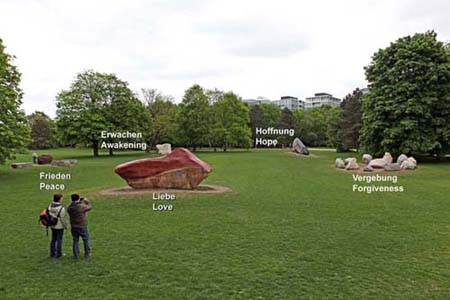
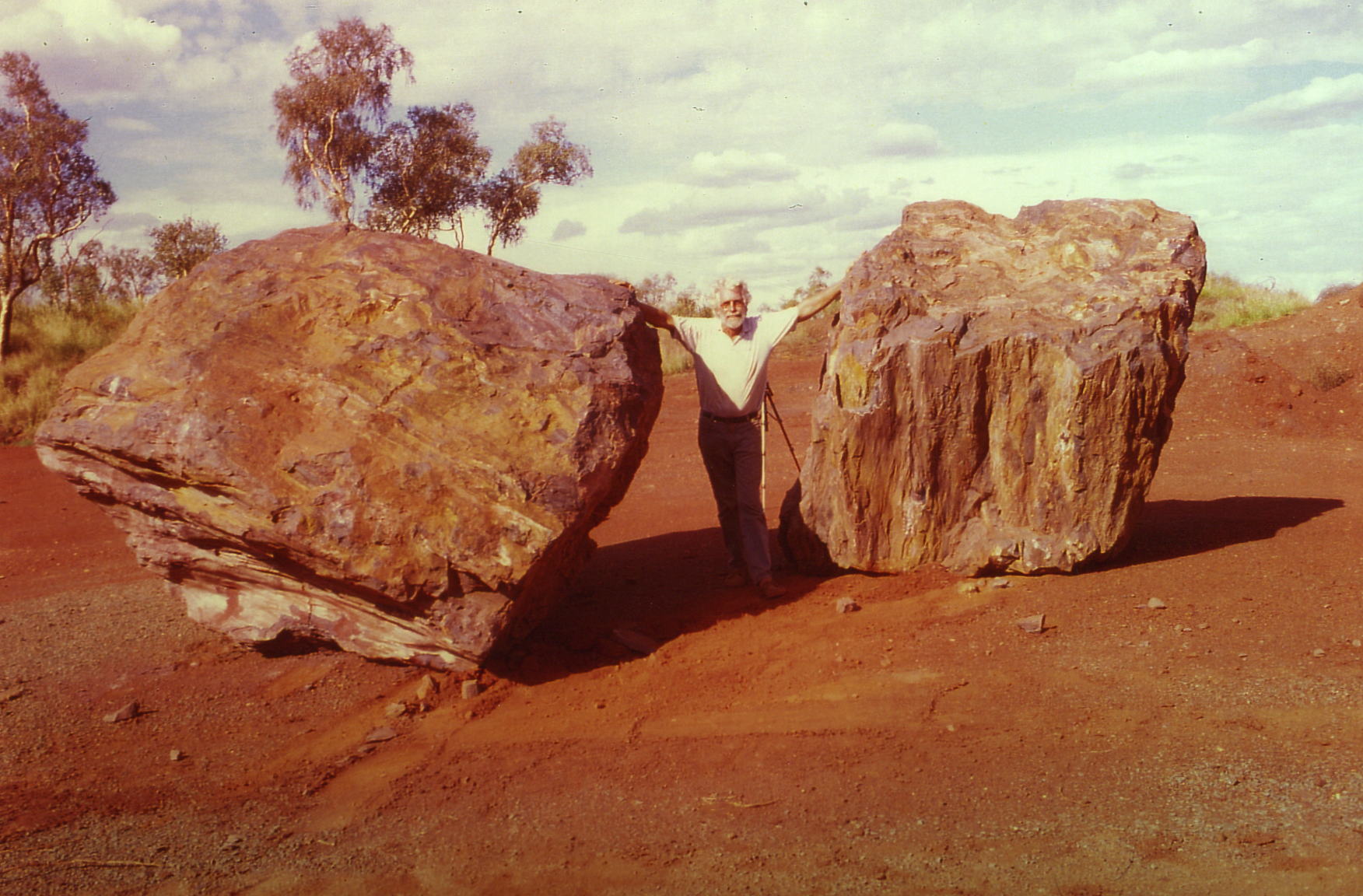 January 4, 2001 - Australia (Frieden/Peace).
2nd of 5 stones. From Mount Magnet sheep station (Australia).
January 4, 2001 - Australia (Frieden/Peace).
2nd of 5 stones. From Mount Magnet sheep station (Australia). 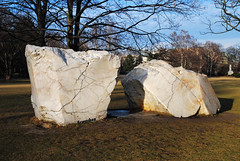 April 25, 2007 - Europe (Erwachen/Awakening).
3rd of 5 stones. From Ekaterinen (Russia).
April 25, 2007 - Europe (Erwachen/Awakening).
3rd of 5 stones. From Ekaterinen (Russia). 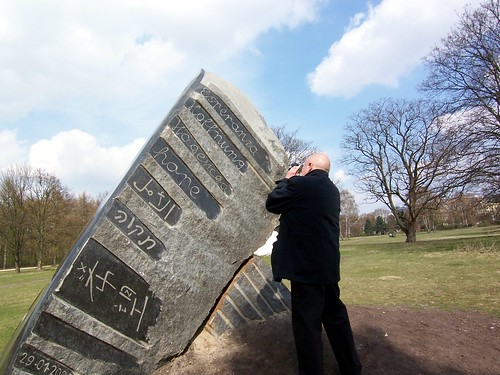 December 3, 2007 - Africa (Hoffnung/Hope).
4th of 5 stones. From Bertanie Quarry (South Africa). Placed by Archbishop Desmond Tutu.
December 3, 2007 - Africa (Hoffnung/Hope).
4th of 5 stones. From Bertanie Quarry (South Africa). Placed by Archbishop Desmond Tutu.  Date? - Asia (Vergebung/Forgiveness).
5th of 5 stones. From where?
Date? - Asia (Vergebung/Forgiveness).
5th of 5 stones. From where?
